THE HALO AROUND THE HEAD OF THE MAN ON THE SHROUD
By DR. PETRUS SOONS
Is this the proof that the EDESSA Cloth (Tetradiplon, Mandylion) and the Shroud of Turin are identical?
ABSTRACT: The discovery of a HALO around the head of the Man on the Shroud of Turin in different photographs and two other details in the neck area under the beard are a strong indication that the theory of historian IAN WILSON, that the Cloth of EDESSA and the Shroud of Turin are one and the same, is most probably correct. These details are being found also regularly in icons and mosaics portraying the face of Jesus Christ in the Byzantine Empire as of the VI-th Century A.D., showing that artists had access to the Cloth of EDESSA and copied very truthfully the details that they encountered. If true, it would date the Shroud back to the year 525 A.D., proving that the piece of cloth used in the radio-carbon dating of 1988 was probably not representative for the whole Shroud.
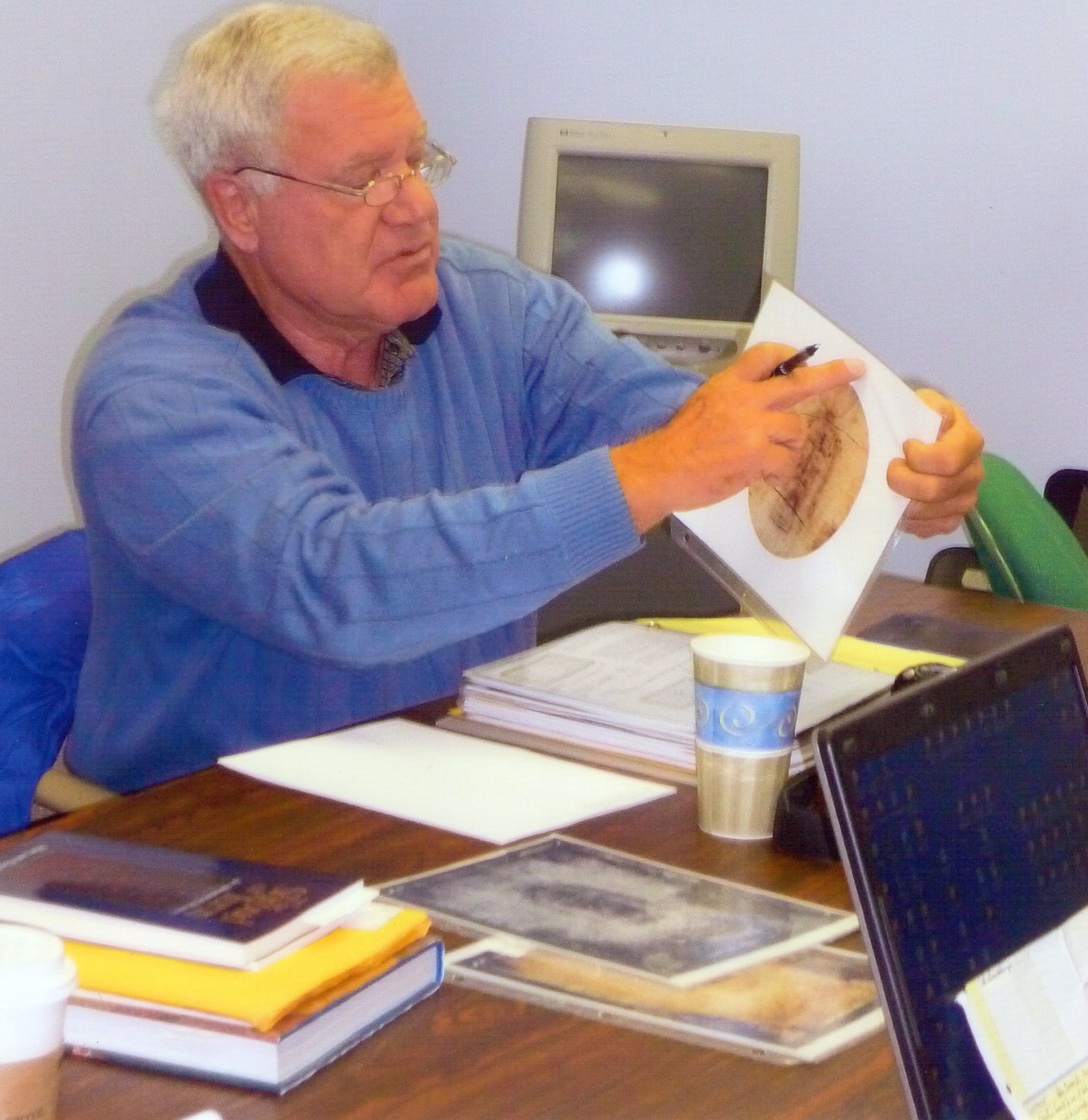
Photo 0. Dr. Soons showing HALO in Raleigh, N. C. 2008
1988: THE RADIO CARBON DATING OF THE SHROUD OF TURIN.A great difficulty for Sindonology was that in 1988 the credibility of the Shroud of Turin as a genuine two-thousand-year old burial cloth had been very seriously undermined by highly publicized radio carbon dating tests which had adjudged it to date between the years 1260 AD and 1390 AD. The piece of cloth that was cut to perform the tests, was divided in three and given to three different Laboratories and given that fact, you would expect that the three different dates would be almost the same, which was not the case, but varied from 1260 to 1390 AD. A team made up of 6 physicists, chemists and statiticians drafted a scientific review report which was subjected to peer review and then accepted and published in August 2020 in the international journal Entropy. The report is entitled “ STATISTICAL AND PROACTIVE ANALYSIS OF AN INTER-LABORATORY COMPARISON; THE RADIOCARBON DATING OF THE SHROUD OF TURIN “ and it concluded that there were statistical anomalies, in particular in the linear relationship between the position of the samples and their age which makes the average age calculated by the Laboratories of Oxford, Zurich and Arizona meaningless.(For a summary of this article see under ADDENDUM—” The Radiocarbon Dating of the Shroud “).
It is a fact that there are many indications that date the Shroud back to the first century AD.
INDICATIONS OF THE AUTHENTICITY OF THE SHROUD OF TURIN AS A 2000 YEAR OLD BURIAL CLOTH:
First of all there are the qualities of the image, that combined, make this image unique in the world.
1) The image has the quality of a photographic negative
2) The superficiality of the image on the upmost fibers of the Shroud
3) Distance information in the grayscale of the image, 3D information
4) The image is anatomically correct
5) Monochromatic coloration of the image
6) No adhesion of the fibers and no impregnation in the fibers
7) Real human blood in the wounds of the image
8) Serum separation of the post-mortem blood under UV lightning
9) No direccionality, the image was formed collimated
10)X-ray properties in the image
11)No outlines visible of the body image
12)Image formed by a chemical process, oxidation, dehydration and conjugation of the cellulose of the fibers.
OTHER INDICATIONS OF AUTHENTICITY:
1) RAY ROGERS proposed a different kind of dating for the linen, a process that uses microscopic spectrometric mass pyrolisis of the linen-vanillin-lignine proportions. He demonstrated that the Shroud could be between 1300 and 3000 years old.
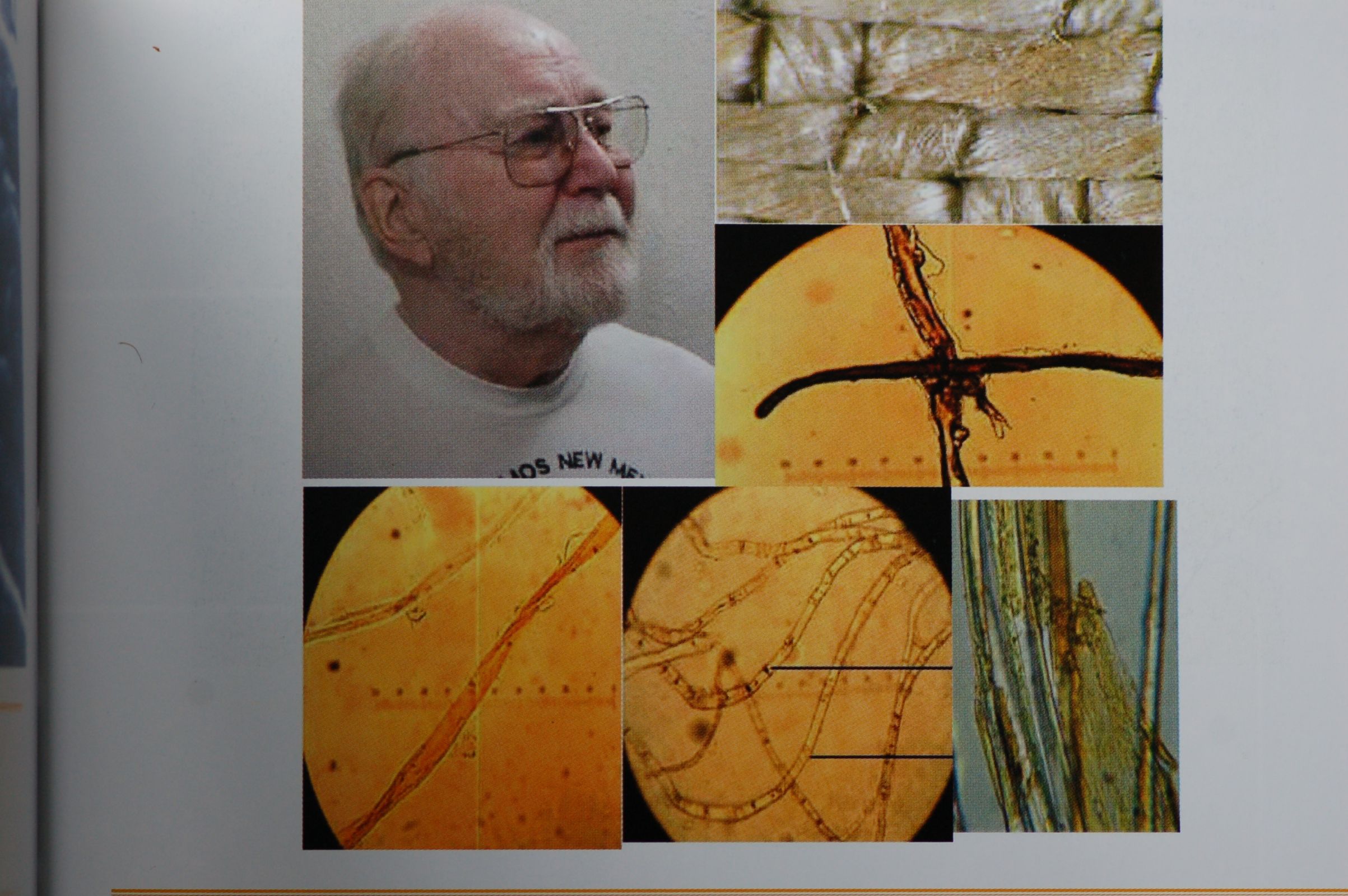
Photo 1. Ray Rogers vanilline dating
2) The HUNGARIAN PRAYER BOOK, that is dated between 1192 and 1195 AD and that shows a drawing with many of the details present in the Shroud, like the folding of the arms, the non-visibility of the thumbs, the herringbone weave of the Shroud and the inverted 3 bloodspot on the front of the head and also the so-called “pokerholes”.
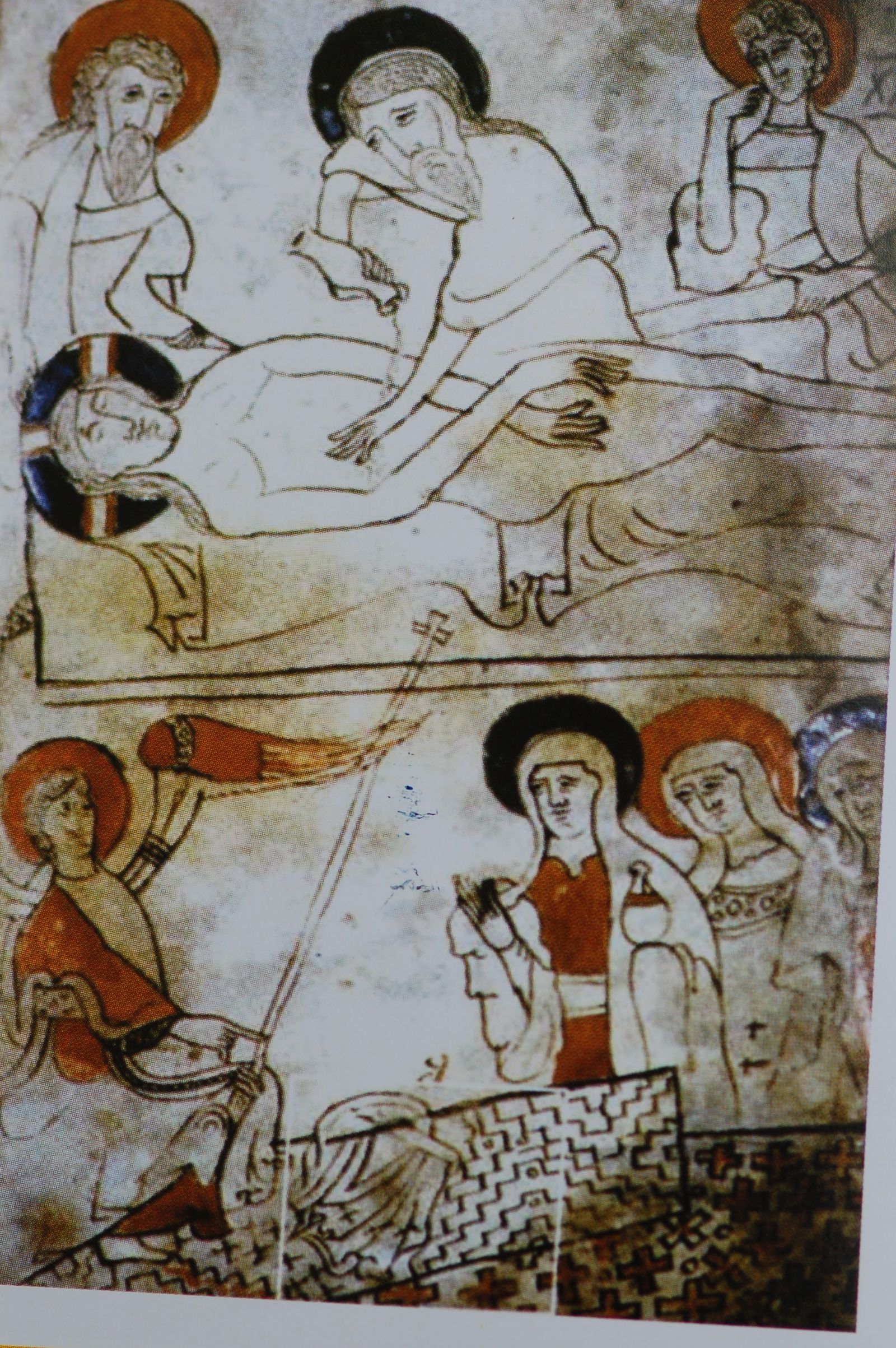
Photo 2. Hungarian Prayer Book
3) THE SUDARIUM OF OVIEDO. This cloth is mentioned in the Gospel of John as being in the tomb in Jerusalem and is presently in Oviedo, Spain. Scientifically spoken we know that it covered the same body as the Man on the Shroud of Turin. The history of this Sudarium is known as of the year 614 AD. (See ADDENDUM for the article of the SUDARIUM).
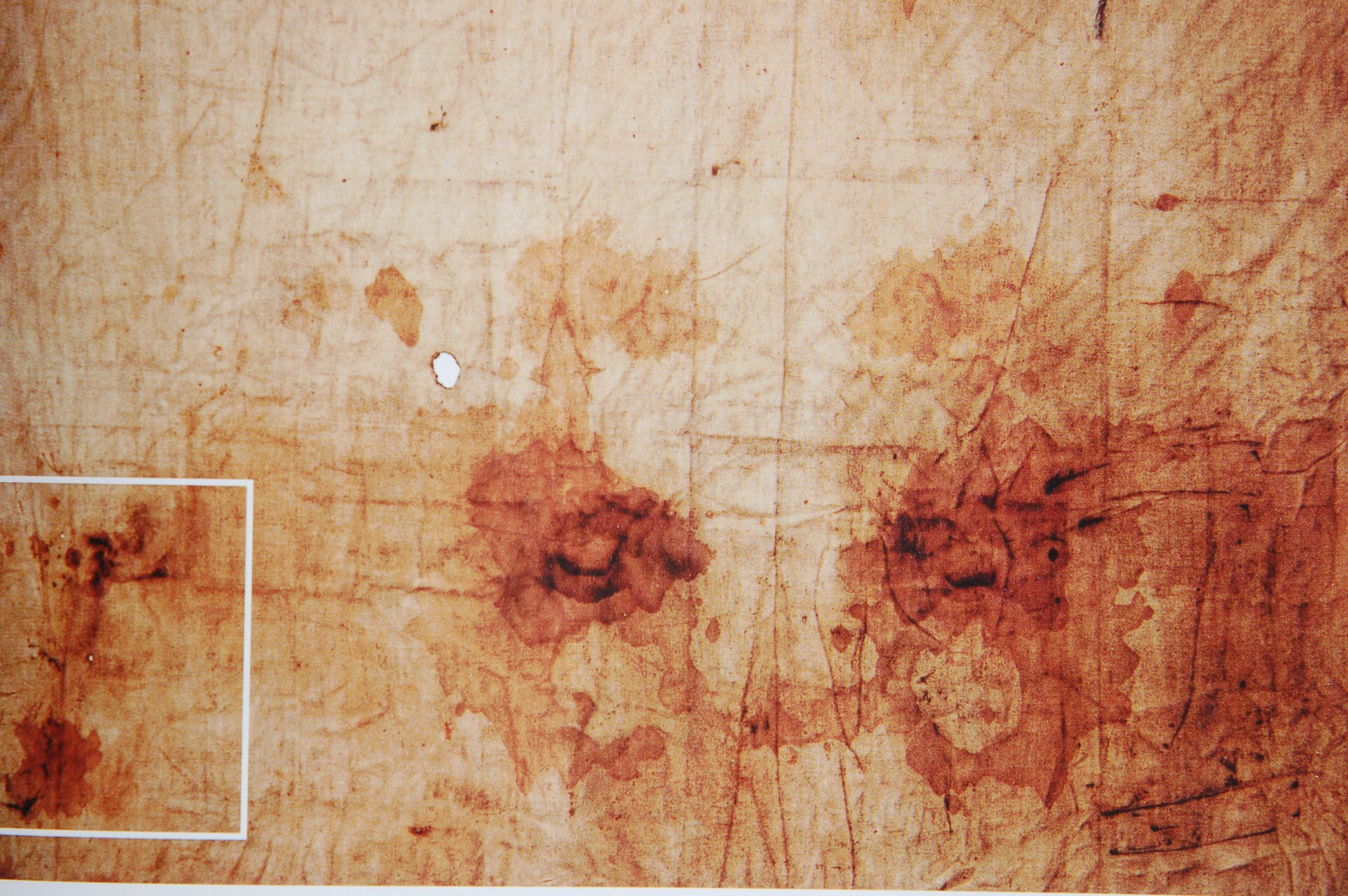
Photo 3 |
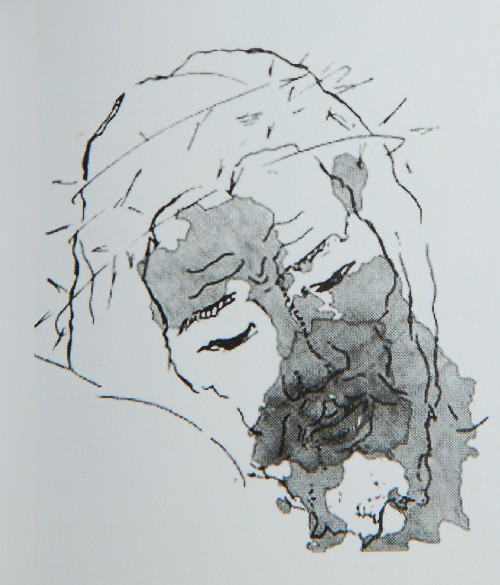
Photo 4 |
Sudarium of Oviedo
4) TEXTILE ARCHAEOLOGY: Mechtild Flury-Lemberg, a textile archaeologist from Switzerland, noted that the details of the stitching that joins the side-strip to the main fabric of the Shroud is the same as a peculiar type of stitching found in textiles in graves in the fortress of Masada from the first century AD. (Destroyed by the Romans in 71 A.D.)
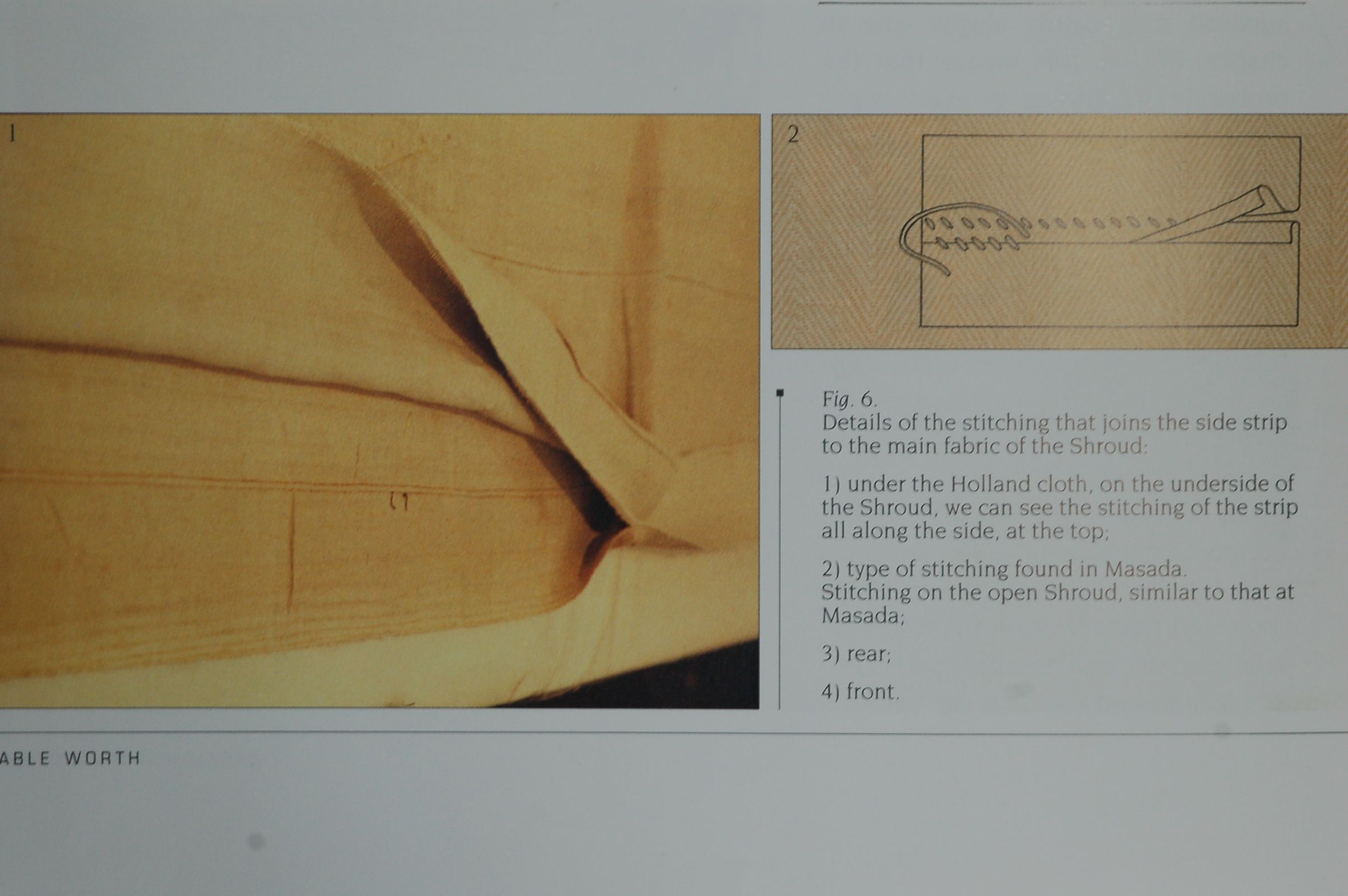
Photo 5. Mechtild Flury Lemberg, side strip
5) The so-called VIGNON MARKINGS. Many of the details of the head and in the face of the Man on the Shroud are being seen in images of the face of Jesus Christ in icons and mosaics as of the VI-th century AD in the Byzantine Empire. There are also images that resemble the face of te Man on the Shroud in the Catacombs in Rome from the first centuries AD, meaning that these artists had available examples of the face on the Shroud, that were seemingly already in existence.
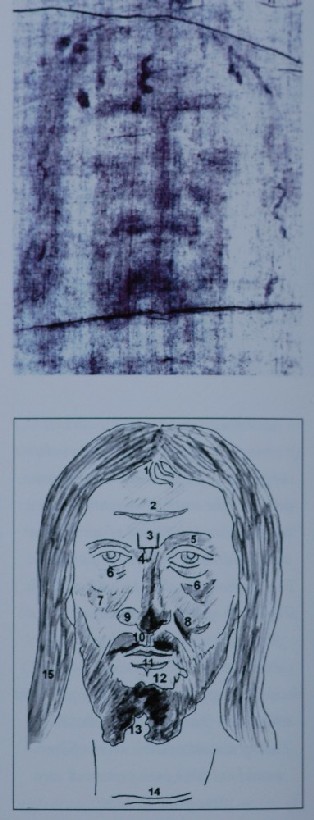
Photo 6. Vignon markings (see 20)
6) The discovery of a SOLID OVAL OBJECT by Dr. Petrus Soons, under the beard of the Man on the Shroud, with on the surface THREE HEBREW LETTERS, forming the word TS’ON, that has the meaning of SACRIFICIAL LAMB, meaning Jesus Christ.
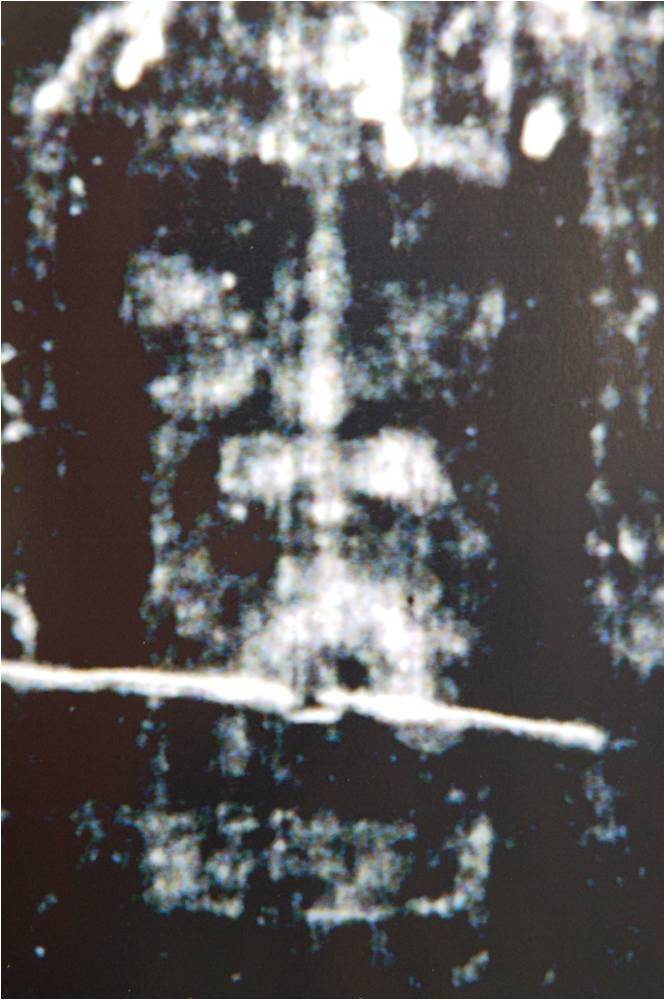
Photo 7. Solid oval object with 3 Hebrew letters
7) The discovery of the HALO AROUND THE HEAD by Dr. Petrus Soons, in the image of the Man on the Shroud and two other details under the beard that indicate that the Shroud of Turin and the Mandylion of Edessa are one and the same cloth, bringing back the presence of the Shroud to at least the year 525 AD.
BRIEF HISTORY OF THE EDESSA CLOTH.
Following a a (very) brief history of the Edessa Cloth (= The Shroud of Turin). Not all the details are accepted by the historians, but it gives a general idea of what happened to the Linen.
30 AD; According to the Acts of Taddeus, King ABGAR- V of the city of Edessa receives an image of Jesus Christ from the disciple Taddeus and by touching it he is cured from lepra and converts to the teachings of Jesus Christ.
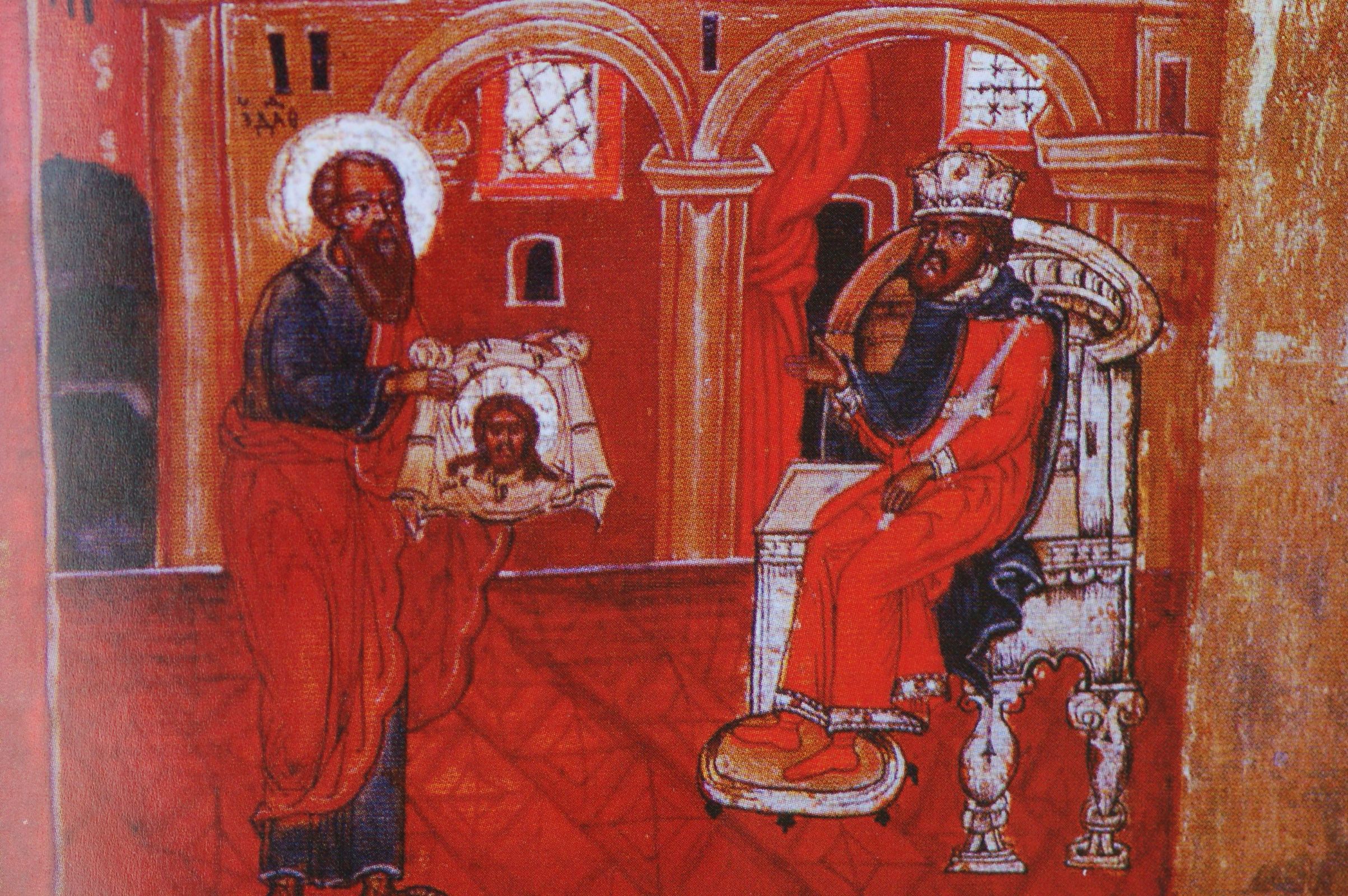
Photo 1. Disciple Tadeo offers mandylion to King Abgar 30 AD
55 AD; The second son of king ABGAR becomes king after the death of his father in the year 50 AD and his brother in 55 AD. He converts to paganism again and starts a prosecution of the Christians in his kingdom. The Cloth bearing the image of Jesus Christ is hidden in a niche above one of the city gates and consequently the whereabouts of this hiding place is being forgotten.
525 AD; Rediscovery of the Cloth during remodeling of the city walls after a disastrous inundation that destroys a great part of the city. It is being recognized as the Cloth that was brought to Edessa by the disciple Taddeus because the tradition of that story was still known.
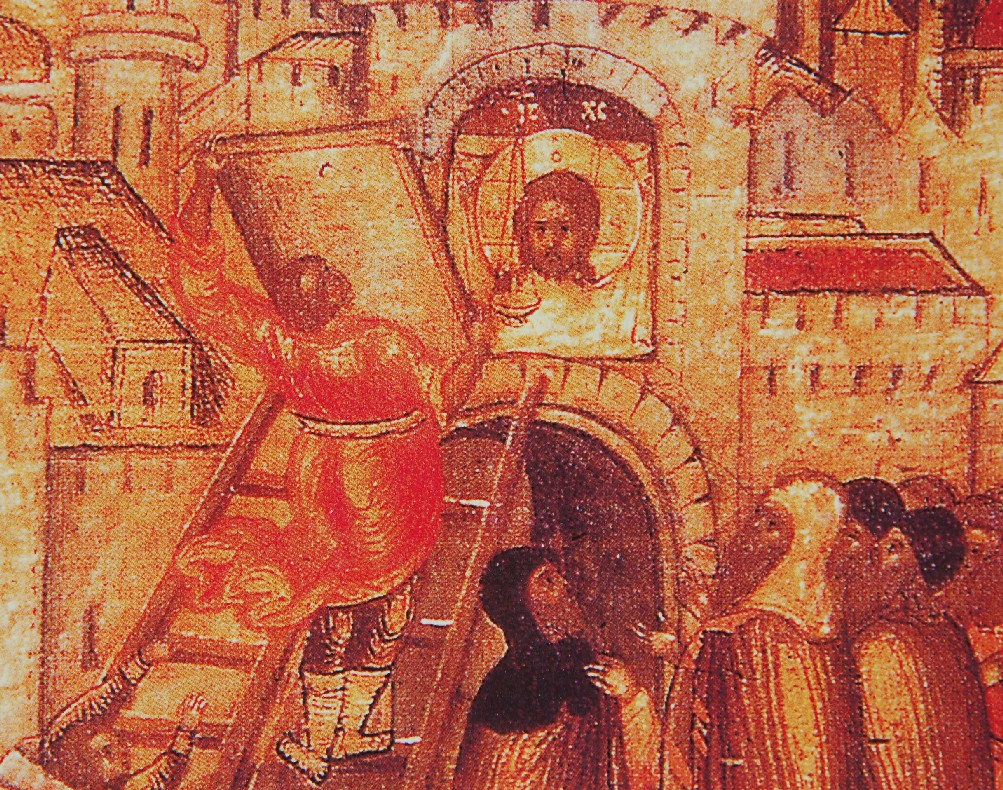
Photo 2. Discovery Shroud in Edessa 527 AD
943-944 AD; The Emperor of Byzantium sends an army of 70.000 soldiers to Edessa to take possession of the Cloth of Edessa. He offers 200 Muslim prisoners and a great amount of silver to the Kalif of the city. Edessa at that moment was in Muslim possession. The Kalif agrees eventually and forces the Christians of the town to hand over the Cloth to Kurkuas the general of the Byzantine army. In august of 944 the Cloth is paraded in the city of Constantinople and put in a chapel of the royal Palace together with all the other relics of the passion of Christ.
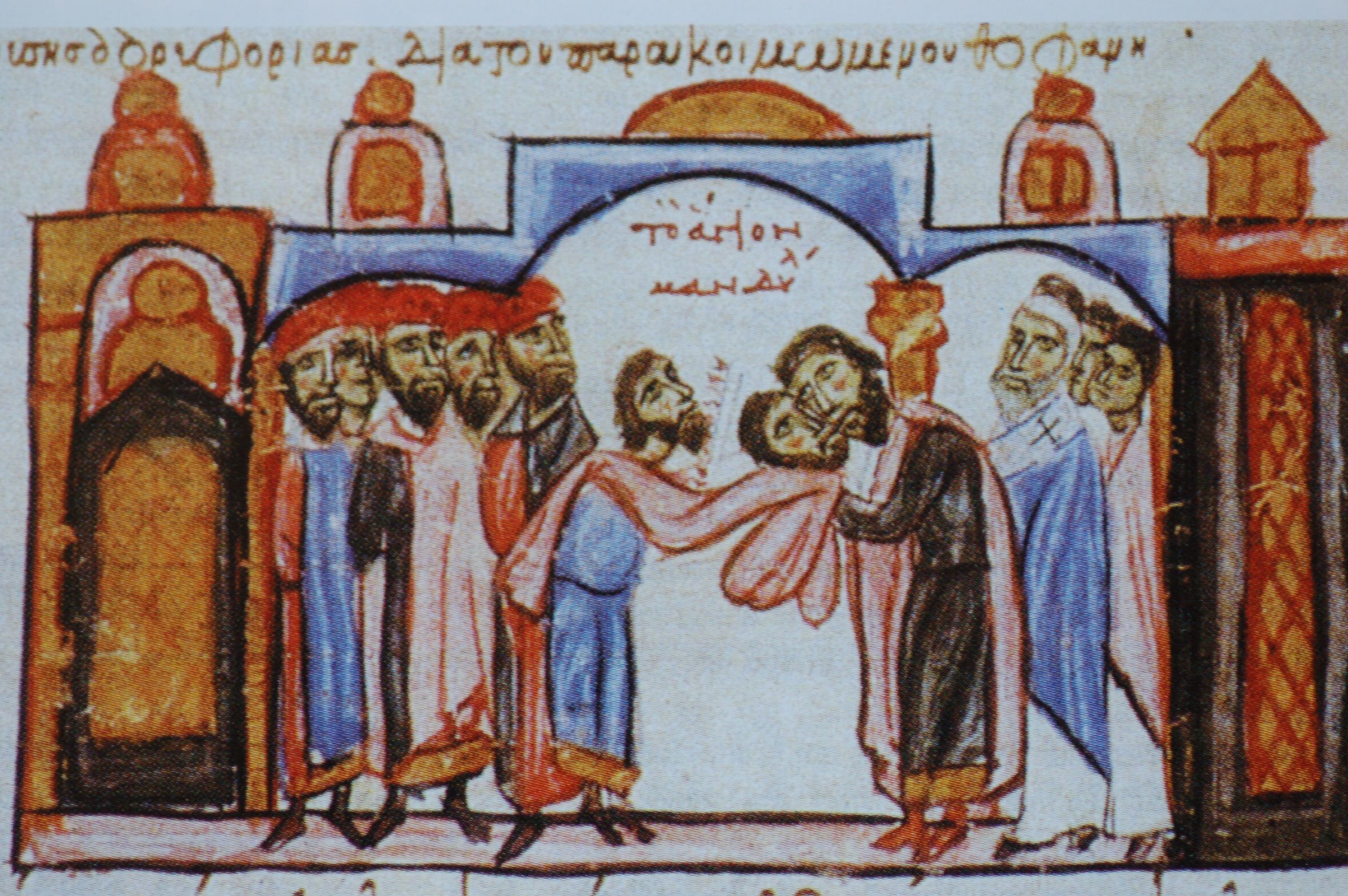
Photo 3. Constantinople Emperor receives mandylion of Edessa 944 AD
1204 AD; After a short siege of the city of Constantinople the Crusaders of the IV-th Crusade take possession of the city and for three days are looting everything they could lay their hands on. In times of distress the Cloth of Edessa would be transferred to the church of Saint Mary of Blachernae to protect the city from disasters, where it was seen a short time before the sack of the city by one of the French crusaders, Robert de Clari. This gentleman describes that the Cloth disappeared, and nobody knew the whereabouts anymore.
1355 AD; In Lirey a small village in the north of France a nobleman by the name of Geoffrey de Charny holds an exposition of a Cloth, telling that this was the original funeral Cloth that covered the body of Jesus Christ in the tomb. On the side of the family of his wife, Jeanne de Vergy, he was related to one of the crusaders, Otto de la Roche, who took seemingly the Shroud from the church of Saint Mary of Blachernae in Constantinople about 150 years earlier, became then the Duke of Athens in Greece and brought it later to France.
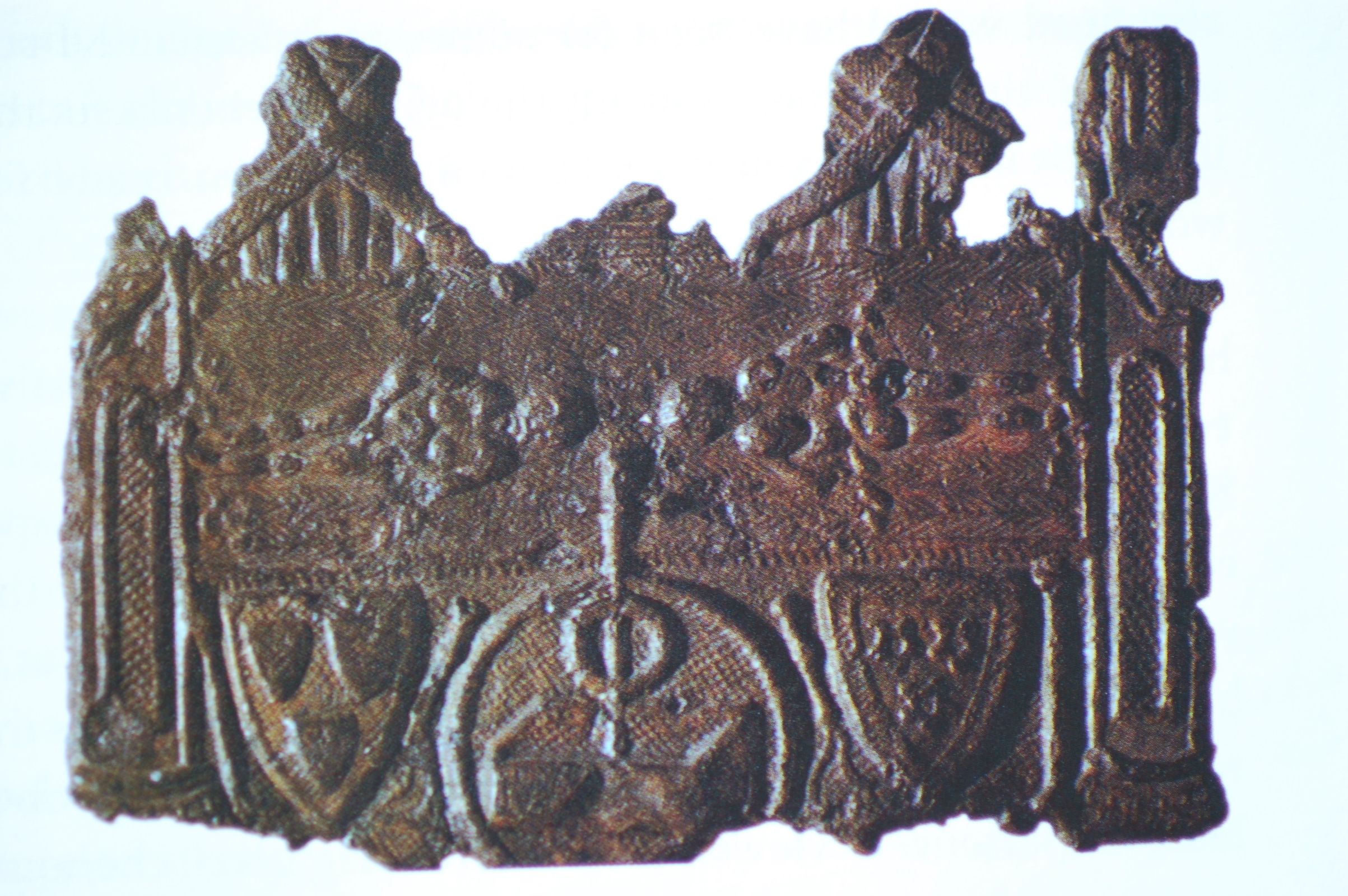
Photo 4. Lirey pilgrims amulet 1354 AD
1355 AD: From this year on the history of the Shroud is well known and recorded. In the year 1453 AD the granddaughter of Geoffrey the Charny, Margaretha de Charny, sold the Linen to the SAVOYE Family and their descendants were in the possession of the Shroud till the year 1983 when the last king of Italy (Savoye family) donated the Shroud to the Pope of Rome after his death.
1532 AD Fire breaks out in the Sainte Chapelle in Chambery, were the Shroud was being kept and it was only in the nick of time that the silver casket, containing the Shroud, could be saved, but the Shroud had received already quite some damage.
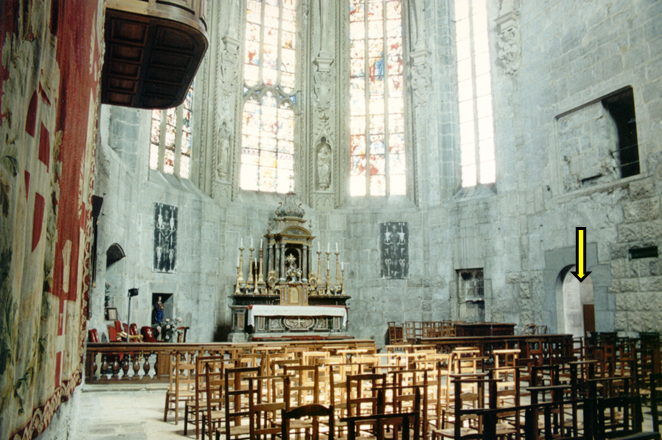
Photo 5. Chapel Chambery 1532 AD
1534 AD: The POOR CLARES nuns repair the damage of the fire of 1532 and stitch the Shroud to a strong Holland backing cloth. This was only removed during the restauration of 2002 in Turin.
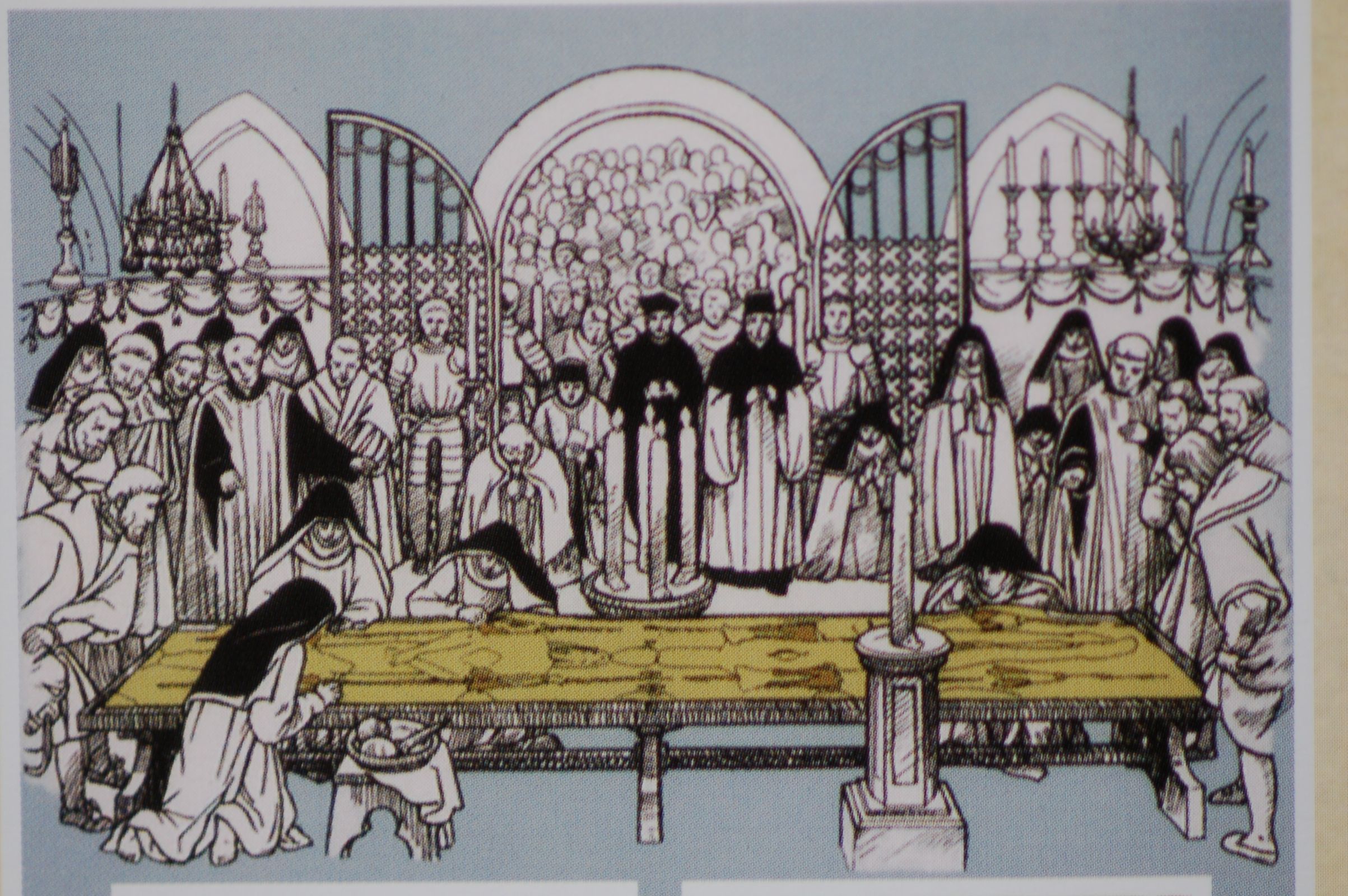
Photo 6. Clare nuns repair Shroud after fire |
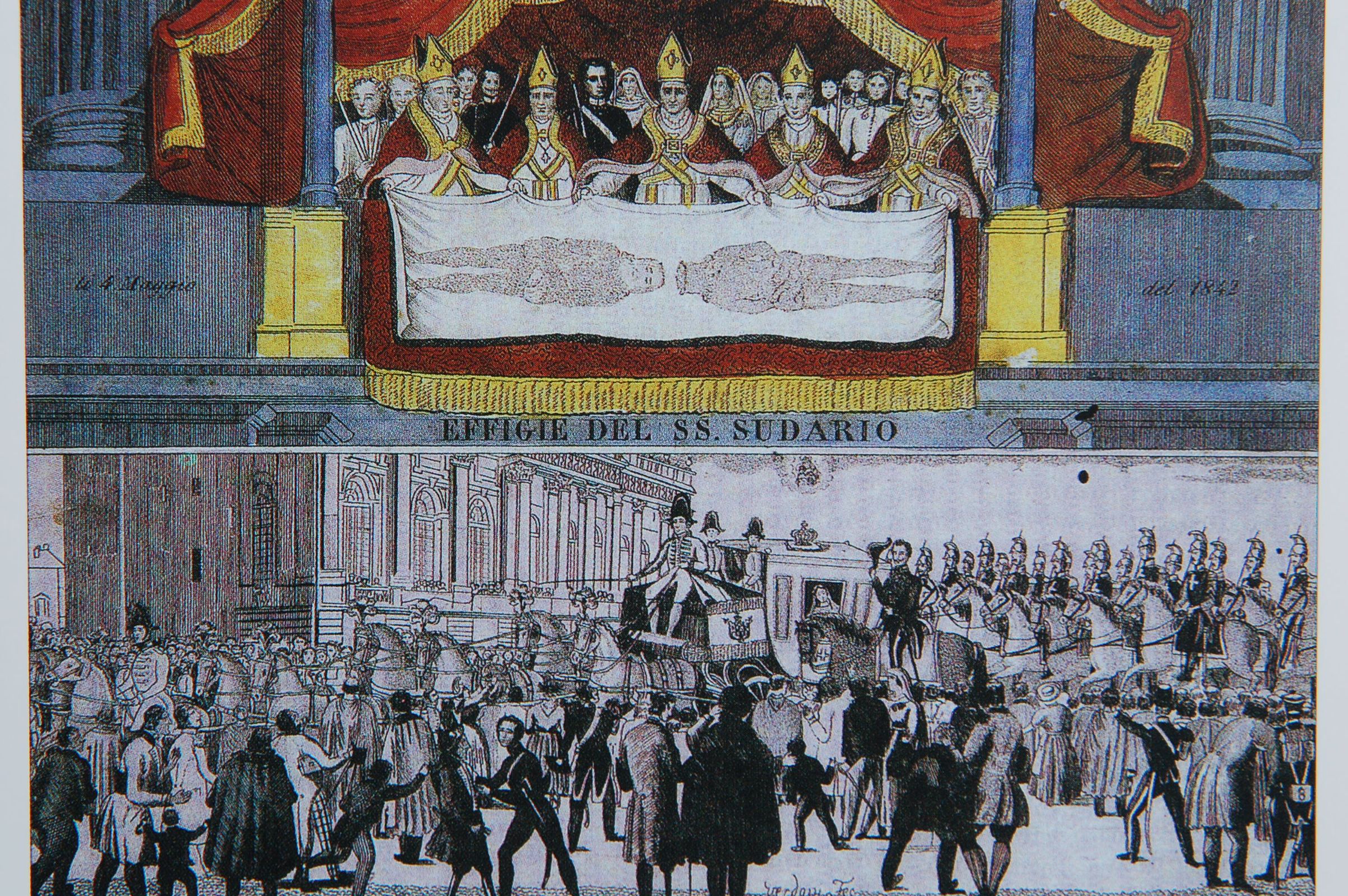
Photo 7. Exposition Shroud Turin 19th Century |
THE BOOK OF MARK GUSCIN: THE IMAGE OF EDESSA Published in 2010.
Mark Guscin did a research of the Cloth of Edessa in the archives of the monasteries in ATHOS in Greece and translated many of the texts regarding the Cloth of Edessa. His conclusion was:
“ ——–It is true that the same texts (and numerous others) refer to nothing more than a facial image when describing the FORMATION of the portrait (be it before the passion or in Gethsemane), but even so it can confidently be stated that some people at some times believed, rightly or wrongly, that the Image of Edessa contained a full-body imprint of Jesus of Nazareth.
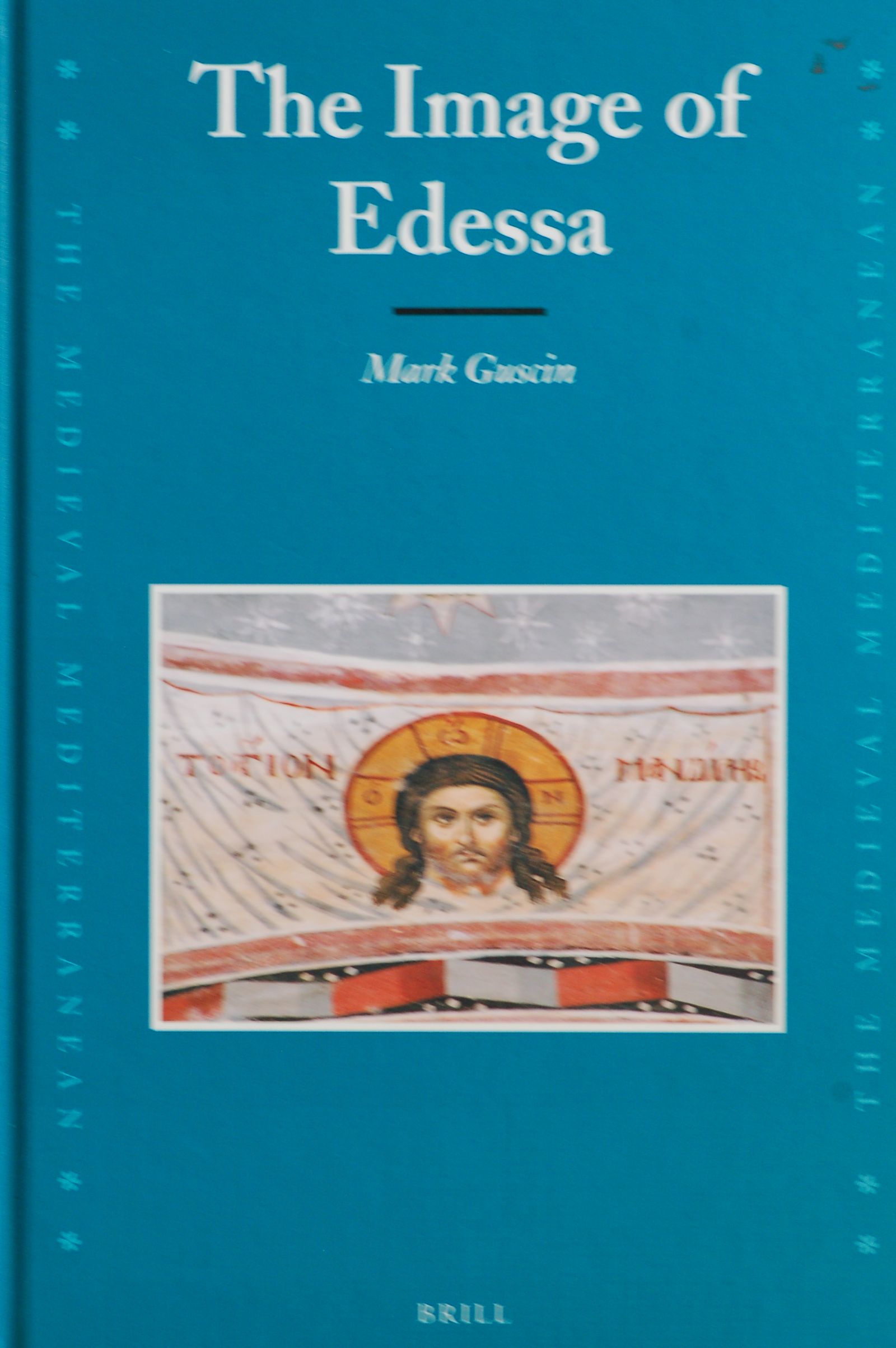
Photo 8. Book Mark Guscin
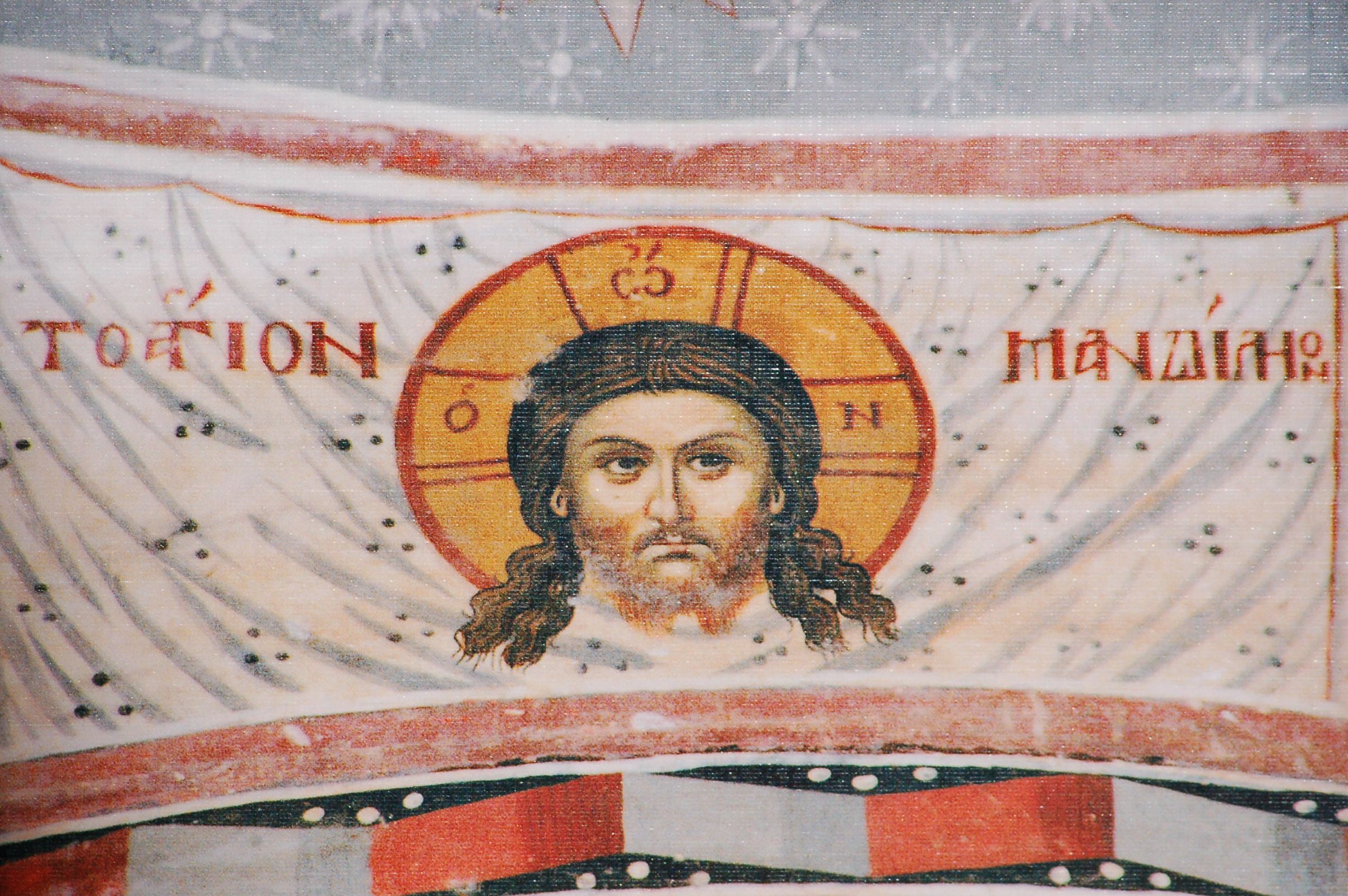
Photo 9. Mandylion Book Guscin |
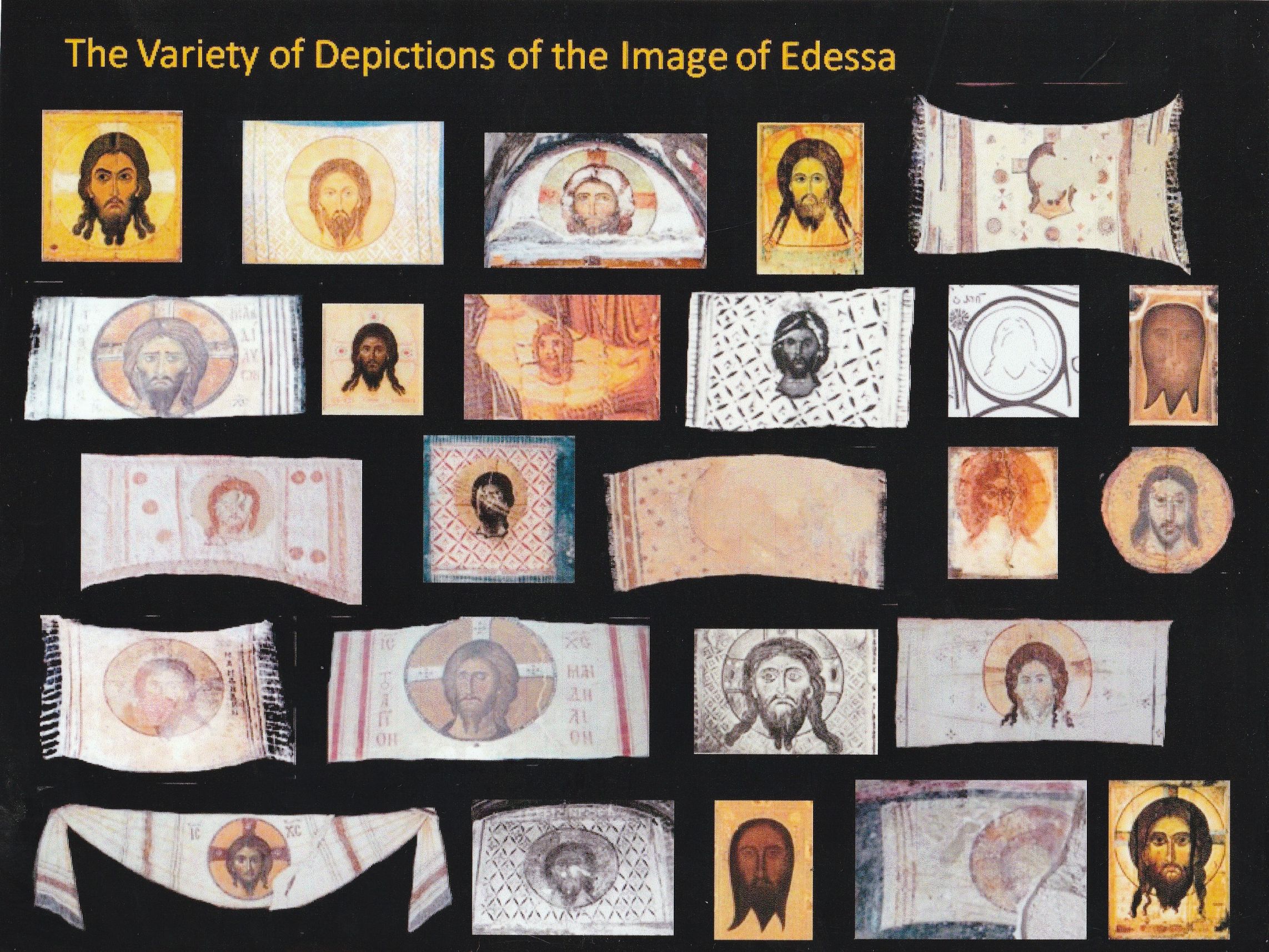
Photo 9a. Depictions cloth of Edessa |
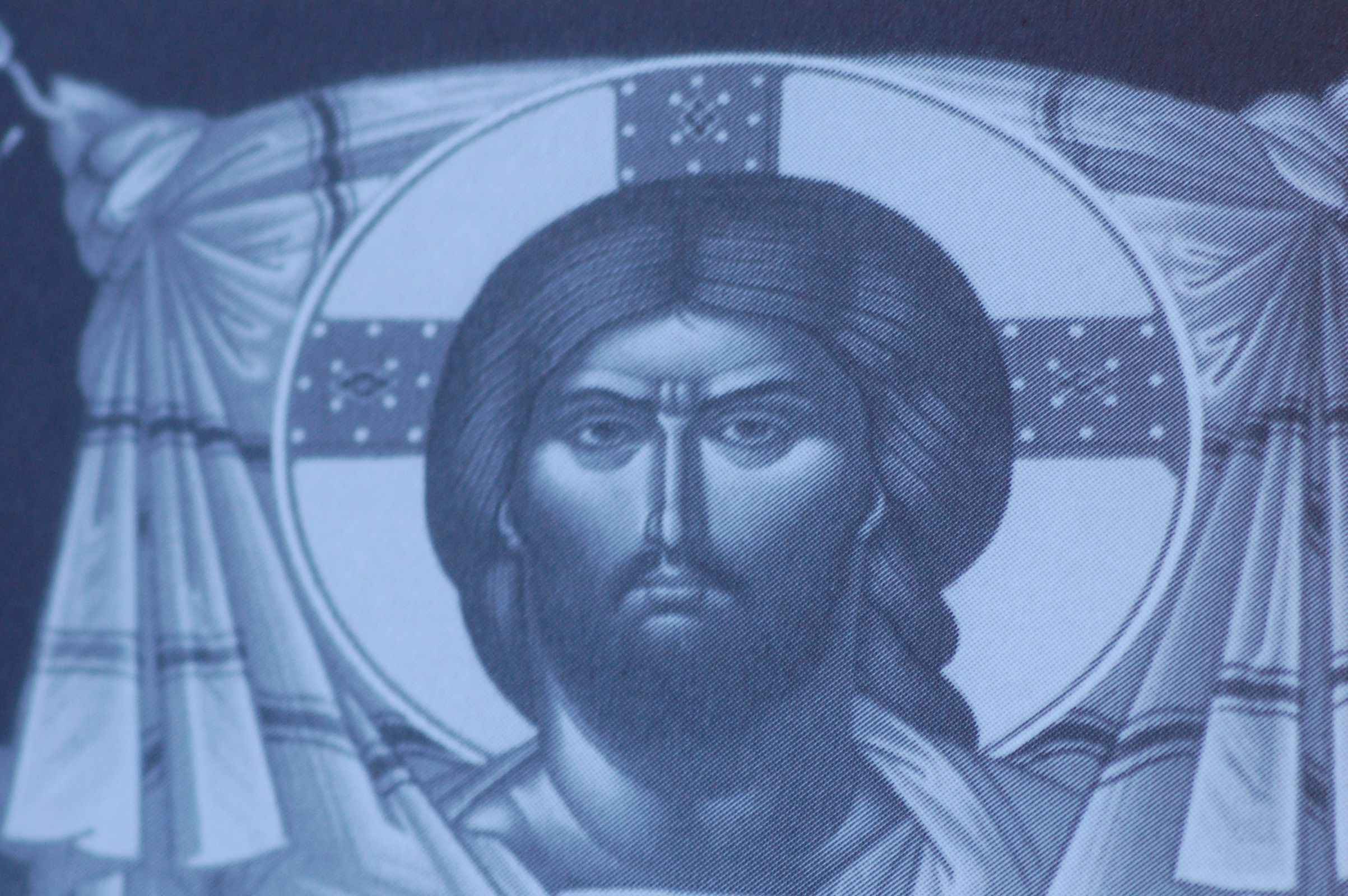
Photo 26. Guscin Mandylion
OTHER INDICATIONS THAT THE IMAGE OF EDESSA CONTAINED A FULL-BODY IMPRINT OF THE BODY OF JESUS OF NAZARETH.
1) The sermon in the Hagia Sophia in Constantinople of Gregory Referendarius in 944 AD, just after the arrival of the Cloth in the city (from a manuscript in the Vatican Library):—————–For the radiance was not depicted with the techniques of the art of painting, which fashions images—————-“(page 85)”————————-This reflection—-has been imprinted only by the sweat from the face of the ruler of life, falling like drops of blood, and by the finger of God———————Because that from which (the true imprint of Christ) they dripped, was also embellished by drops from his own side. Both are highly instructive—–blood and water there, here sweat and image.——–The source of living water can be seen and it gives us water, showing us that the origin of the image made by sweat (FACE) is in fact of the same nature as the origin of that which makes the liquid flow from the side (LANCE WOUND).”
2) A French Crusader, ROBERT de CLARI, who toured Constantinople in 1203, before the taking and the sacking of the city, wrote in his memoirs: ———- “ There was another church which was called My Lady St. Mary of Blachernae, where there was the SHROUD in which Our Lord had been wrapped, which every Friday raised itself upright, so that one could see the figure of Our Lord on it.”
3) Letter of Theodore Angelos (cousin of two Byzantine Emperors) to Pope Innocent III , dated 1st of august 1205 AD, one year after the sacking of Constantinople. In this letter he writes: “Theodore Angelus wishes long life for Innocent III, Lord and Pope at old Rome, in the name of Michael, Lord of Epirus and in his own name. In April of last year, a crusading army, having falsely set out to liberate the Holy Land, instead laid waste to the city of Constantine. During the sack, troops of Venice and France looted even the holy sanctuaries. The Venetians partitioned the treasures of gold, silver and ivory while the French did the same with the relics of the saints and THE MOST SACRED OF ALL, THE LINEN IN WHICH OUR LORD JESUS CHRIST WAS WRAPPED AFTER HIS DEATH AND BEFORE HIS RESURRECTION. We know that the sacred objects are preserved by their predators in Venice, in France and in other…………………………………”
THEORY OF IAN WILSON 1978
Ian Wilson developed the theory in the seventies that based on one of the names given to the Cloth of Edessa namely: “TETRADIPLON” or “doubled in four”, he had very strong indications that the Cloth of Edessa and the Shroud of Turin are identical. TETRADIPLON is a word that is not in normal usage in the Greek Language, but is only used for the Cloth of Edessa. Ian Wilson was educated as a historian at Magdalen College, Oxford, U.K.
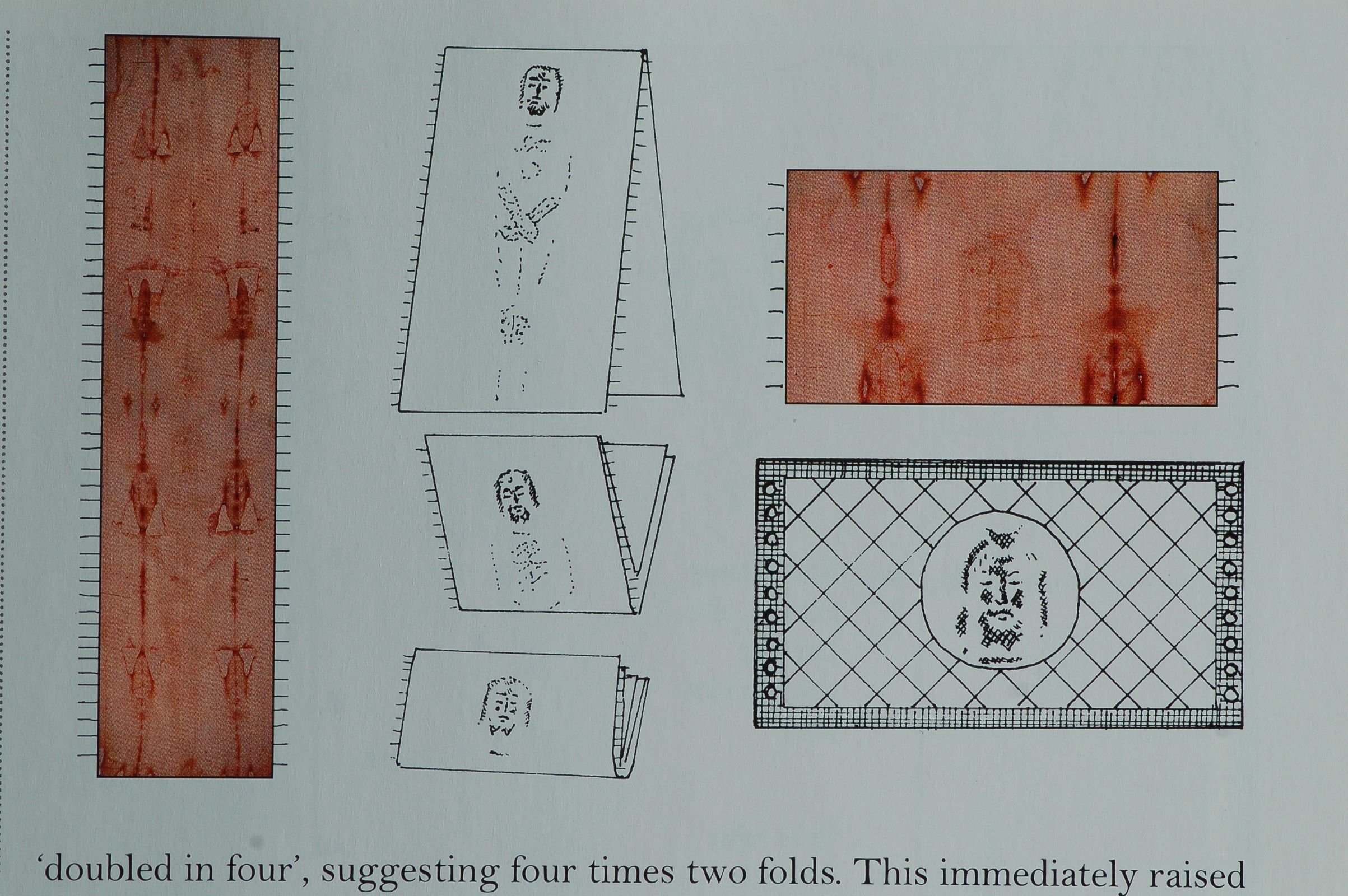
Photo 10. Tetradiplon
When the Shroud is “doubled-in-four” (four times two folds) and mounted on a board, only the face is visible. The length of the Shroud is 442 cm, and the width is 113 cm. When you double the Shroud in four the sizes are 113 x 55.25 cm. The “doubled-in-four” crease lines, visible in raking light, were identified by Dr. John JACKSON in 1979, consistent with this one-time “doubled-in-four” folding arrangement.
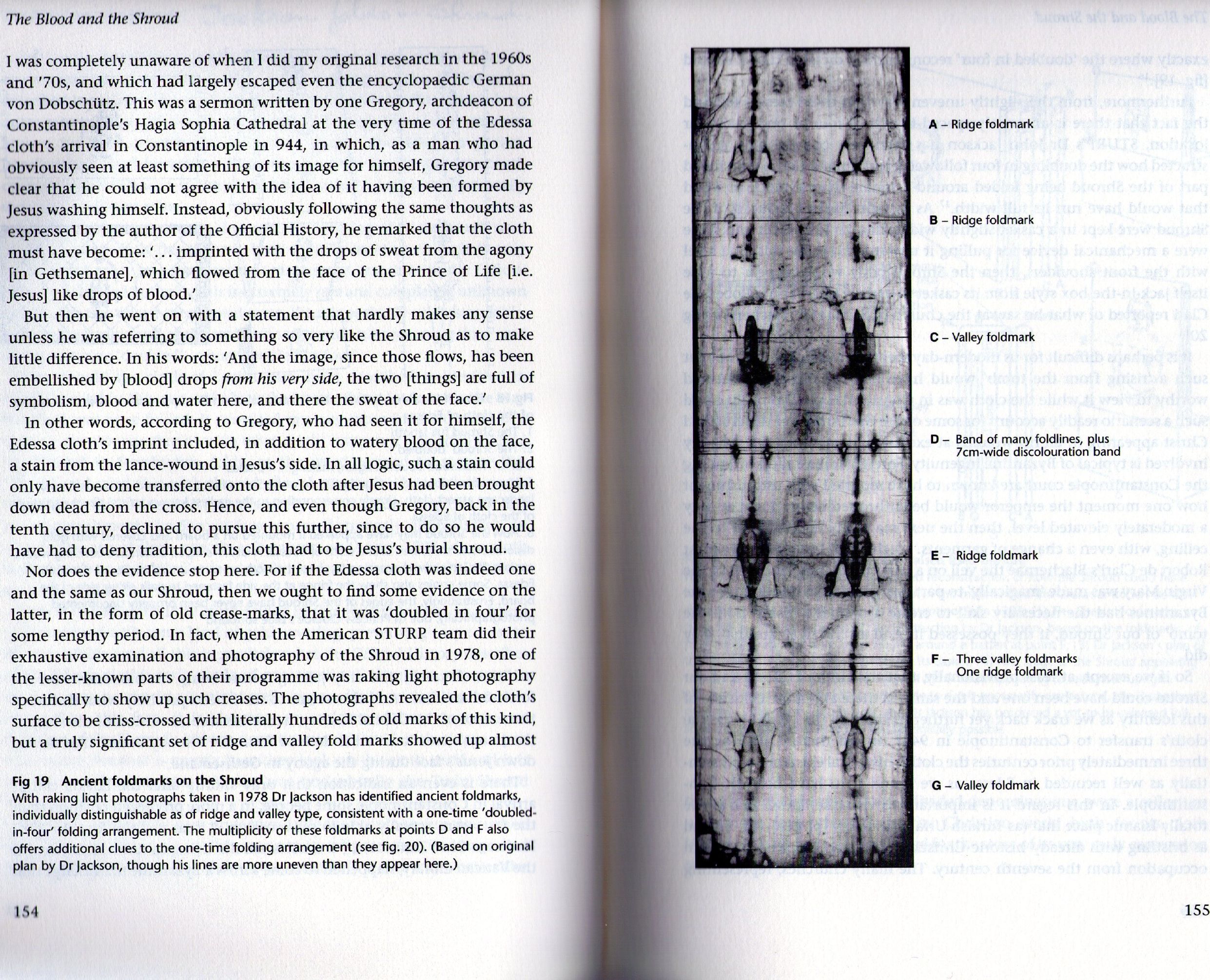
Photo 11. Tetradiplom folds John Jackson
In his latest book: “THE SHROUD, Fresh Light on the 2000-year –old Mystery…..” Wilson gives a lot of proofs for his theory.
INVESTIGATIONS DONE ON A VARIETY OF PHOTOGRAPHIC IMAGES
During the last three years (since 2008) I did a lot of research on the 3D images that were created, including the holograms and lenticular images that were produced. The conversions from 2D to 3D were done based on black-and-white photographs of 1931 made by Giuseppe ENRIE and in the process, I found that around the head of the Man on the Shroud a HALO was visible. It was very similar to the HALO that is visible around the head when you double the Shroud in four (four times two folds) cover it with a precious cloth and make a round opening to make the face visible.
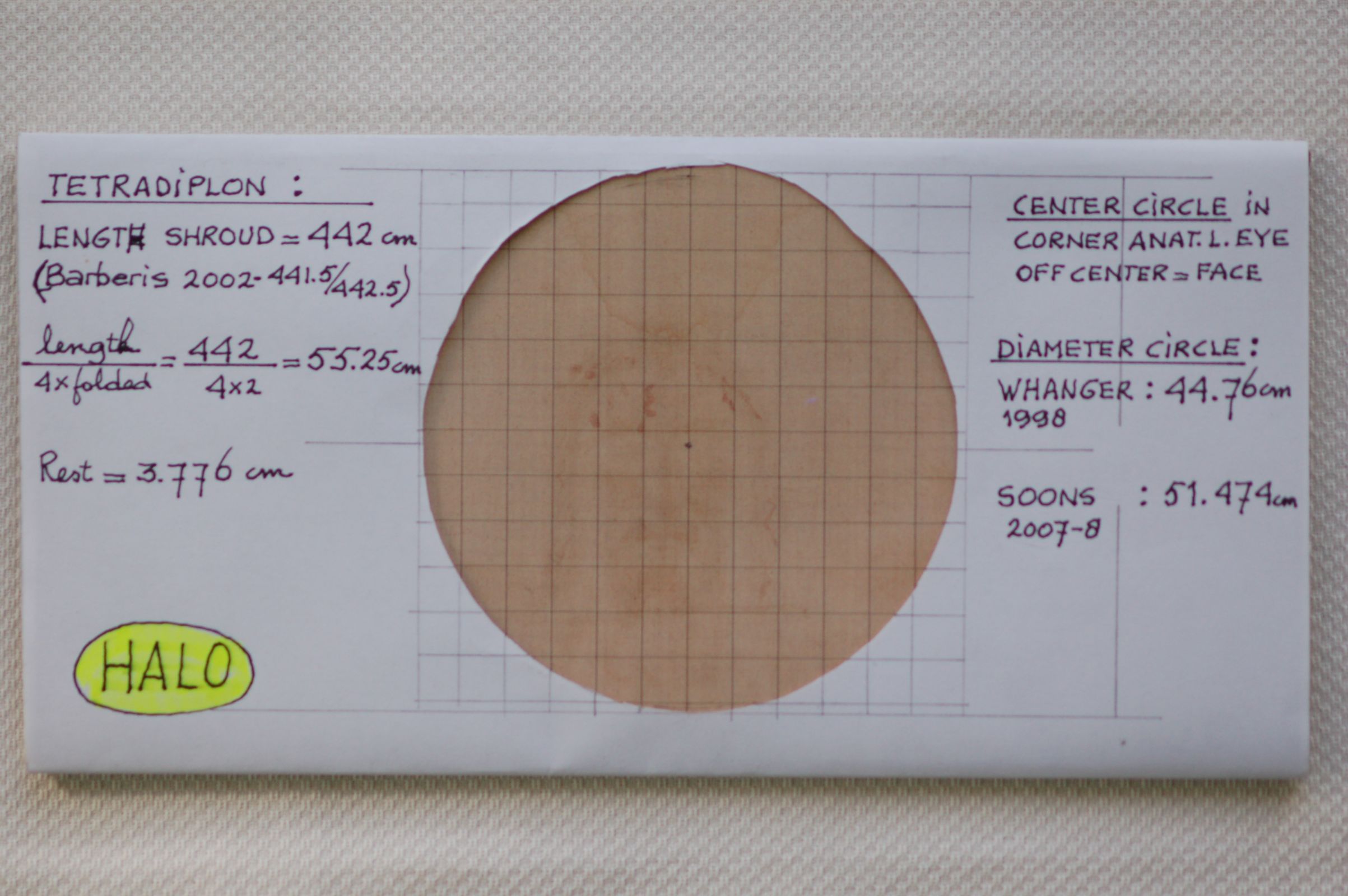
Photo 12. Tetradiplon doubled in 4 |
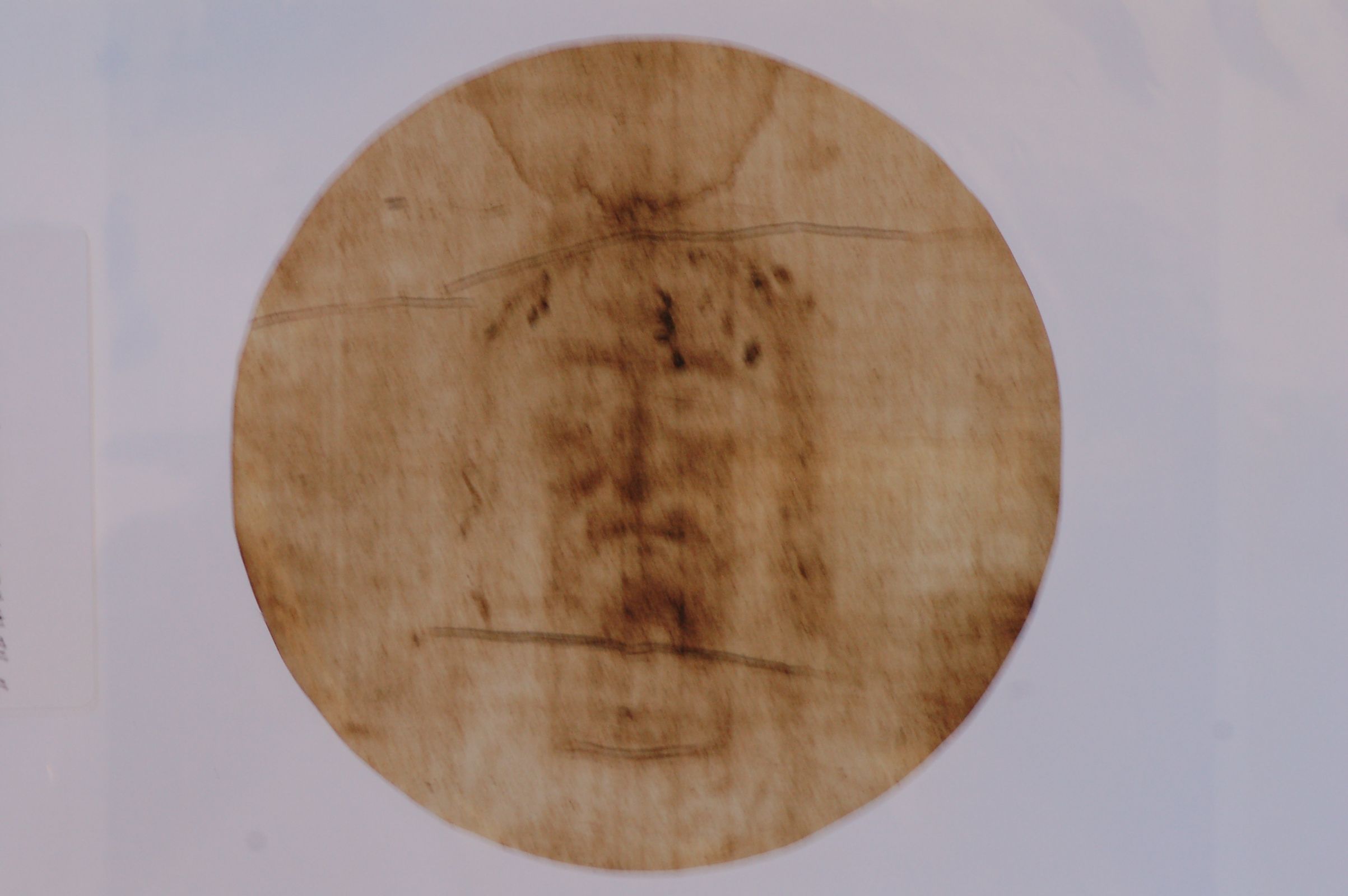
Photo 13. Mandylion head visible only |
Later I had access to photographs of Vernon Miller and Barrie Schwortz made during the STURP investigations in 1978. The Ultra-Violet photographs made by Miller showed clearly this HALO.
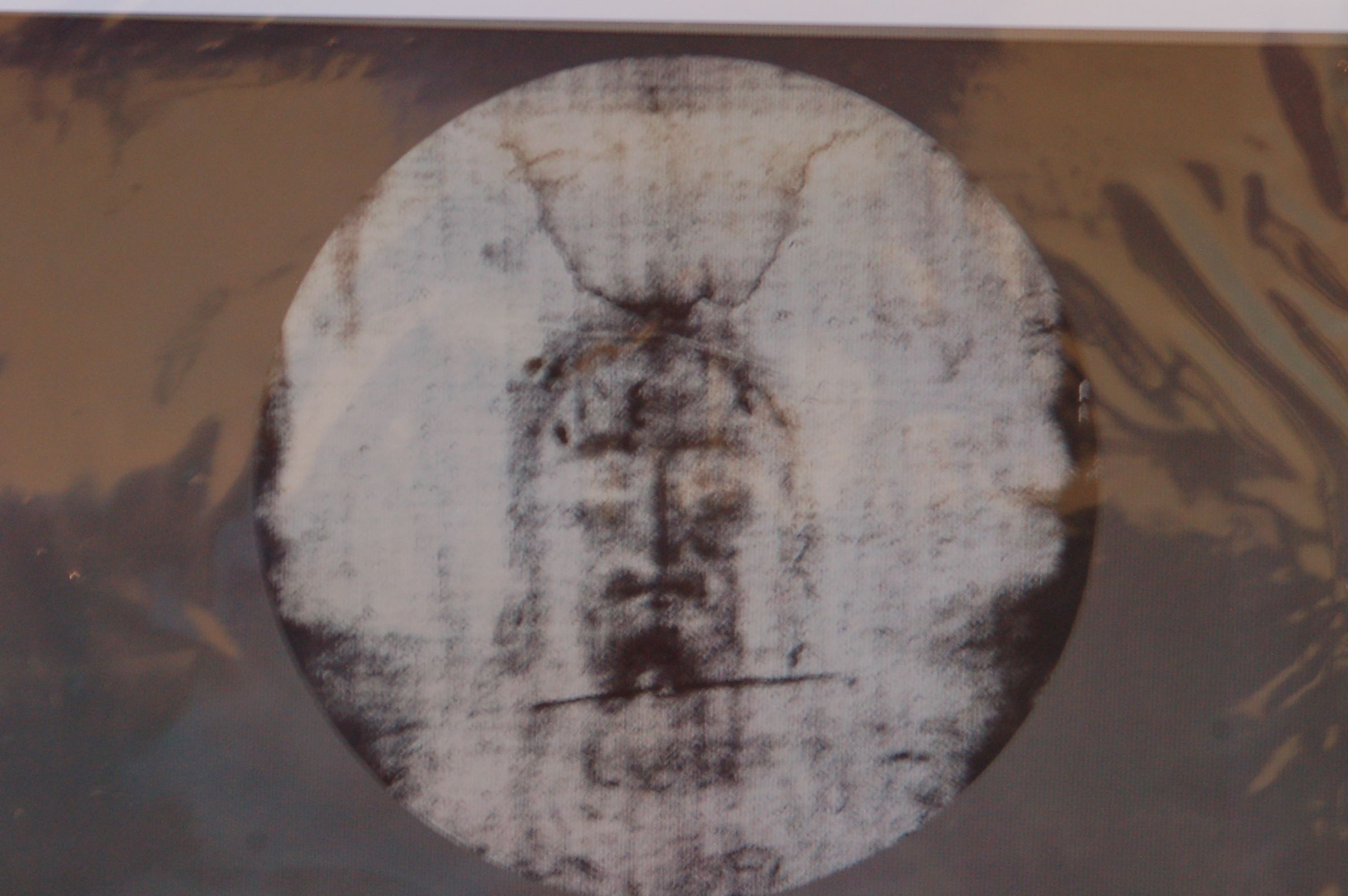
Photo 14. Vernon Miller photo mandylion |
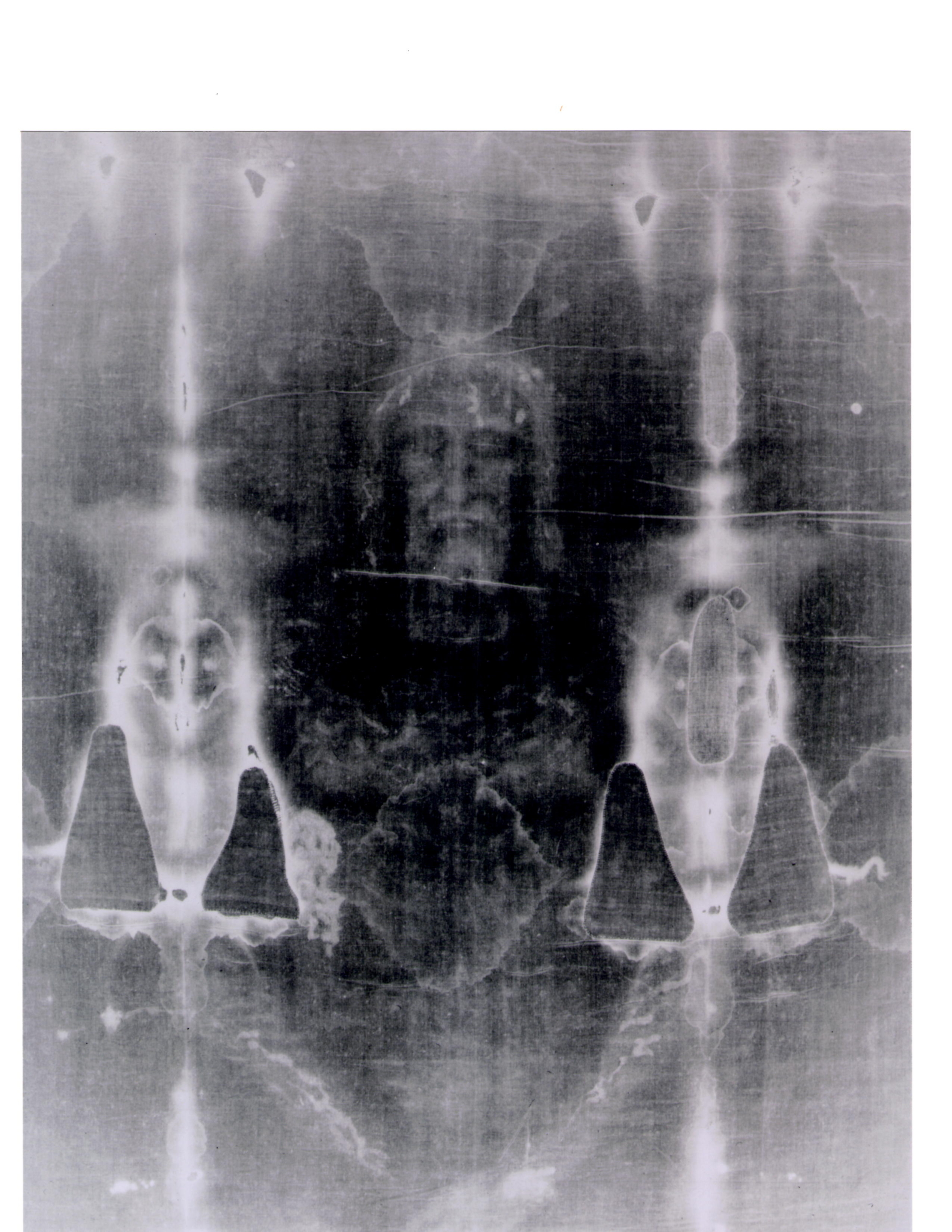
Photo 15. Vernon Miller halo visible |
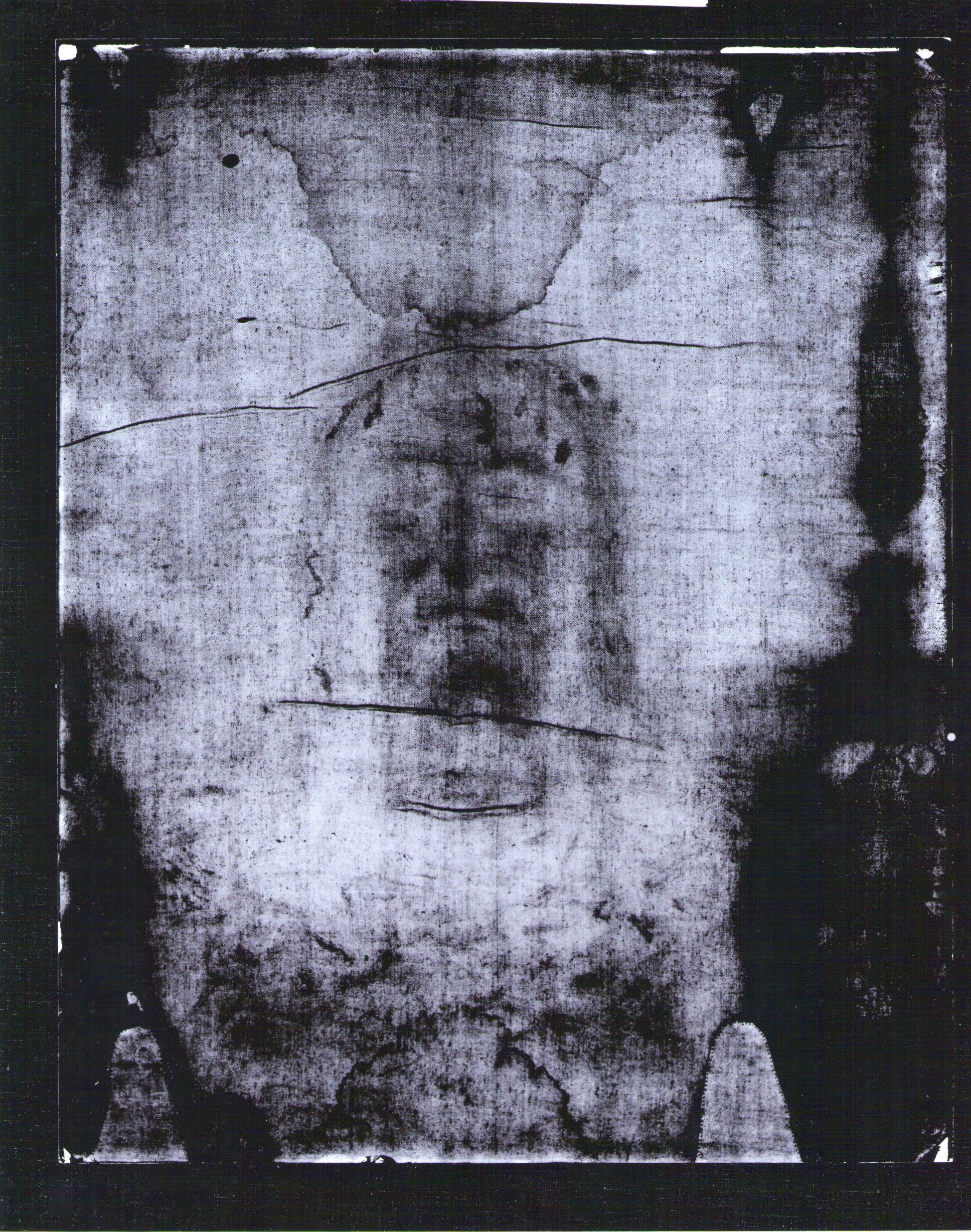
Photo 16. Halo around head photo Vernon Miller |
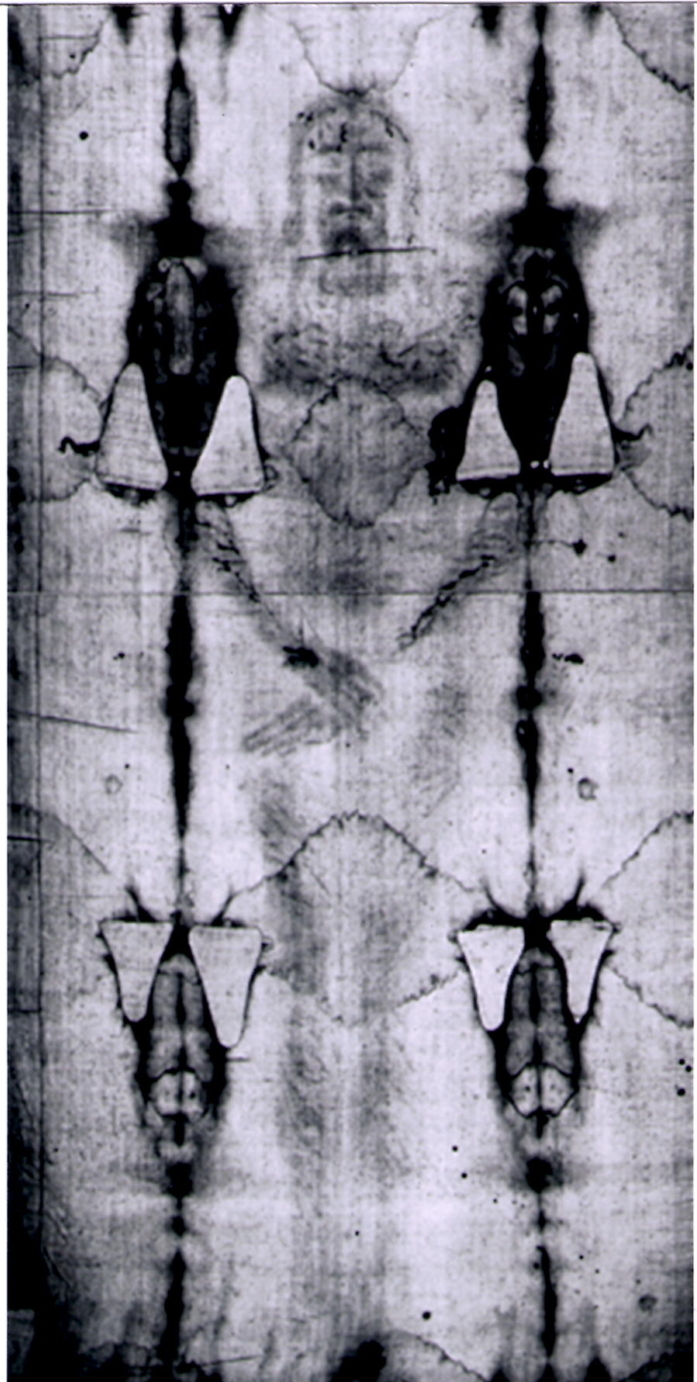
Photo 17. Positive image body |
Later investigations included raking light photographs (STURP 1978), and also images created by the so-called Image Overlay technique by Aldo Guerreschi and Alan Whanger, also showing this HALO. In 2010 this was also confirmed by Tom D’Muhalah (Raleigh, N.C.) and Avinoam Danin (ISRAEL), studying photographs of Vernon Miller and Giuseppe Enrie.
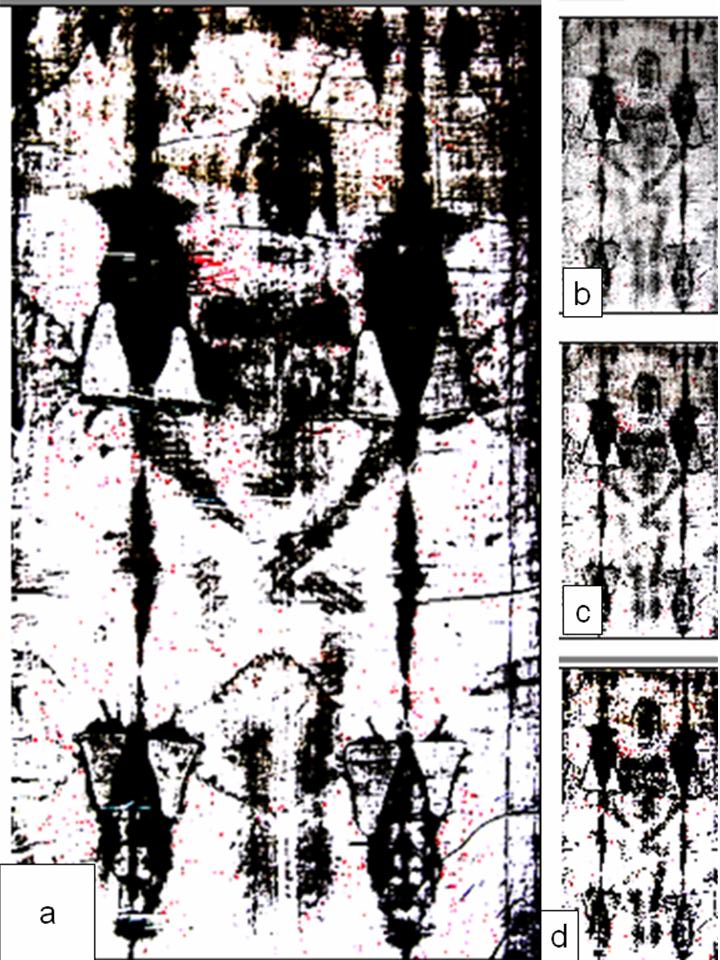
Photo 18. Halo photo Giuseppe Enrie
The reason this HALO is visible around the head in a variety of photographs is, that according to the theory of Ian WILSON, during hundreds of years the Shroud was doubled in four and the only part exposed to light during viewings was the round opening showing the face. Natural aging will turn a new and white linen over time into a yellowish color and the fact that most of the Shroud was hidden and only the round opening showing the face was exposed to different light conditions means, that the linen in this area aged more than the rest of the Shroud and this shows up specially in the Ultra Violet photographs of Vernon Miller taken in 1978 during the STURP investigations. It is of interest for future investigations to check fibers of the HALO area and fibers of the non-HALO area to see if there is any difference in the chemistry of these fibers due to different aging processes.
STUDY OF SHROUD FEATURE EVIDENCE USING VIDEO AND PHOTOGRAMMETRIC ANALYSIS METHODS a.k.a “ THE HALO STUDY “
By Peter Schumacher and Petrus Soons
In December of 2013, Dr. Petrus Soons and Pete Schumacher began a study of the Shroud of Turin with a particular focus on the area around the face of the “Man of the Shroud”. It had been observed by Dr. Soons that there appeared a difference in shading surrounding the face that was perhaps coincident with the Mandylion representations in artworks and that further study might provide a more conclusive determination as to actual Shroud image properties and such content in artwork representations of the Shroud.
The study was undertaken at the Shroud Exhibit and Museum located in Alamogordo, New Mexico. The Museum and exhibit are presently in storage pending completion of relocation to a much larger facility in the shopping and entertainment area of historic downtown Alamogordo. (In 2014 it has been reopened in downtown Alamogordo).
The primary image used was the 1978 full-size color image on Kodak Duratrans film purchased from Barrie Schwortz in 2009. It is illuminated by proper color temperature diffuse lighting. The display fixture was custom designed for the specific purpose of image analysis.
A VP-8 Image Analyzer system was used in one element of the study. This is the same equipment used by Captains Jackson and Jumper in 1976 to make a model of the Man of the Shroud. However, this type of equipment is relatively inaccessible to other investigators. Furthermore, this is an analog system and tolerance variables are difficult to duplicate. Higher accuracy is now available through digital images and processes, though this does not negate the value and importance of proper analog analysis.
Schumacher used multiple digital and analog analysis methods to compare study results. He wanted to insure, that it would be possible for others to duplicate the work, assuming they are experienced in the practices necessary to digitize images properly from photographs and to perform subsequent digital analysis. The digital capture process is critical and essential to the quality of the studies
Dr. Soons provided some of the images used in the study. Others were provided by the Shroud Exhibit and Museum archives. The ambient room light was eliminated, and reflections prevented by controlling the camera-to-image path, in the case of backlit transparency images, and the light source-to-print-to-camera path in the case of photographic prints. Images by Giuseppe Enrie, Barrie Schwortz, Vernon Miller and Rogers were among the images studied. Not all are included here for the purpose of brevity.
For the rest of the study look at the complete following articles and also at the POWERPOINT PRESENTATIONS of Pete Schumacher and Dr. Petrus Soons that explain very well the studies that were done.
The CONCLUSION of this study was:
“Using several Shroud images of different types and dates, various image analysis and measurement techniques and employing graphic overlays, to compare extracted features to various artworks and icons, it is the conclusion of Peter Schumacher that the statements made by Dr. Petrus Soons are demonstrated to be accurate beyond reasonable doubt.
Thus, the Mandylion of Edessa and the Shroud of Turin are one and the same. Therefore, the Shroud of Turin existed at a time in accord with the known history of the Mandylion “. I defer to the considered works of Ian Wilson and other accomplished historians as to the impact of the results of this study, as I am not a historian.
While is is true that not everyone has a VP-8 Image Analyzer system available to them, and, while they may not have all the images available to them that we used in this study, I am convinced that this evidence is conclusive and can be readily duplicated by anyone reasonably capable in the disciplines applied while using a variety of easily accessible tools and even some readily accessible images.
@ 2014 Schumacher-Soons All Rights Reserved
THE CONCLUSION OF ALL THE INVESTIGATIONS IS:
The HALO that has been discovered in a variety of photographs and that fits the size of the round opening in the TETRADIPLON, showing only the head of the Man on the Shroud, is a very strong indication that IAN WILSON’s theory that the Shroud of Turin and the Cloth of Edessa (Tetradiplon, Mandylion) are identical is true. Because there is no anatomical detail visible of the surface of the body in the region of the upper thorax of the image of the Man on the Shroud, the head looks like disembodied and floating. That was probably the reason that for many centuries people did not know and realize that this cloth contained the image of the whole front and back of the body, apart from the fact that the TETRADIPLON was mounted, framed and covered with a precious cloth, leaving the round opening showing the face only. This object was considered so sacred that very few people were permitted to even touch or see it. This discovery means also that we can date the Shroud of Turin to at least the year 525 A.D. when the Cloth of Edessa was rediscovered in the niche above the city gate.This would also prove that the sample that was taken from the Shroud for the Radiocarbon Dating of 1988 was not representative for the whole Shroud.
TWO OTHER DETAILS VISIBLE IN AND AROUND THE HALO THAT WE WILL FIND BACK IN BYZANTINE ART
When you take a good size photograph of the whole Shroud and double it in four you will find on one side the image of the face only. Reconstructing what the Byzantine artist did in the past when framing the image and finding the center of the circle around the head, you will first make a vertical line in the middle of the cloth and then make a horizontal line crossing both eyes. (artistically spoken the center of the face is between both eyes). Where the vertical and horizontal line cross you will find the center that you need to construct the circle to create the round opening in the covering precious cloth to make the face visible. Now we have the round opening in the middle of the cloth. If you do that you will find that the center of the circle will end up IN THE CORNER OF THE RIGHT EYE. The reason for this is that the image of the Man on the Shroud is not exactly in the middle of the cloth but displaced about 2-3 cm to the left side of the median line.
The measurements of the Mandylion are 113 cm x 55.2 cm, when the cloth is “doubled in four”. A second observation is that the border of the covering on the top of our HALO is smaller than the border on the bottom of the Halo. The diameter of the HALO was measured by me to be about 48 cm.
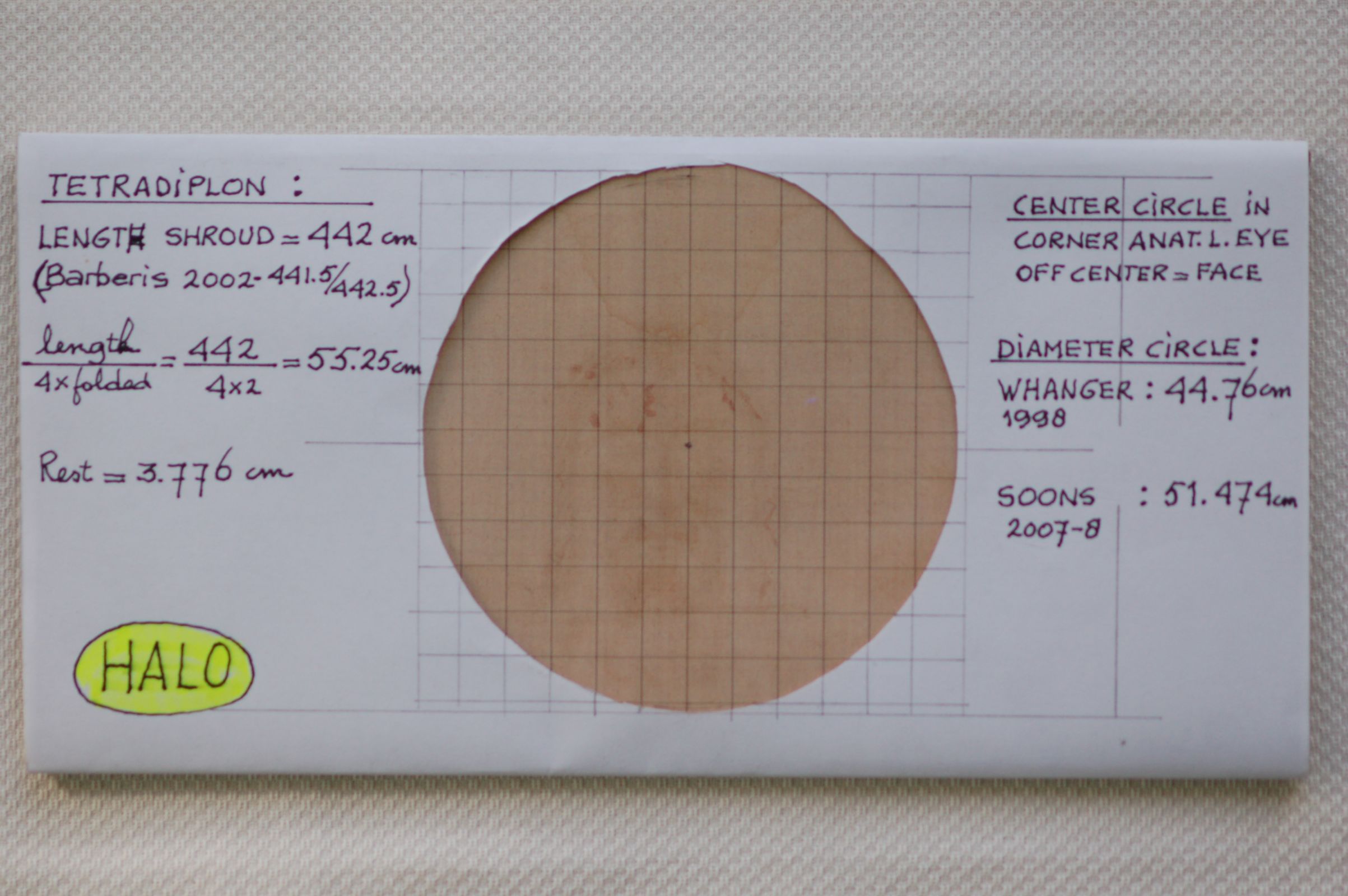
Photo 12. Tetradiplon, doubled in 4
In our HALO POWER POINT presentation (Click to see the Presentation) we show a series of images of the Mandylion (Cloth of Edessa) where indeed the upper border is shown to be smaller than the bottom one, so the artists copied these details truthfully.
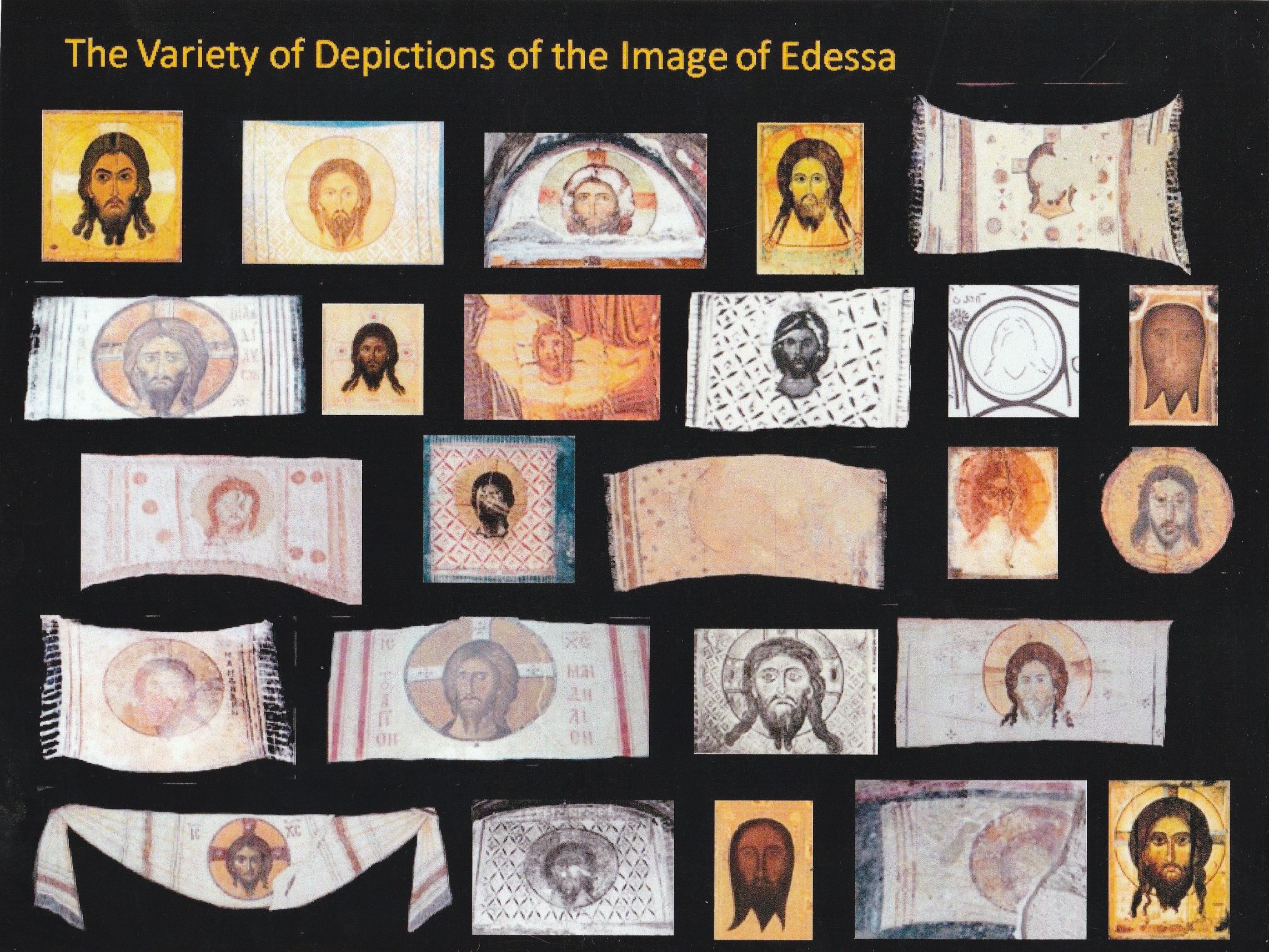
Photo 9a. Depictions cloth od Edessa
After that we show a series of images of icons and mosaics of the Byzantine Empire of the face and image of Jesus Christ with a HALO and measuring the center of the HALO you will observe that this is exactly in the corner of the right eye, the same as we have shown with the reconstruction of the HALO in the Tetradiplon and explaining the reason why. The Byzantine artists copied all these details very accurately in their icons and mosaics and these images where considered by them to be very sacred explaining also, the constant copying of these details without changing them.
(The definition of an Icon is: —-an artistic representation of a sacred person, which Icon itself may be venerated as sacred).
TWO MORE DETAILS IN THE IMAGE OF THE MAN ON THE SHROUD THAT SUPPORT IAN WILSON’S THEORY
THE FIRST DETAIL:
In the beginning of the 20th century, the French scholar PAUL VIGNON identified a series of markings on the face and the head of the image of the Man on the Shroud, frequently recurring in Byzantine portraits of Jesus, seemingly deriving from features visible on the Shroud. He identified 15 of these markings and did quite some research of Byzantine artworks to identify these. In the eighties Alan WHANGER (USA) continued with his work, and also investigated images of Jesus Christ on Byzantine coins and he found the same occurrence of these markings. In some instances, the marks in the artworks appear in mirror image.
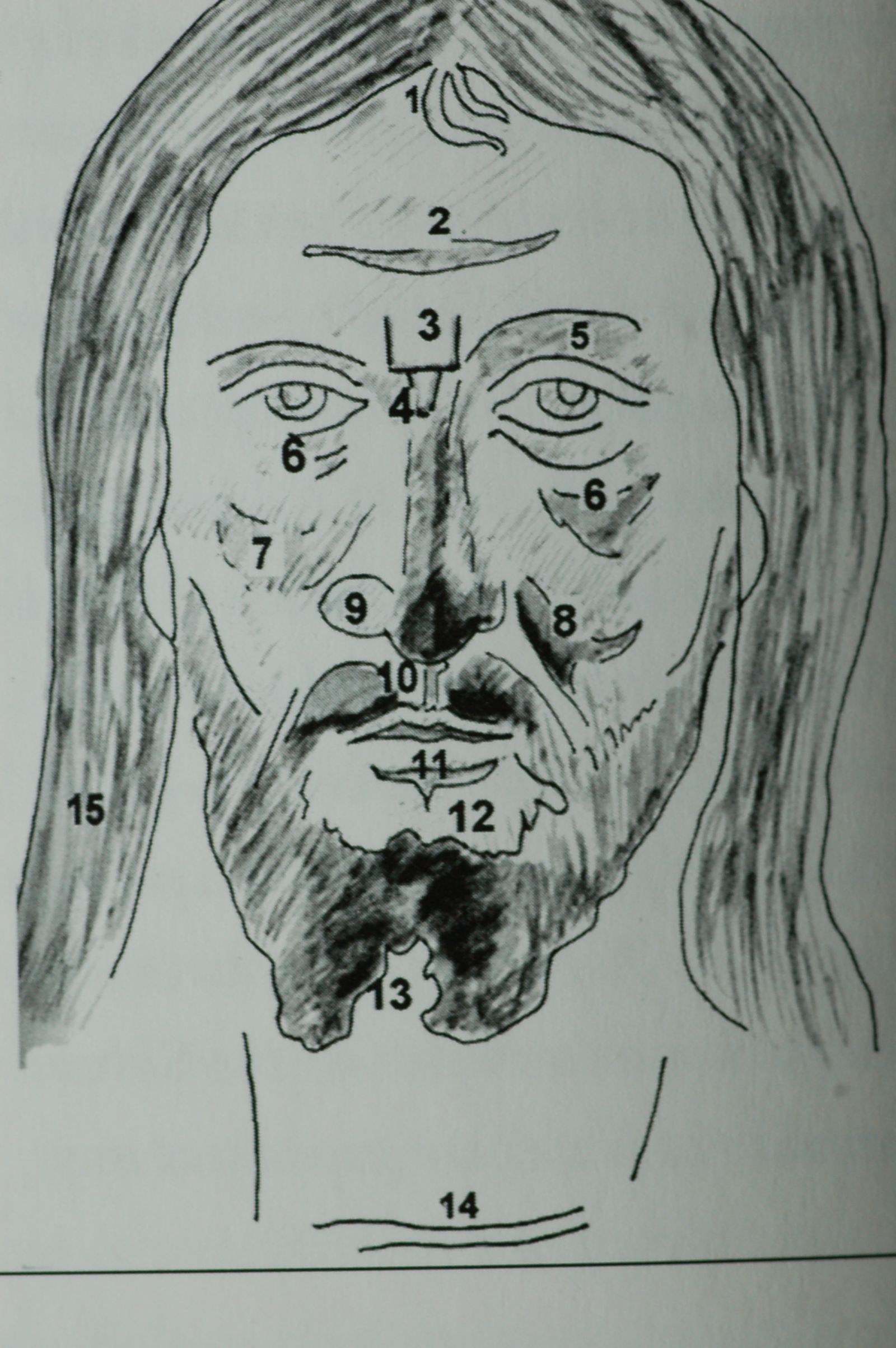
Photo 20. Vignon markings (see 6)
What is of interest here is the number fifteen of the markings that VIGNON mentions. This is described by him as: ———Transverse line across the throat—–. Now this is exactly the area where I concentrated my research, because according to my investigations in the 3D field there was an oval solid object present there with on the surface in relief three Hebrew letters. I first did a study on many photographs from different photographers who took photographs the last hundred years of the Shroud and there was always the outline of the object. Next, I studied all the previous 3D studies done by John JACKSON and Eric JUMPER in 1977, and also the 3D studies that were done in Italy in the seventies by Prof. TAMBURELLI and Nello BALLOSINO. In all the 3D images under the beard there was a clearly visible vertical relief suggesting that indeed there was the presence of some solid object. Last, but not least, Pete SCHUMACHER did an investigation for me in 2010 of this area with his VP-8 Image Analyzer, an investigation that we repeated together in 2011,to prove the presence of the solid oval object under the beard. The VP-8 Image Analyzer was used in 1976 by JACKSON and JUMPER to finally prove with success the existence of the 3D information in the Shroud Image. This instrument translates differences in density of an image in vertical relief. Only the image of the Man of the Shroud gives an anatomically correct 3D image. Any other photograph of a person gives a lot of fattening and distortion because this instrument was not made for that purpose. Another unique quality of the Shroud Image!!
The conclusion of Pete Schumacher was:
“Using minimal classification Image Processing Techniques involving isometric projection and level slicing functions of the VP-8 Image Analyzer we were able to assess the region of interest (ROI) defined by Dr. Soons. It is apparent that some object, having some pattern detail within that object, resides within the defined ROI. Pete SCHUMACHER was able to confirm the presence of the image outline of an object within the ROI.”
This oval solid object was placed under the beard of the Man on the Shroud and because of the anatomy in that region with the two collar bones higher than the throat area in a person in a horizontal position, the object was in an oblique position.
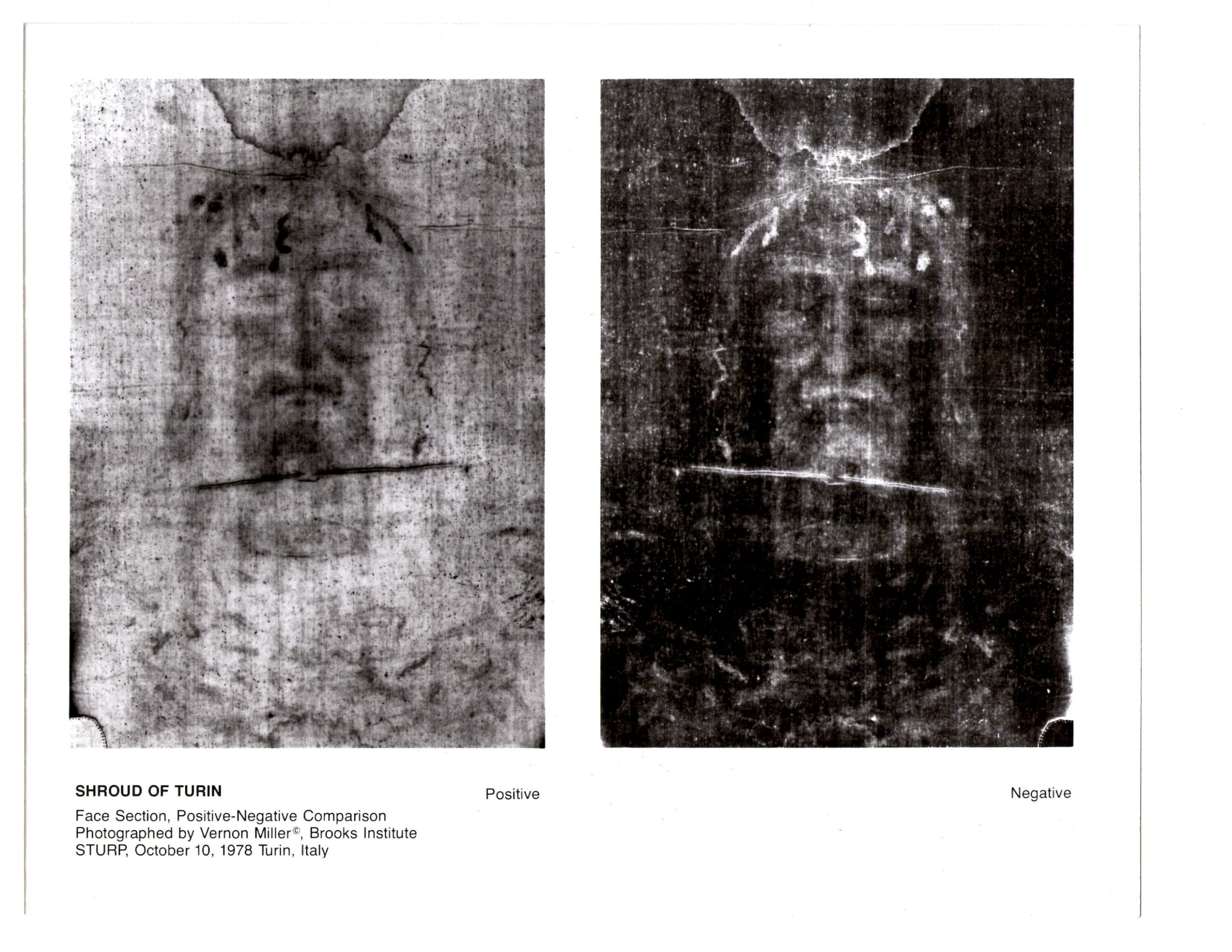
Photo 22. Vernon Miller positive/negative image |
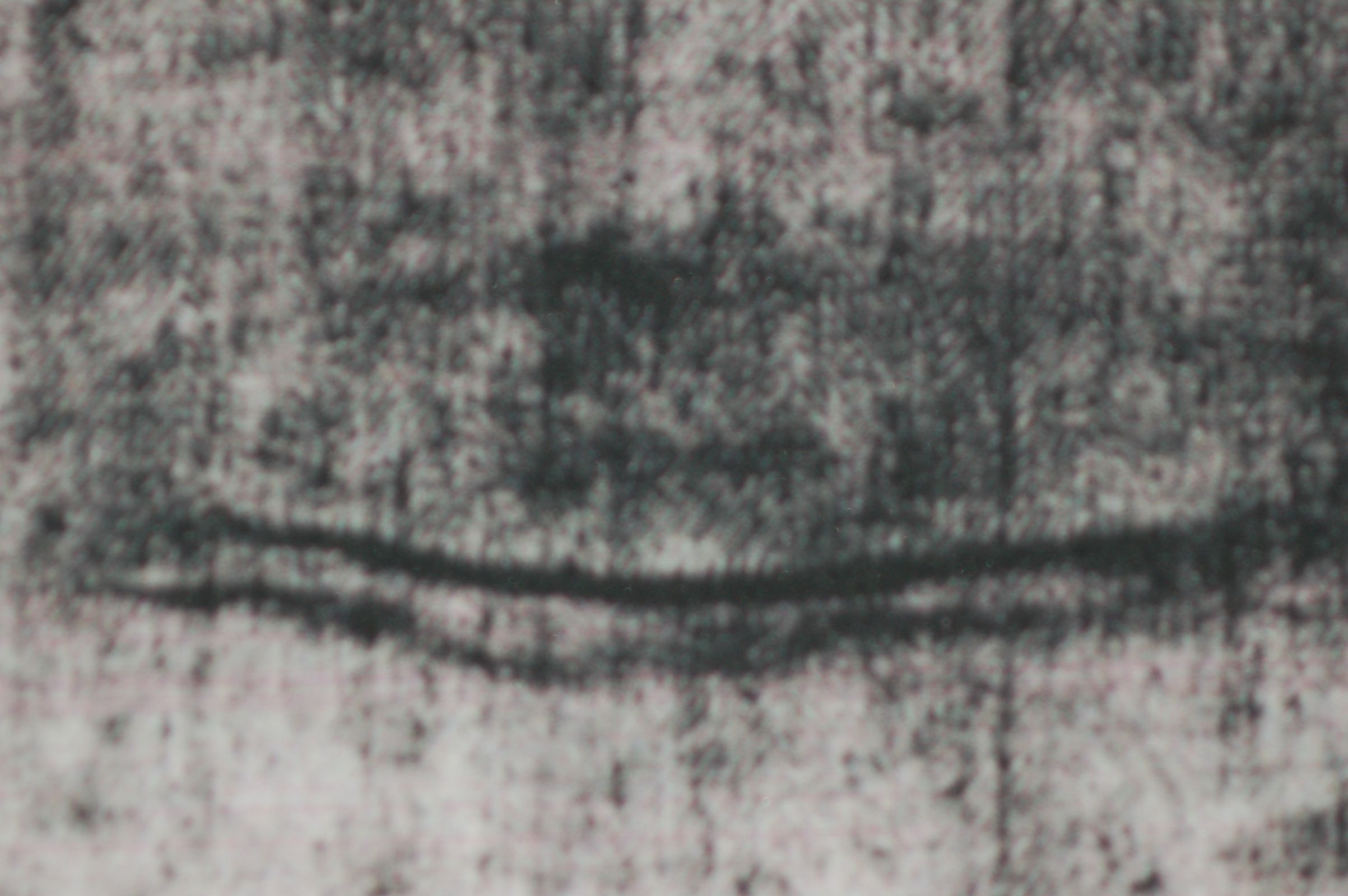
Photo 23. Outline solid oval object |
Scientist believe that the image was formed collimated, meaning vertical up- and downwards, so that the front and under side being higher and nearer to the cloth, would be projected with a double line because of the thickness of the oval object and the upper side like a vaguer visible line because of a further distance to the surface of the Shroud, and that is exactly what we observe in the image under the beard in the photographs.
In the HALO POWERPOINT PRESENTATION we show a series of coins of the period of the reign of Justinianus II (692-695 D.C.) and also several coins from the reign of Emperor Michael III (842-867 D.C.) were this double line is perfectly visible and interpreted by the artist as the upper edge (hem) of a tunica. It is worth mentioning that these gold coins are the size of a quarter, so the artist put in very tiny details that obviously were taken from studying the Shroud Image very detailed.
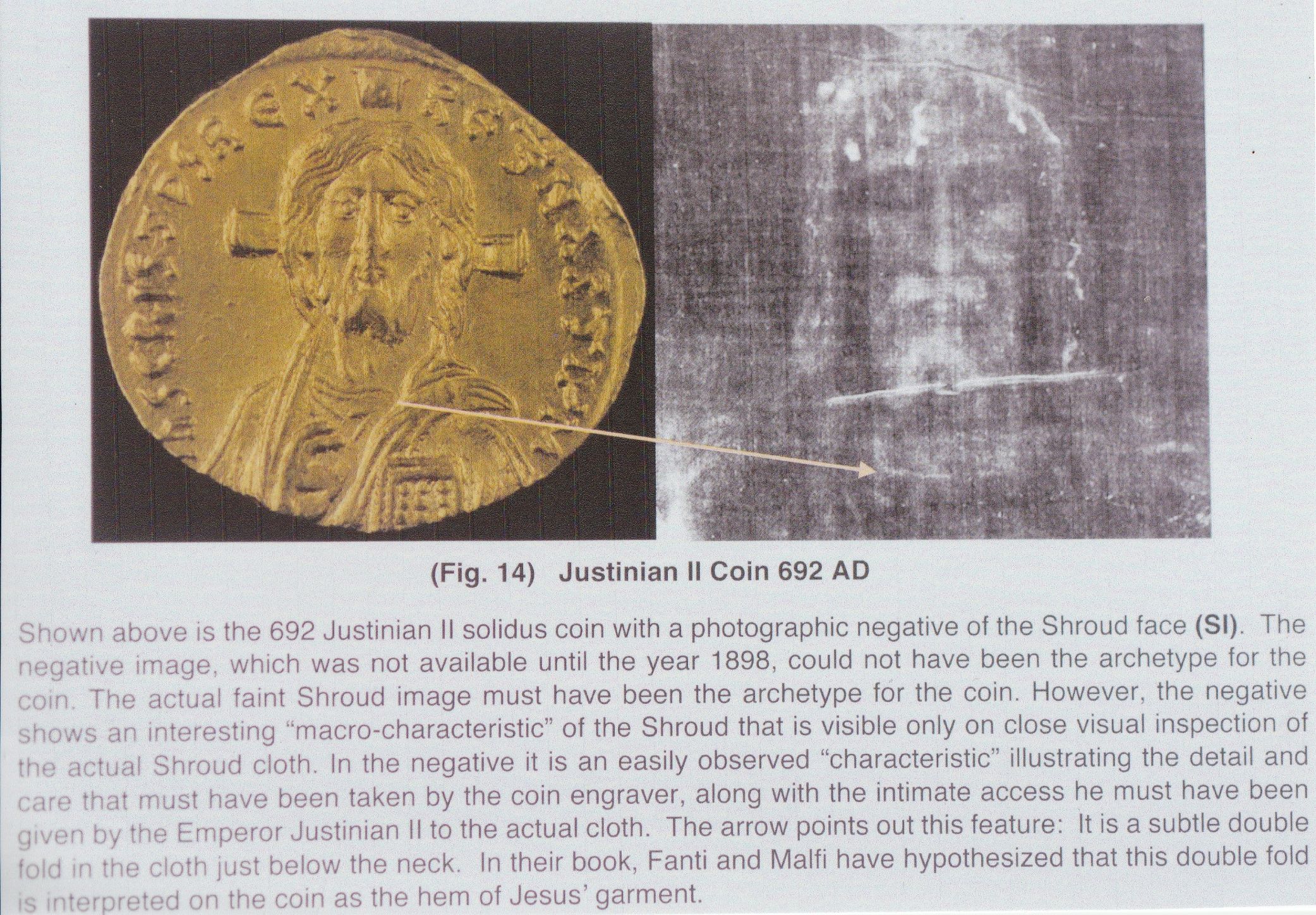
Photo 27. Solidus coin and text John Jackson |
Photo 28. Pantocrater Icon |
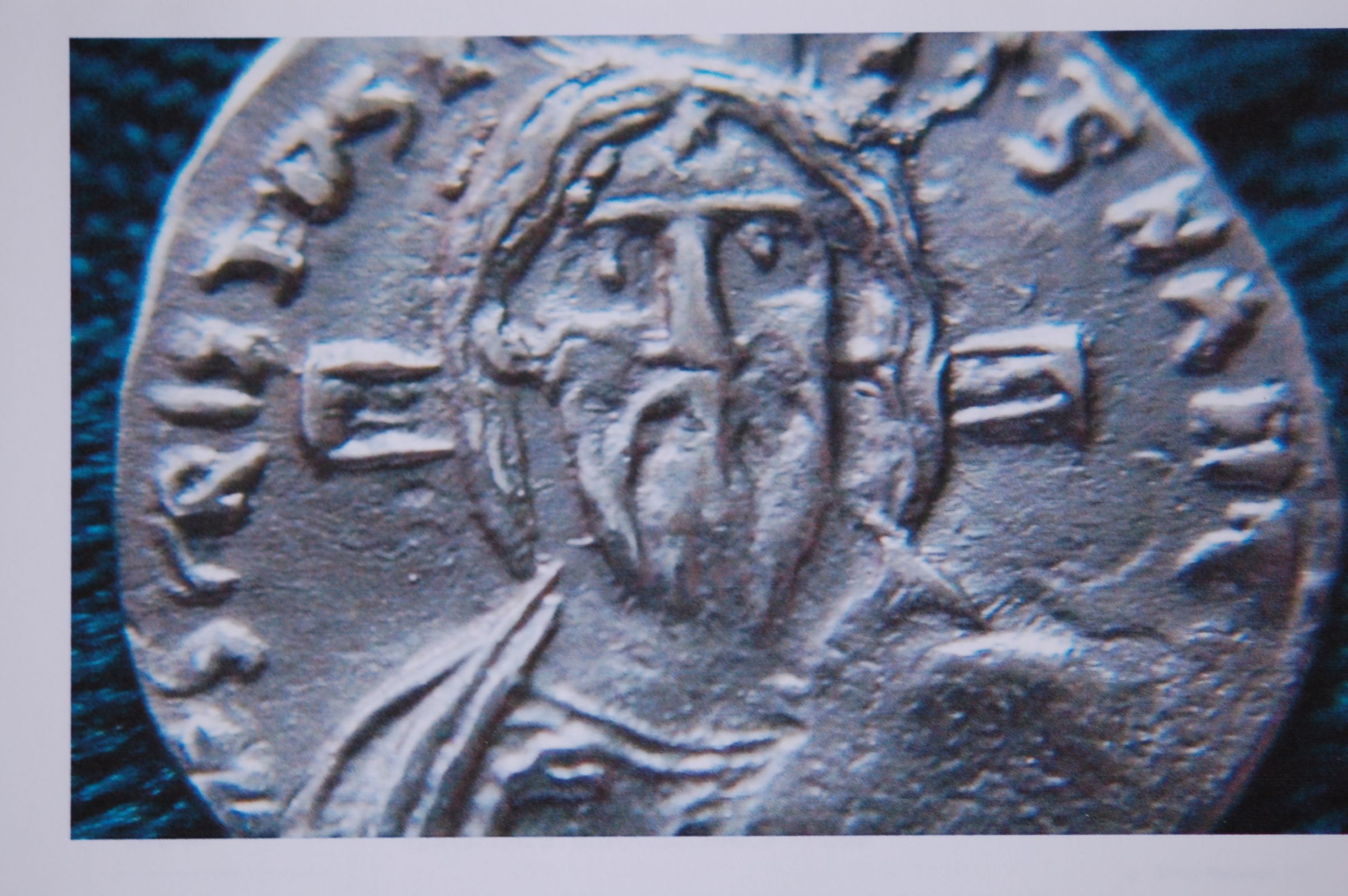
Photo 29. Solidus coin Justinianus |
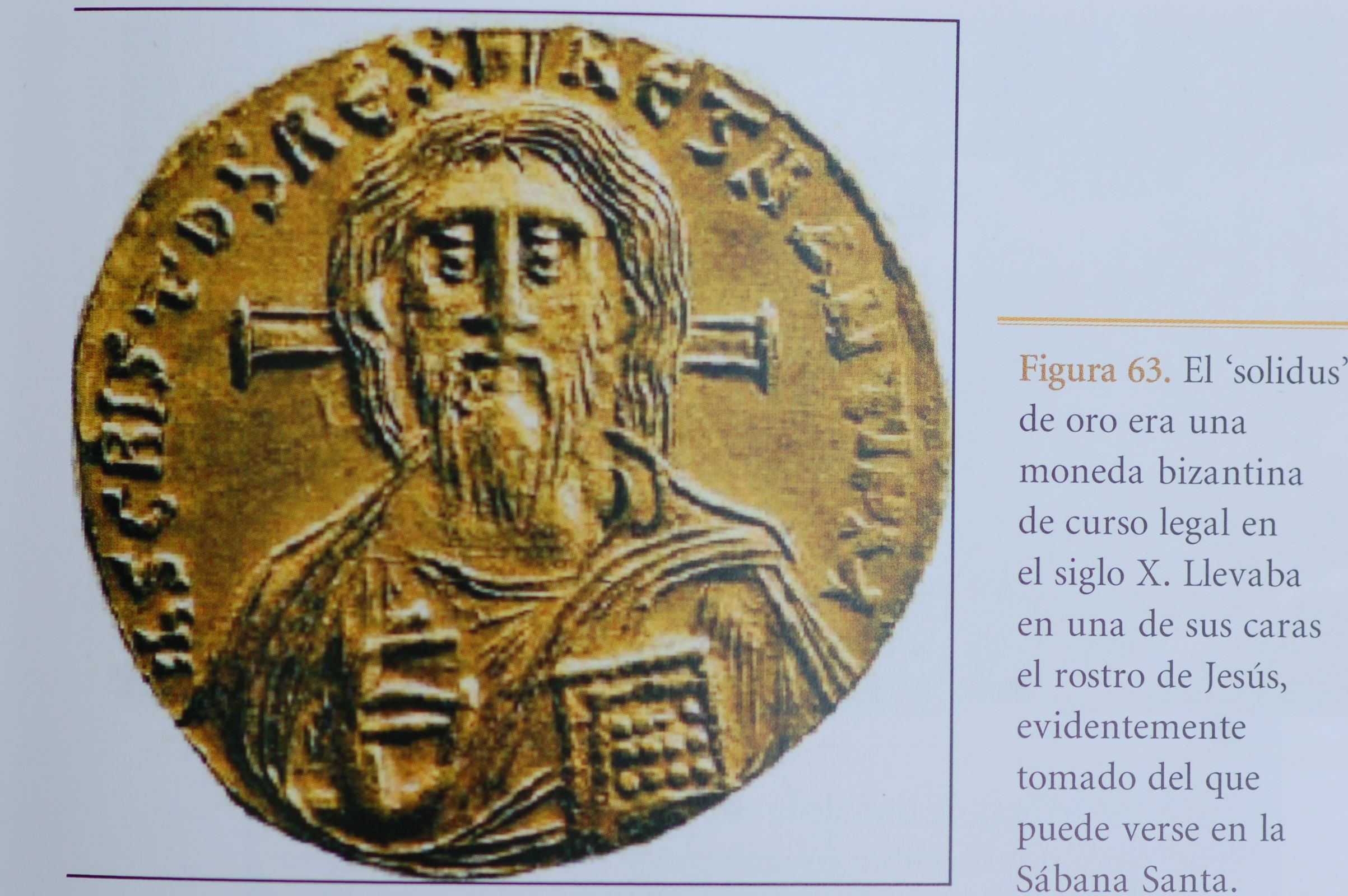
Photo 30. Solidus coin Bizantine |
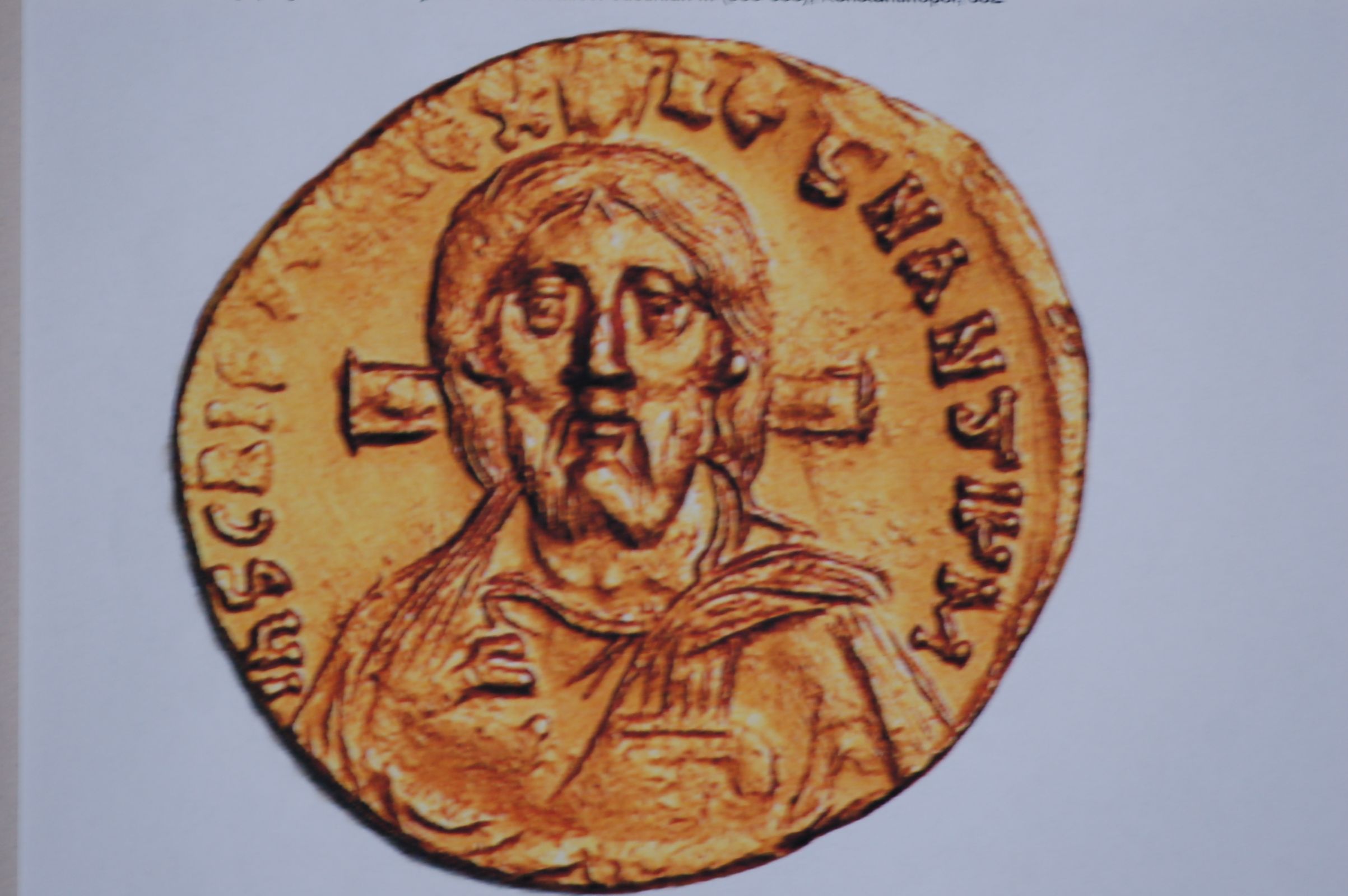
Photo 31. Solidus coin Bizantine
THE SECOND DETAIL VISIBLE OF WHAT VIGNON CALLS “THE TRANSVERSE LINE ACROSS THE THROAT” ALSO ASKS FOR OUR ATTENTION.
In the positive image of the Shroud the left corner on the end of the horizontal transverse double line curves in an upward direction and was seemingly interpreted by the artists who had access to the image, as a fold in the upper edge (hem) of a tunica. The same seemingly happened with the double line that was interpreted by the artists as the upper edge of a tunica. It is worth mentioning again that the head on the Mandylion looks disembodied and floating because there is no image visible of the upper thorax. There are many examples in Byzantine art where this “fold” is being represented in exactly the same location where in the positive image of the Shroud the upward curving left corner is located. All these little details make the case of Ian WILSON very strong indeed!
Photo 24. Icon Jesus Christ |
Photo 25. Icon Jesus Christ |
Photo 32. Icon Jesus Christ |
Photo 33. Icon Jesus Christ |
![]()
Photo 34. Icon Jesus Christ
CONCLUSION OF MY INVESTIGATIONS:
IAN WILSON’S THEORY THAT THE CLOTH OF EDESSA AND THE SHROUD OF TURIN ARE ONE AND THE SAME IS BEING REINFORCED BY THESE NEW DISCOVERIES:
1) The HALO found in various photographs representing the area of the round opening in the TETRADIPLON and showing the head of the Image of the Man on the Shroud, proven by the studies that were being done in 2013 by Schumacher and Soons.
2) The center of the circle of the round opening in the TETRADIPLON. The center is located in the corner of the right eye (positive image). This is also seen in the images of the Mandylion and the face of Jesus Christ with HALO in Byzantine art. Also proven by the studies of Schumacher and Soons.
3) The transversal double line under the beard of the image with the upwards going left edge, interpreted by the Byzantine artist as the upper edge of a tunica with an upward going fold on the left side and also encountered in Byzantine coins, icons, mosaics and other images of the face of Jesus Christ.
All these new discoveries prove that Ian WILSON is right with his theory that the Cloth of Edessa and the Shroud of Turin are the same. This dates the Shroud of Turin back to at least the year 525 A.D.
This also proves that the sample that was used for the Radiocarbon Dating of 1988 was not representative for the whole Shroud of Turin.
Click to see HALO POWERPOINT PETRUS
*To return close tab
STUDY of SHROUD FEATURE EVIDENCE USING VIDEO and PHOTOGRAMMETRIC
ANALYSIS METHODS
a.k.a. “THE HALO STUDY”
By Peter Schumacher and Petrus Soons
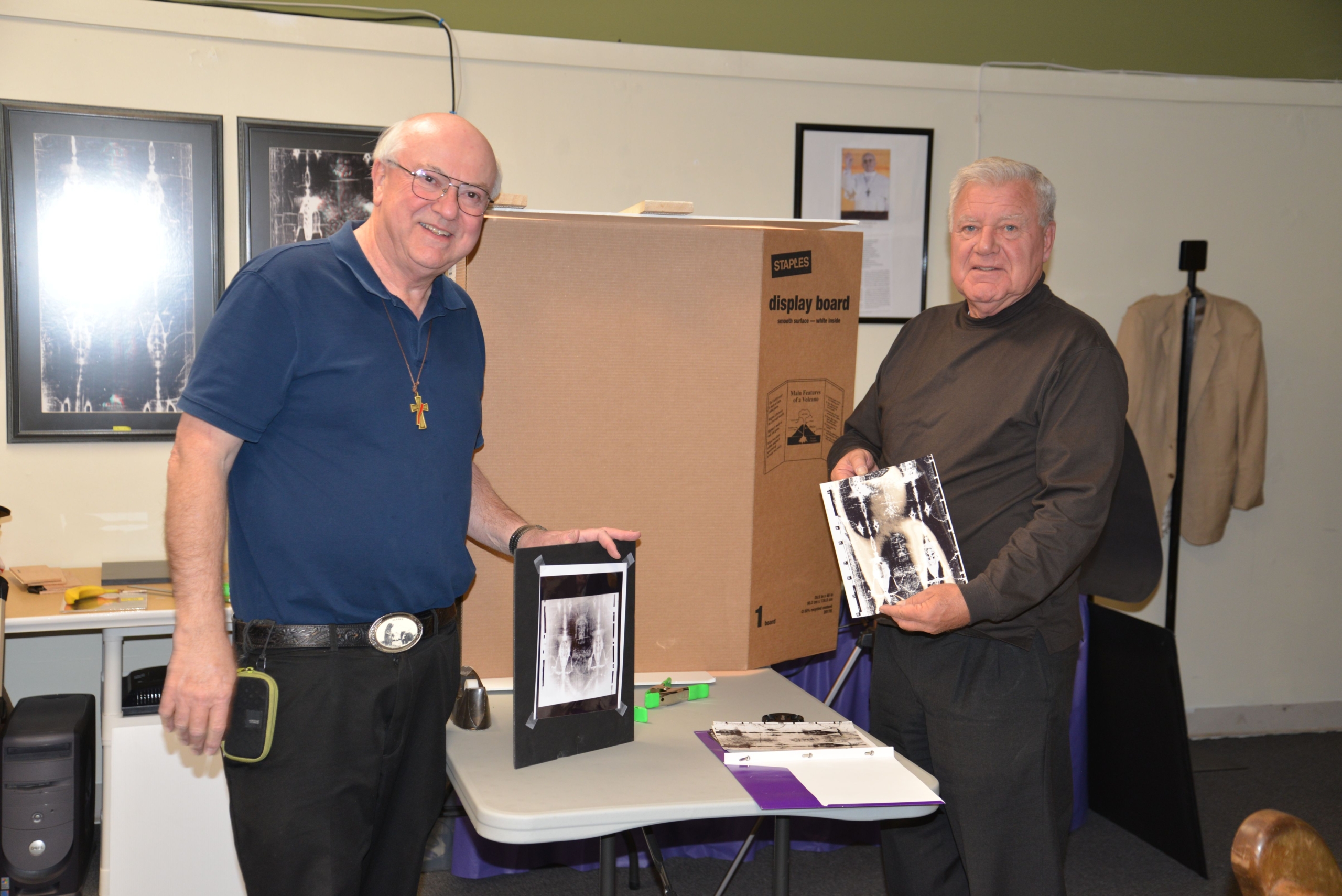
Photo F. Pete Schumacher and Dr. P. Soons during HALO research
In December of 2013, Dr. Petrus Soons and I began a study of the Shroud of Turin with a particular focus on the area around the face of the “Man of the Shroud”. It had been observed by Dr. Soons that there appeared to be a difference in shading surrounding the face that was perhaps coincident with the Mandylion representations in artworks and that further study might provide a more conclusive determination as to actual Shroud image properties and such content in artwork representations of the Shroud.
The study was undertaken at the Shroud Exhibit and Museum located in Alamogordo New Mexico that has been reopened in another location in the old town of Alamogordo by the end of November 2014.
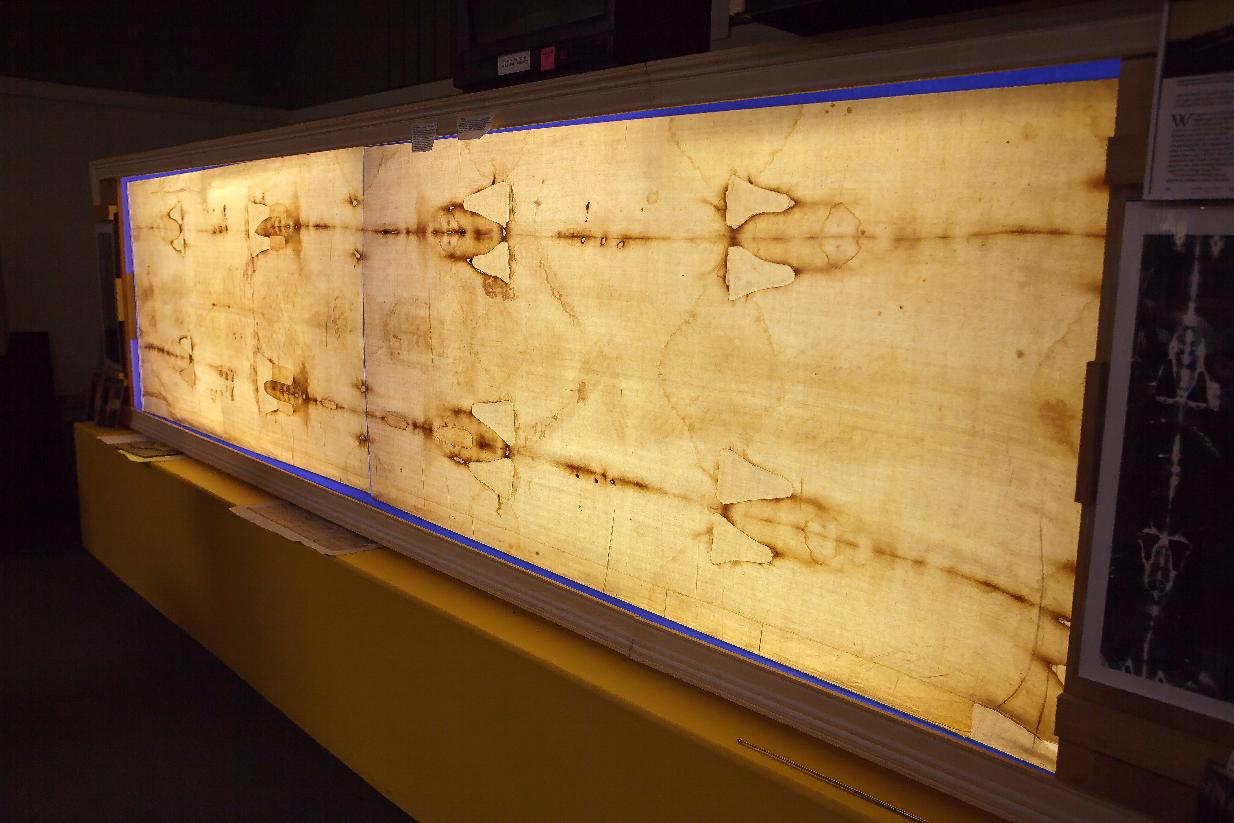
Photo A1. Fascimil Shroud, Barrie Schwartz
The primary image used was the 1978 full-size color image on Kodak Duratrans film purchased from Barrie Schwortz in 2009. It is illuminated by proper color temperature diffuse lighting. The display fixture was custom designed for the specific purpose of image analysis.
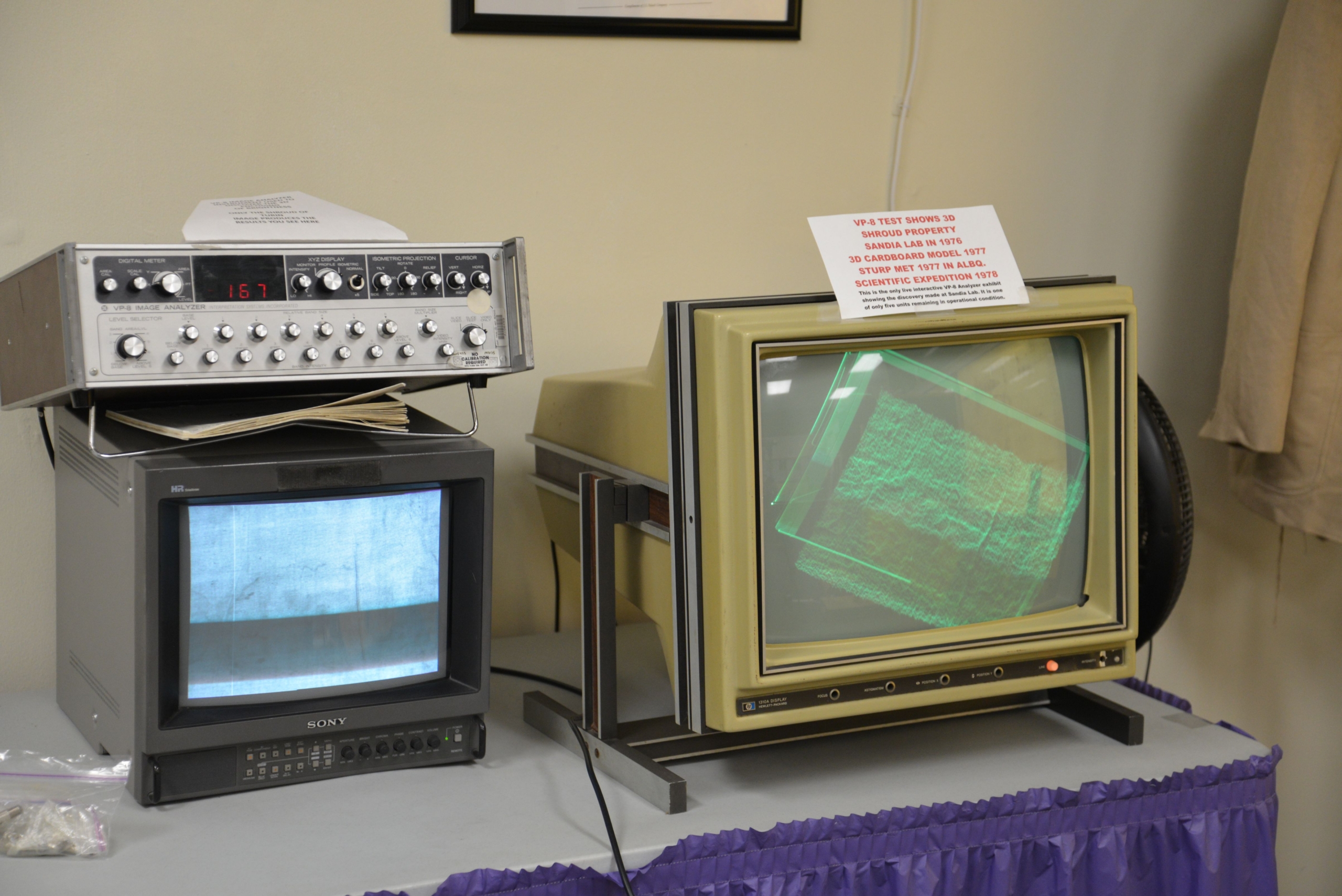
Photo E. VP8 Image Analyzer
A VP8 Image Analyzer system was used in one element of the study. This is the same equipment used by Captains Jackson and Jumper in 1976 to make a model of the Man of the Shroud. However, this type of equipment is relatively inaccessible to other investigators. Furthermore, this is an analog system and tolerance variables are difficult to duplicate. Higher accuracy is now available through digital images and processes, though this does not negate the value and importance of proper analog analysis.
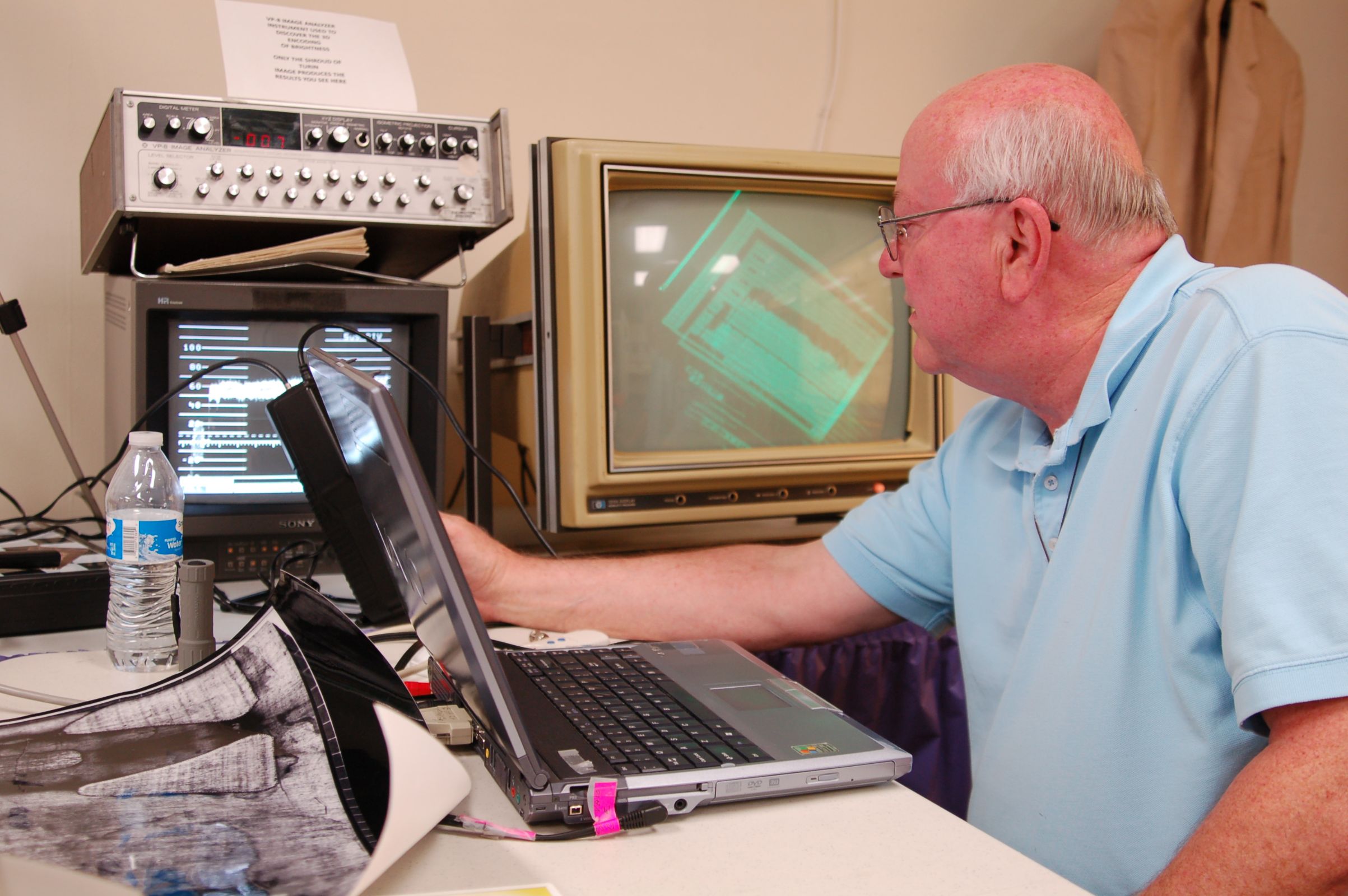
Photo A2. Schumacher with VP8 Image Analyzer
I used multiple digital and analog analysis methods to compare study results. I wanted to insure, that it would be possible for others to duplicate the work, assuming they are experienced in the practices necessary to digitize images properly from photographs and to perform subsequent digital analysis. The digital capture process is critical and essential to the quality of the studies.
Dr. Soons provided some of the images used in the study. Others were provided by the Shroud Exhibit and Museum archives. The ambient room light was eliminated, and reflections prevented by controlling the camera-to-image path, in the case of backlit transparency images, and the light-source-to-print-to-camera path in the case of photo- graphic prints. Images by Enrie, Schwortz, Miller, and Rogers were among the images studied. Not all are included here for the purpose of brevity.
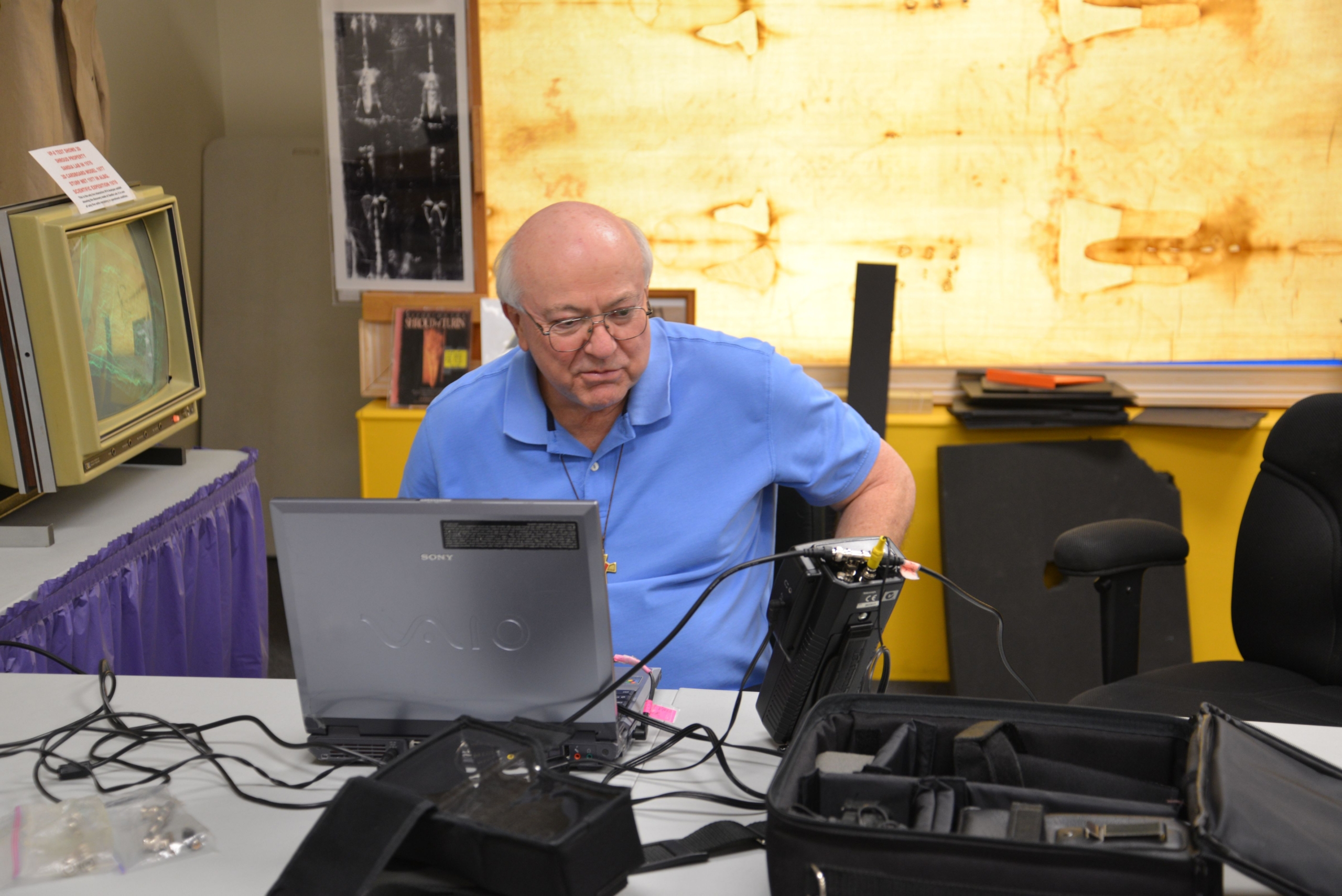
Photo A. Schumacher during research |
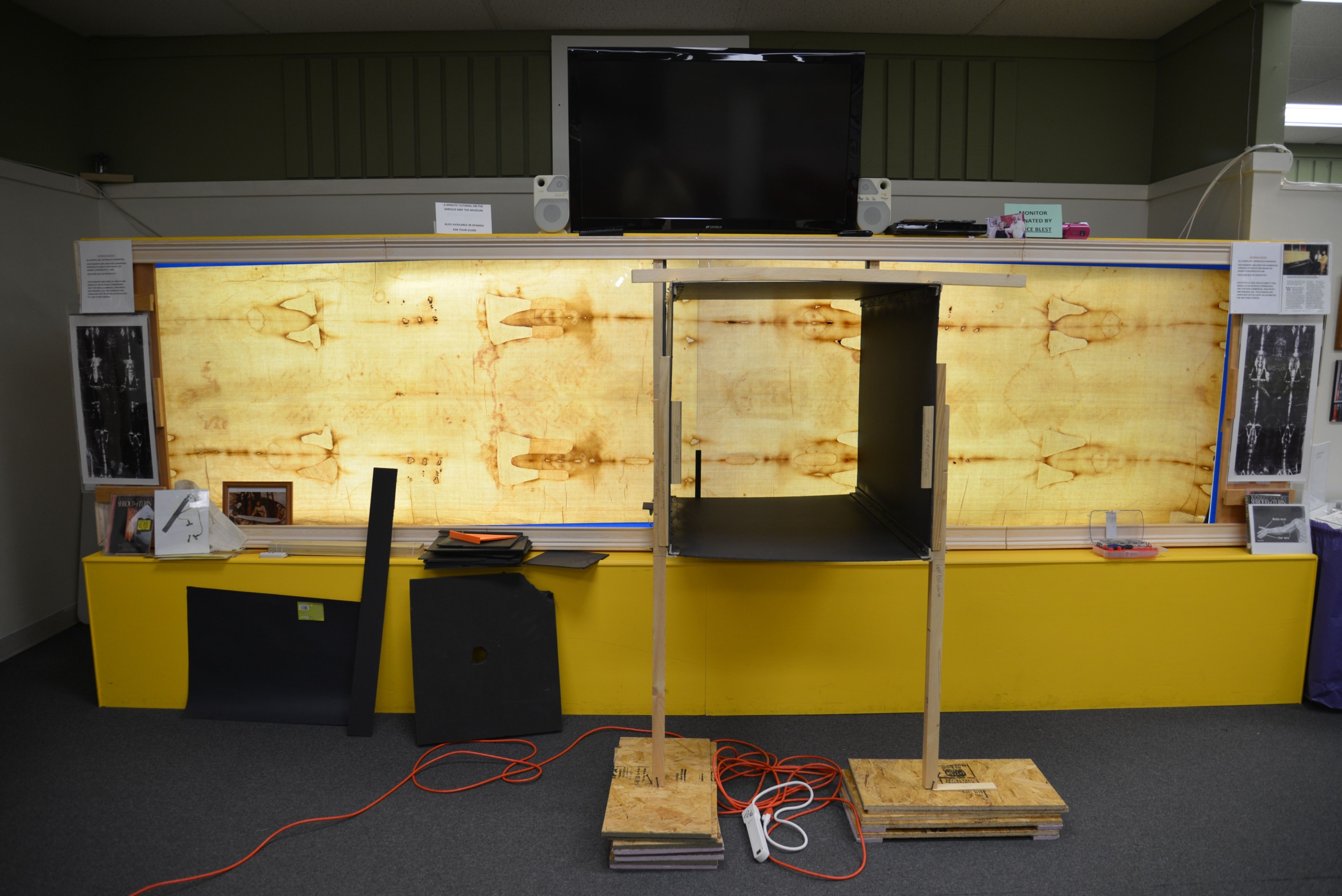
Photo B. Preparing research set-up |
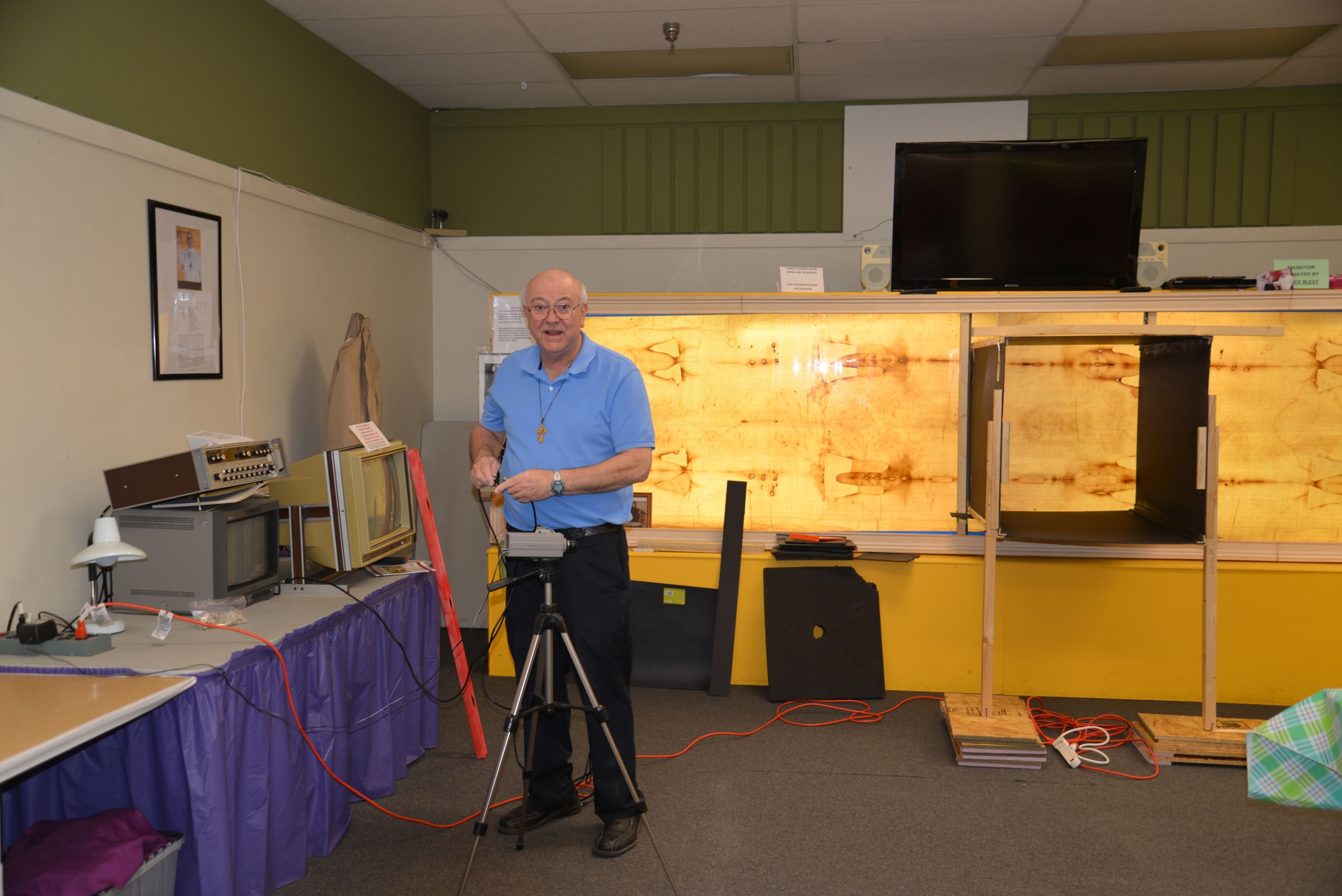
Photo C. Preparing research set-up |
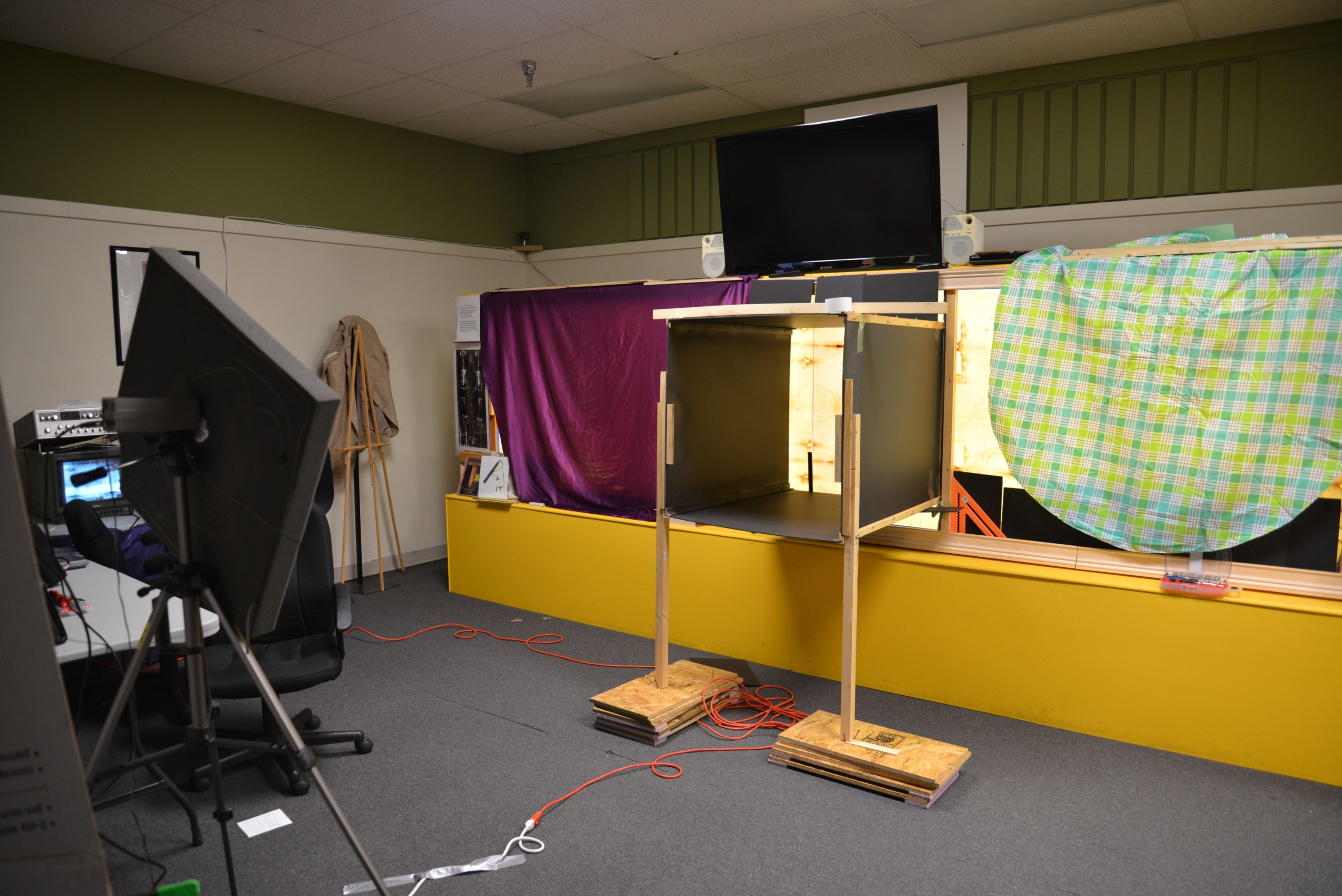
Photo D. Preparing research set-up |
The Schwortz flash photograph of the Barrie Schwortz image shows the “region of interest” (ROI) for the primary shading and features study. Note the reflection of the flash in the image. Obviously, this would not be a good photograph to use for the study. It is simply used to record the ROI selected for the study. Room lights were turned off and opaque flat black panels and black foam rubber was used to block any light other than the transmitted light coming through the diffuser and the transparency.
The video camera automatic gain and black level functions were turned off and the linearity was set to gamma 1.0 in order to produce a linear image density (brightness) response from the camera. The resulting image was processed through the VP8 Image Analyzer. (The following images 10, 12, 13, and 18 refer to POWERPOINT PETE THAT COMES ON THE END OF THIS ARTICLE) Image 10 is a photograph of the orientation of the ROI as it appears on the color video monitor. The banding and discoloration results because the photographic camera shutter exposure is not synchronized to the video scanning of the monitor. It used only to record the current step in the process. The same is true of the isometric negative plot displayed on the X-Y-Z display (bright is down and dark is up).It is important to note the shading appears similar to a “dish” or “basin” surrounding the face.
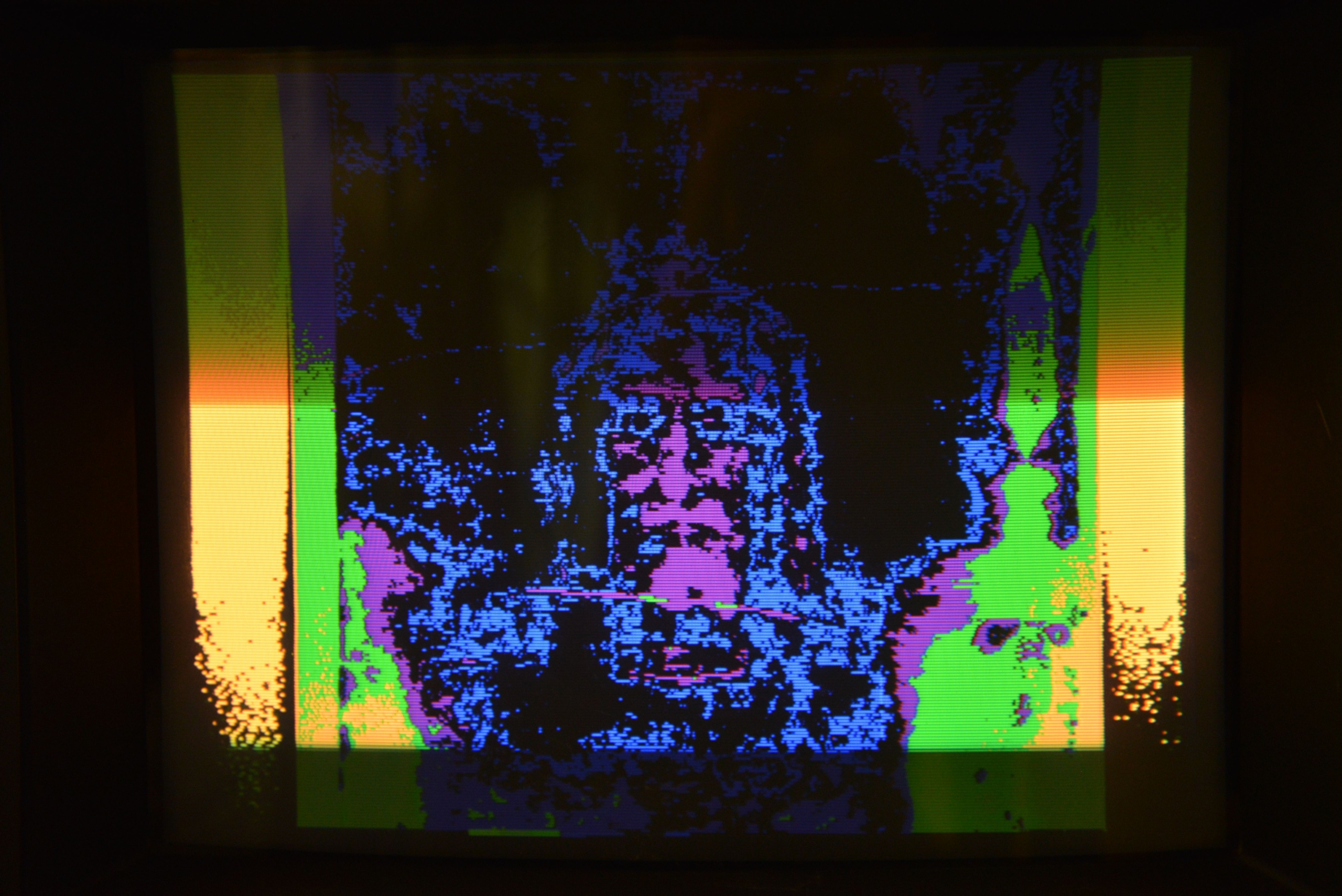
Photo Q |
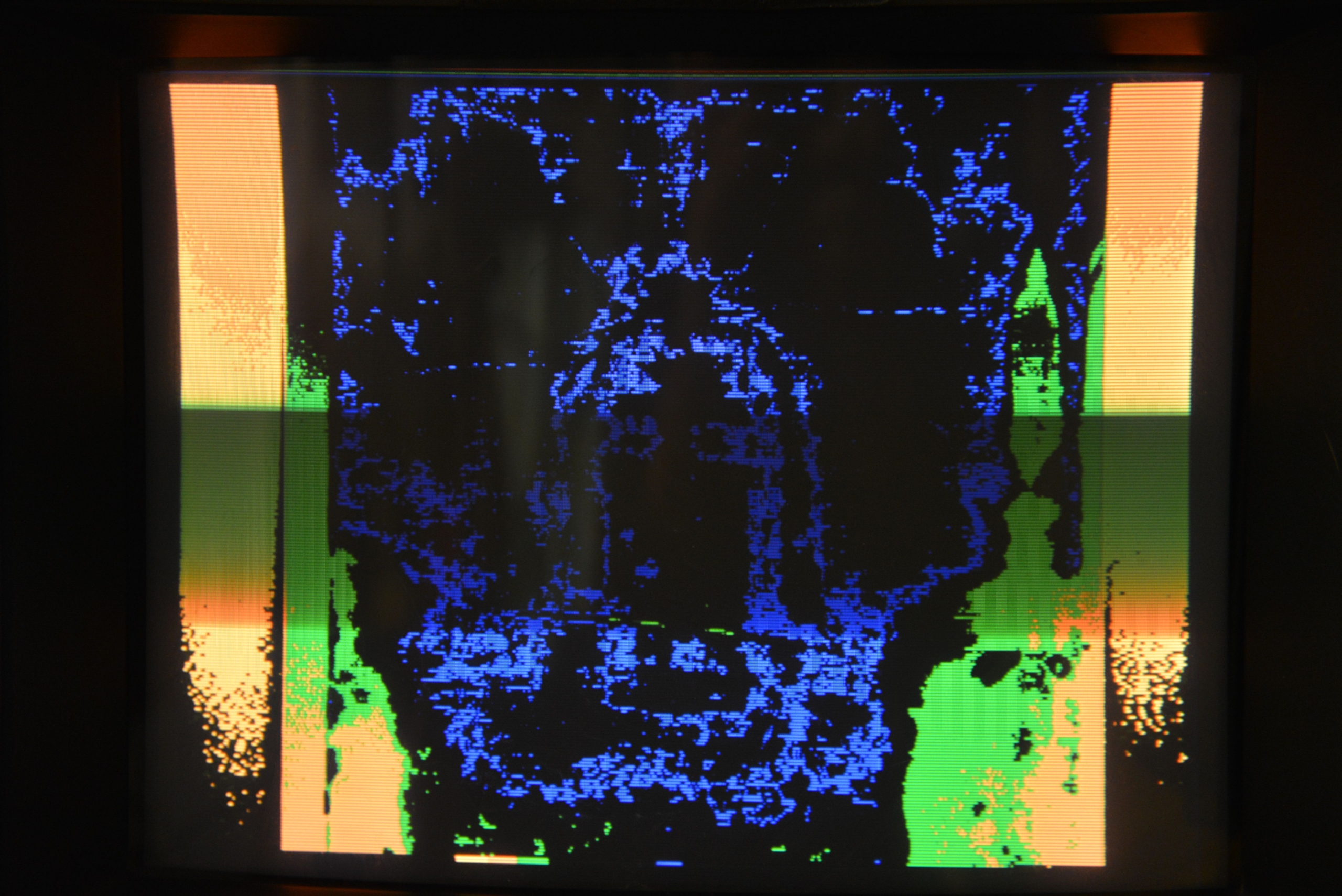
Photo R |
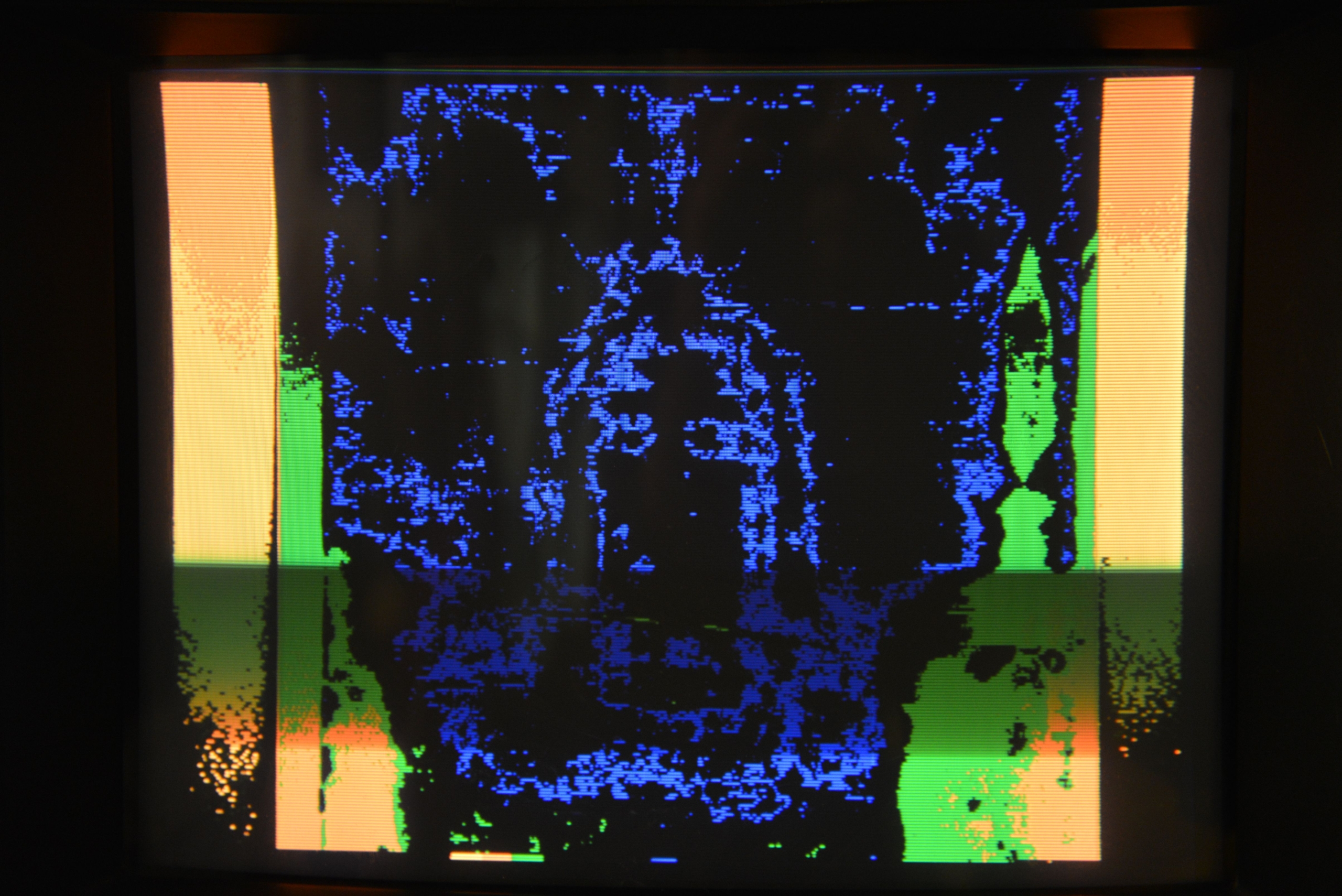
Photo S. Monitor with outline Halo
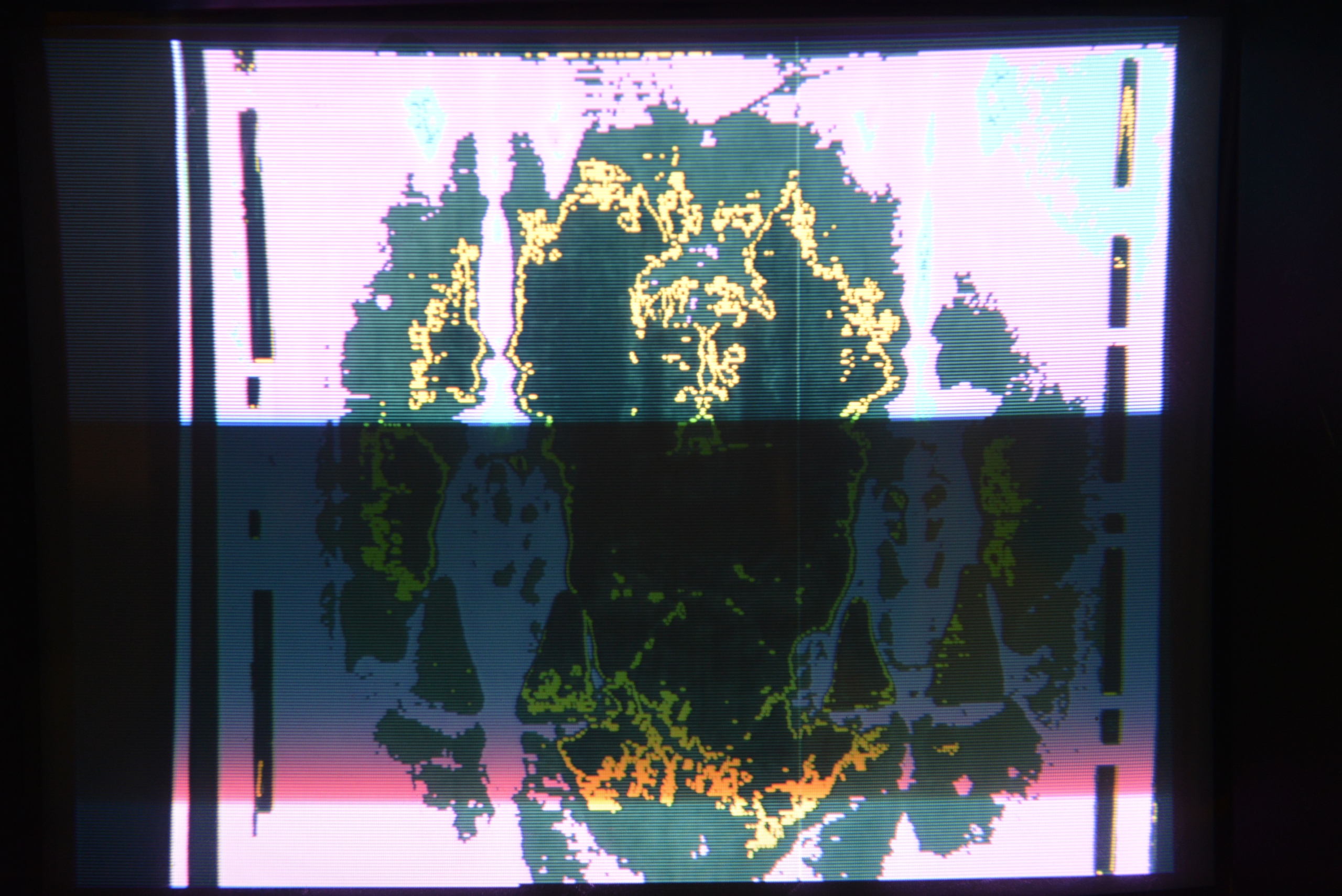
Photo N. Monitor image Halo |
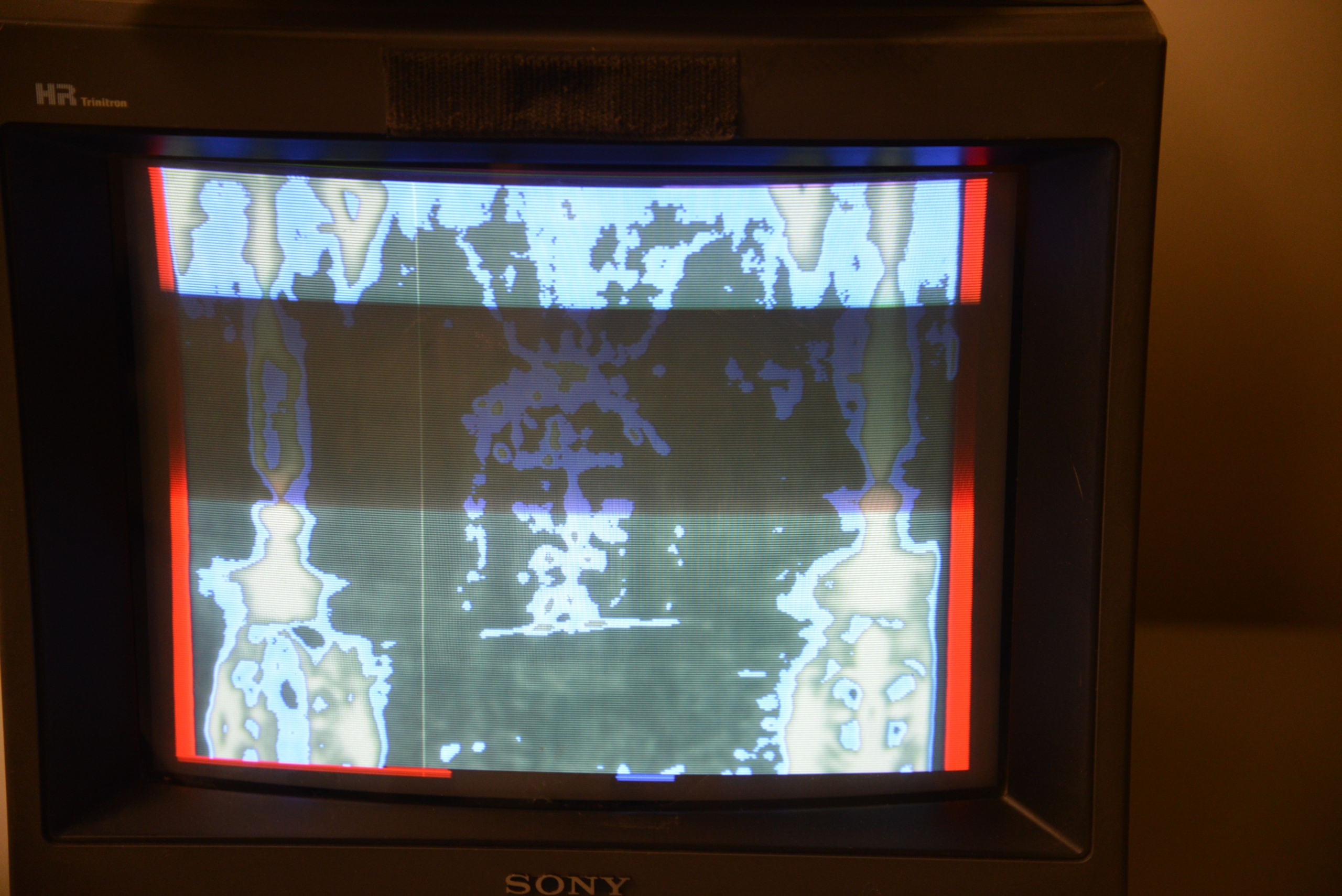
Photo H. Monitor with image Halo |
Image 12 shows the profile of the VP8 vertical cursor, a line selected from the image going from top-to-bottom across the TV screen where it crosses the top of the head. In this positive line plot, it clearly shows a parabolic response with the darker segment (downward) in the middle, being the image densities at the top of the head, and the brighter (upward) densities being on either side of the Shroud head image segment.
Image 13 shows a density slice of another image with the ROI orientation with the top of the head toward the top of the video screen. Density slicing is a means to group a brightness range and assign a color to it. The “VP8” is so named because eight different range groups can be selected and assigned one-to-each of eight different colors. Those can then be displayed or set-to-black using the level slicing controls. In this case, the photograph of the monitor records a unique shading group that surrounds the facial area of the Shroud image. This repeatedly occurred in tests using various photographic and spectral images and dating from Enrie’s photographs of the 1930’ to STURP images from 1978. This shading is proven to be consistent and contiguous over a significant range of brightness and physical surface area surrounding the head of the image on the Shroud of Turin.
This image feature, extracted by image analysis, was then compared to Dr. Soons’ visual observations to determine of what he had mapped with a paper circular cutout was coincident with the density analysis using the VP8 Image Analyzer.
I generated a graphic circle and crosshairs and placed dots over the eyes and at the tip of the nose. These were grouped as single object which could then be overlaid onto other images and scaled to common size for comparisons, and even mirrored,
(flipped left-to-right) for use with photonegatives. As seen in image 18, the match is nearly perfect. Any errors in placement can be accounted for by the lack of contrast in the paper-circle image and non-parallel image surface to camera sensor (film) surface when the circular paper cutout image was made. Other examples are shown based on some of the other origin images tested. All produced significant demonstration of the ratio of shading above the face to the area of shading below the face and to the center positioning of the circular shaded area related to the position of the facial image within that circle.
Similar results were produced using “GIMP 2”, an open source analysis application. Those tests led to other analysis, using a digital image by Barrie Schwortz, in addition to the photographic prints and transparencies tested.
I employed the Gaussian edge detection process in GIMP 2 to extract the edge features (transitions of brightness levels) within the ROI. I was amazed to find the outlined edge features below the face extracted from the surrounding image and features were consistent with the primary and other observations declared by Dr. Soons.
Final graphic overlay tests: I ran comparisons using two additional target markers. I found the features to be consistent with the analog and digital density slicing studies and all the observations of Dr. Soons concerning the circular “HALO” area relative to the face; the “double edge” line; and the “object below the face”. The graphic target was then used to compare Shroud features within artworks (Icons) as declared in the works of Dr. Soons. These were demonstrably accurate and identical by relative size, angles, and positions, and exactly as predicted and described by Dr. Soons.
Using a TV Waveform Monitor, an instrument common and universal to video signal standards testing, I ran a series of tests to plot the brightness (density) of images one-line-at-a-time. This resulted in line-by-line extraction of brightness variables, similar to the output of the VP8 Image Analyzer. It is also similar, to the output of a scanning photo-densitometer.
The results were recorded in bit-map file format (.bmp). This clearly demonstrated the parabolic shape of the area surrounding the head of the Man of the Shroud. It will also make it possible to make a physical model of the brightness variations in a manner similar, though perhaps not equal, to the model made by Jackson and Jumper. While that is yet to be determined in further work pending the reopening of the Shroud Exhibit and Museum, it is certain that a video waveform monitor can be used with proper camera and image acquisition management to duplicate this particular feature of the VP8 Image Analyzer. The display is not an “isometric display” and it does not produce a real-time interactive “3D” display of image brightness as does the VP8. However, it is common to the art of video and universal to applied signal standards.
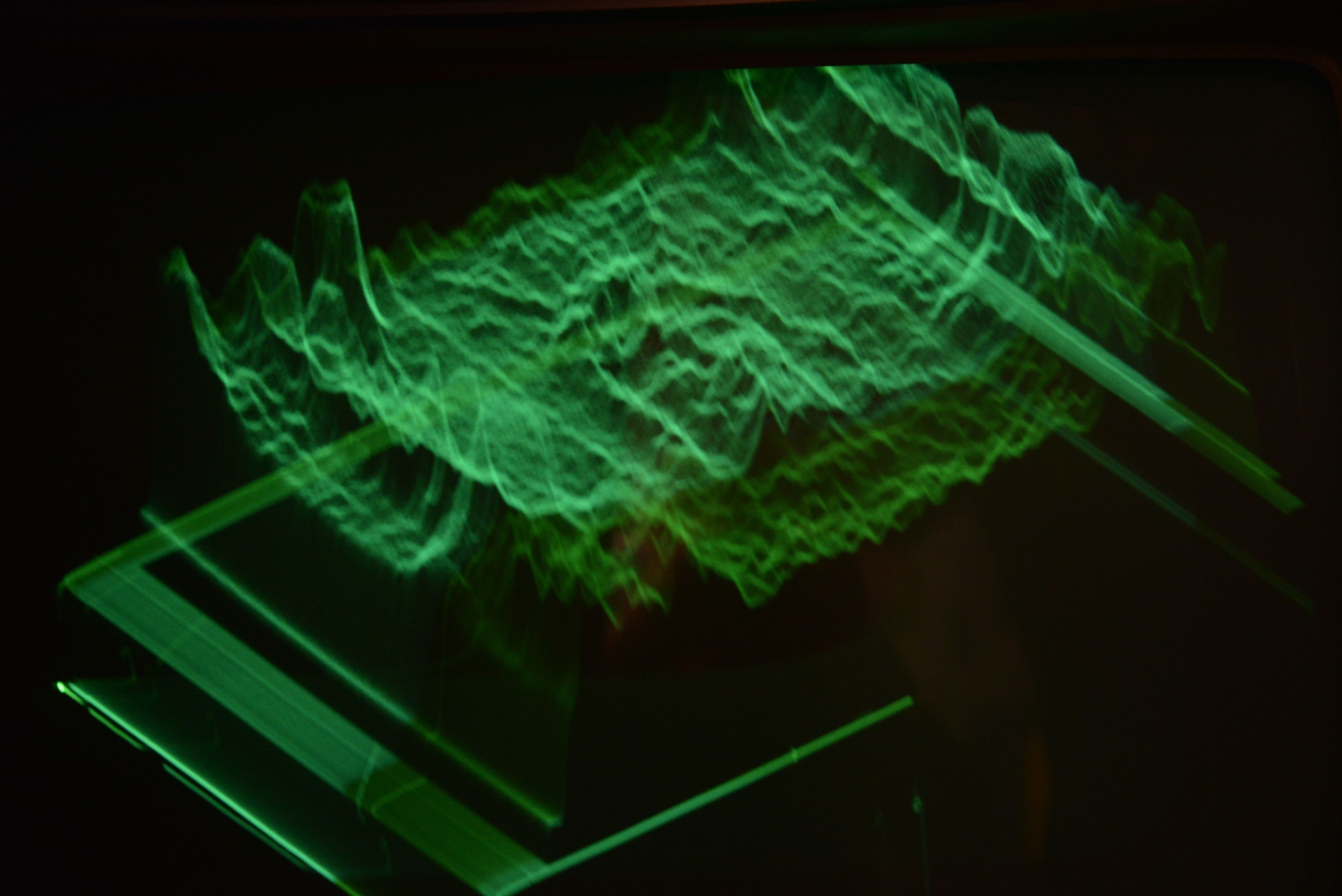
Photo G. Image head VP8 |
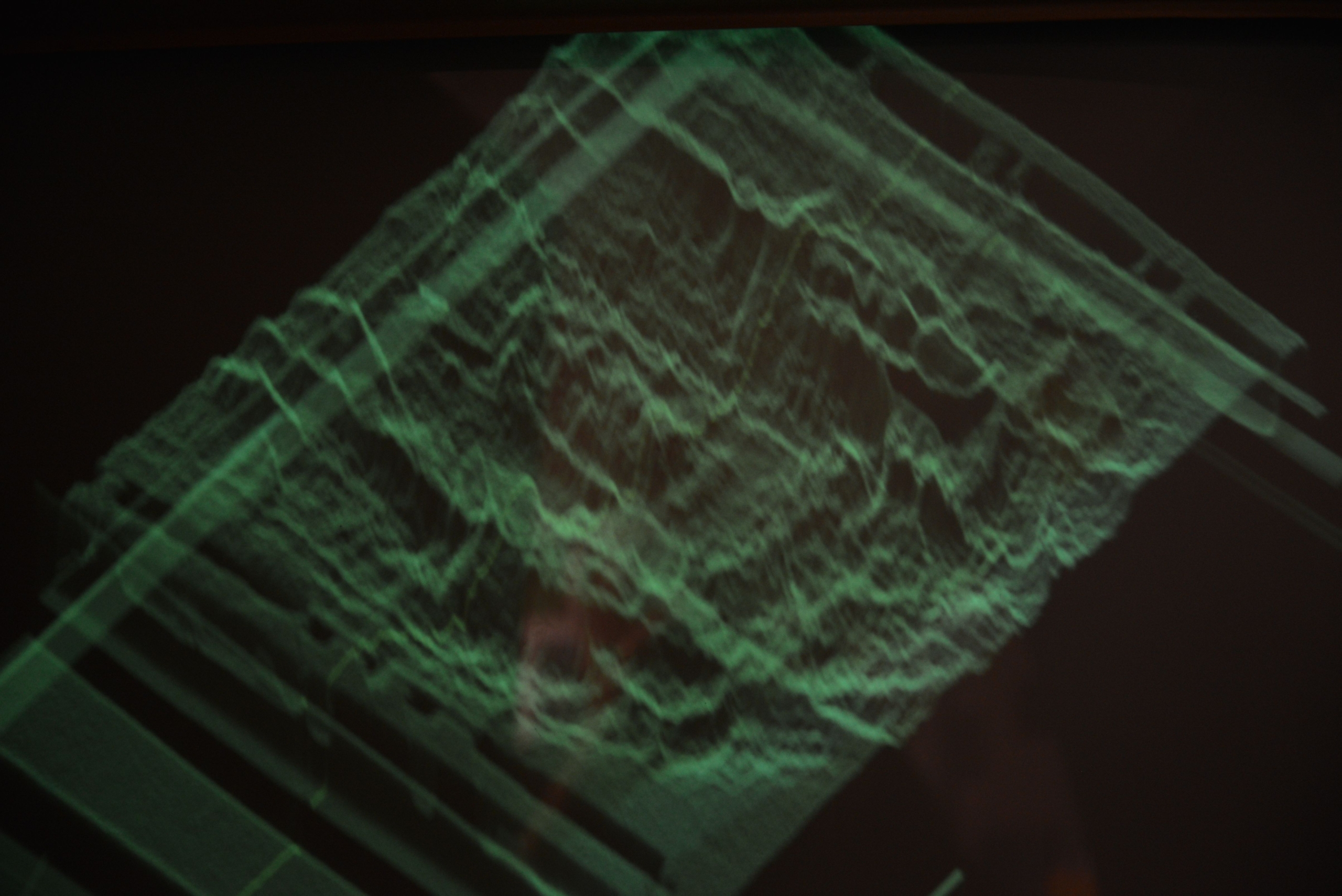
Photo M. VP8 Image Halo |
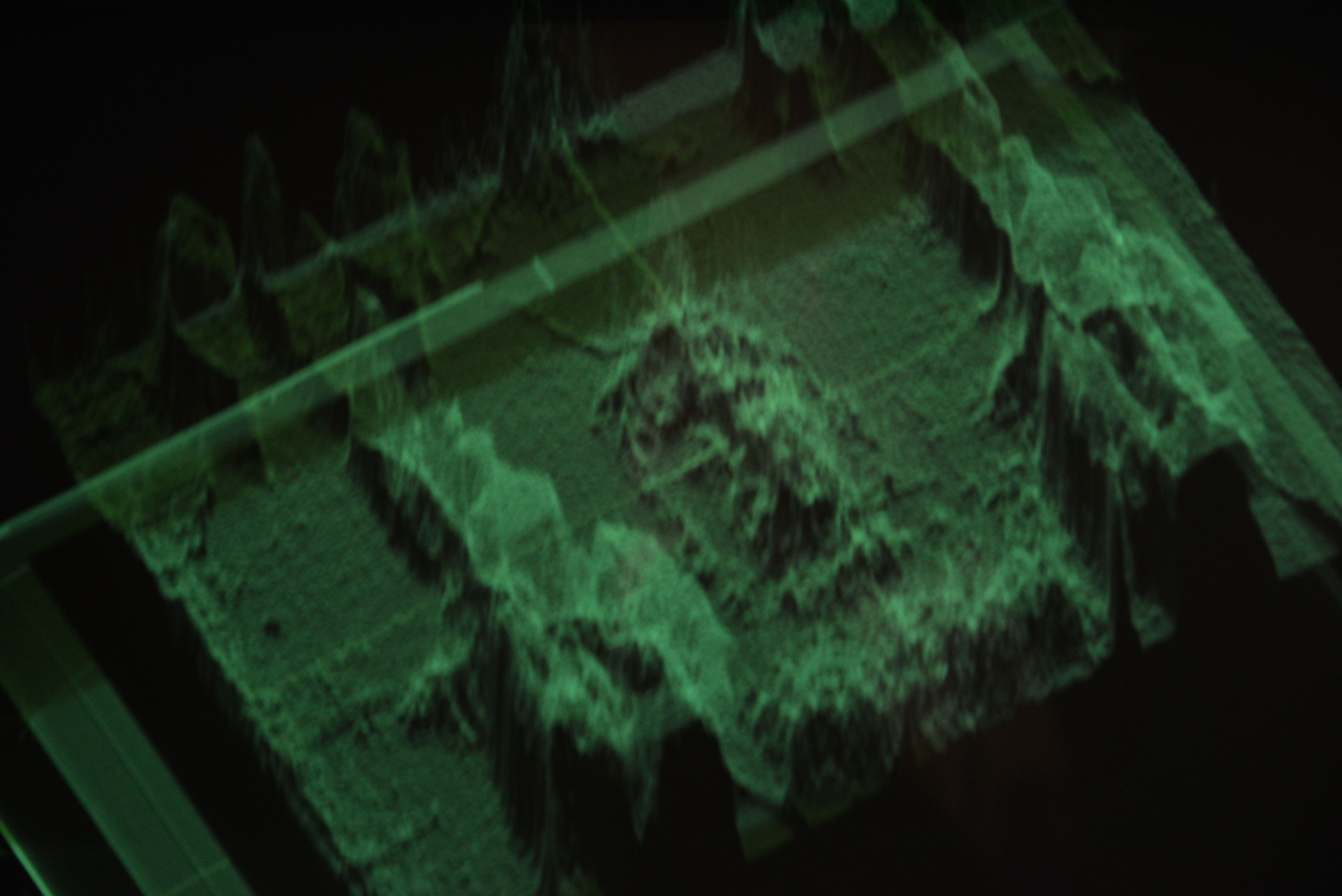
Photo O. VP8 Image Halo |
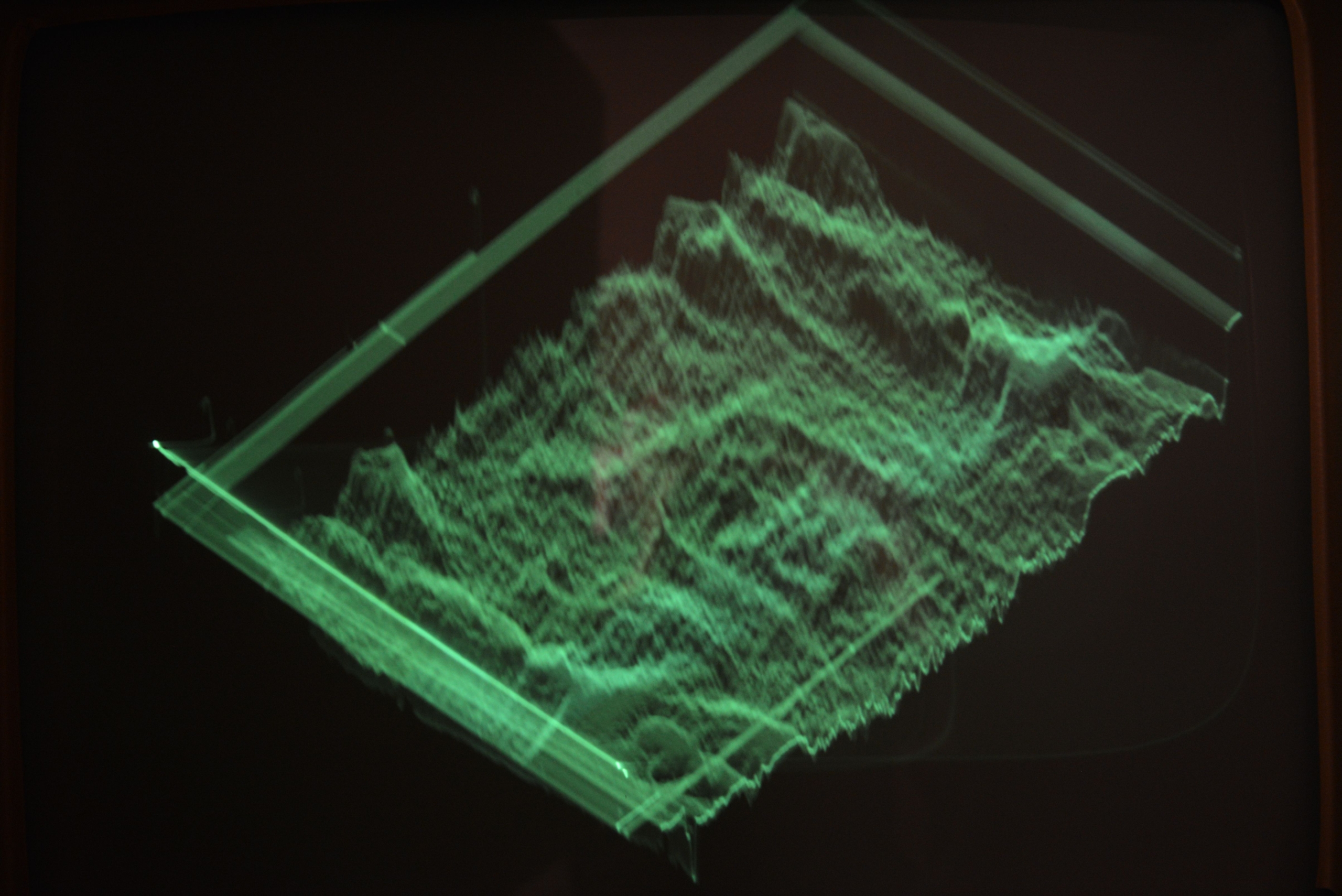
Photo I. VP8 Image Head |
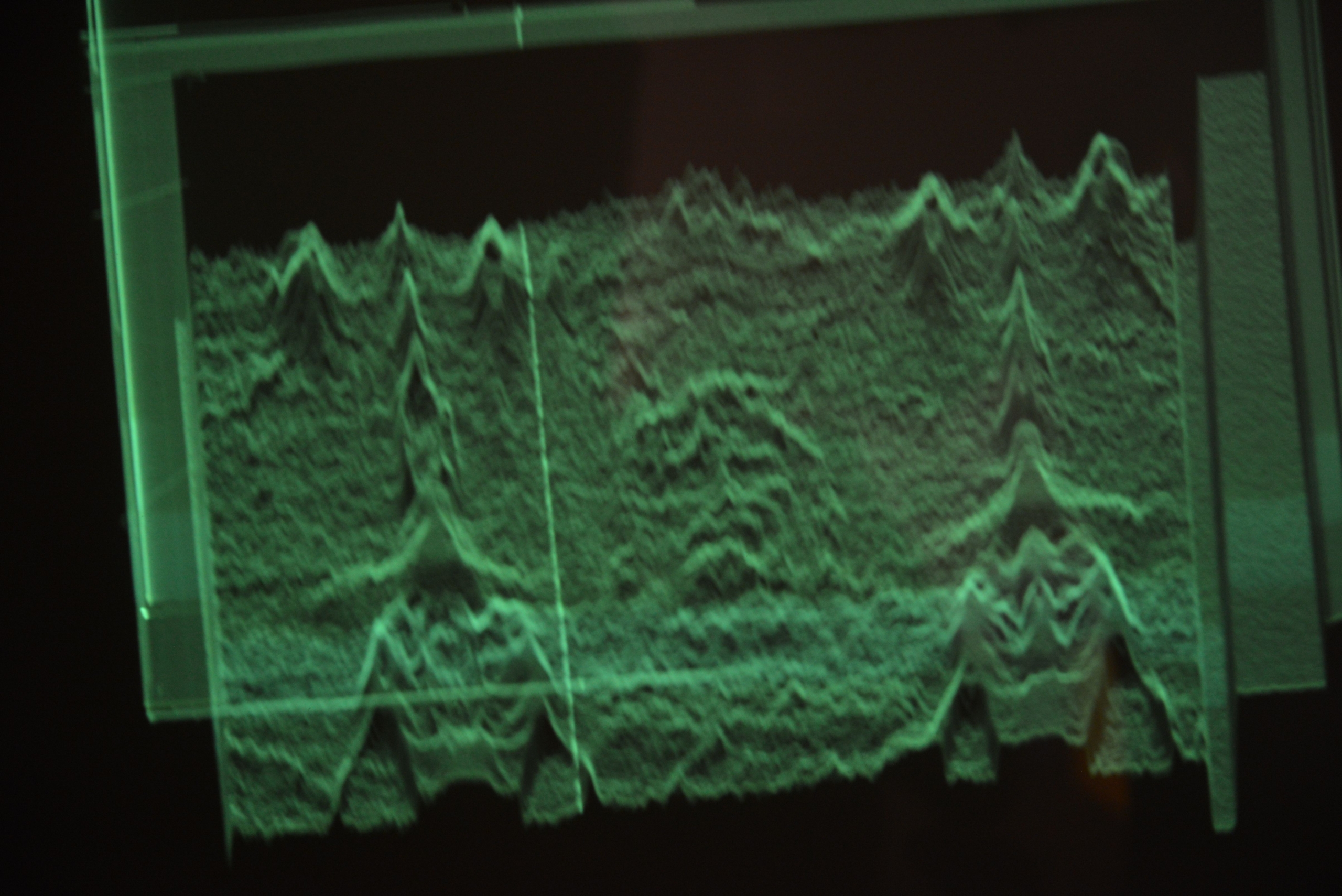
Photo K. VP8 Image Halo

Photo L. Relief HALO |
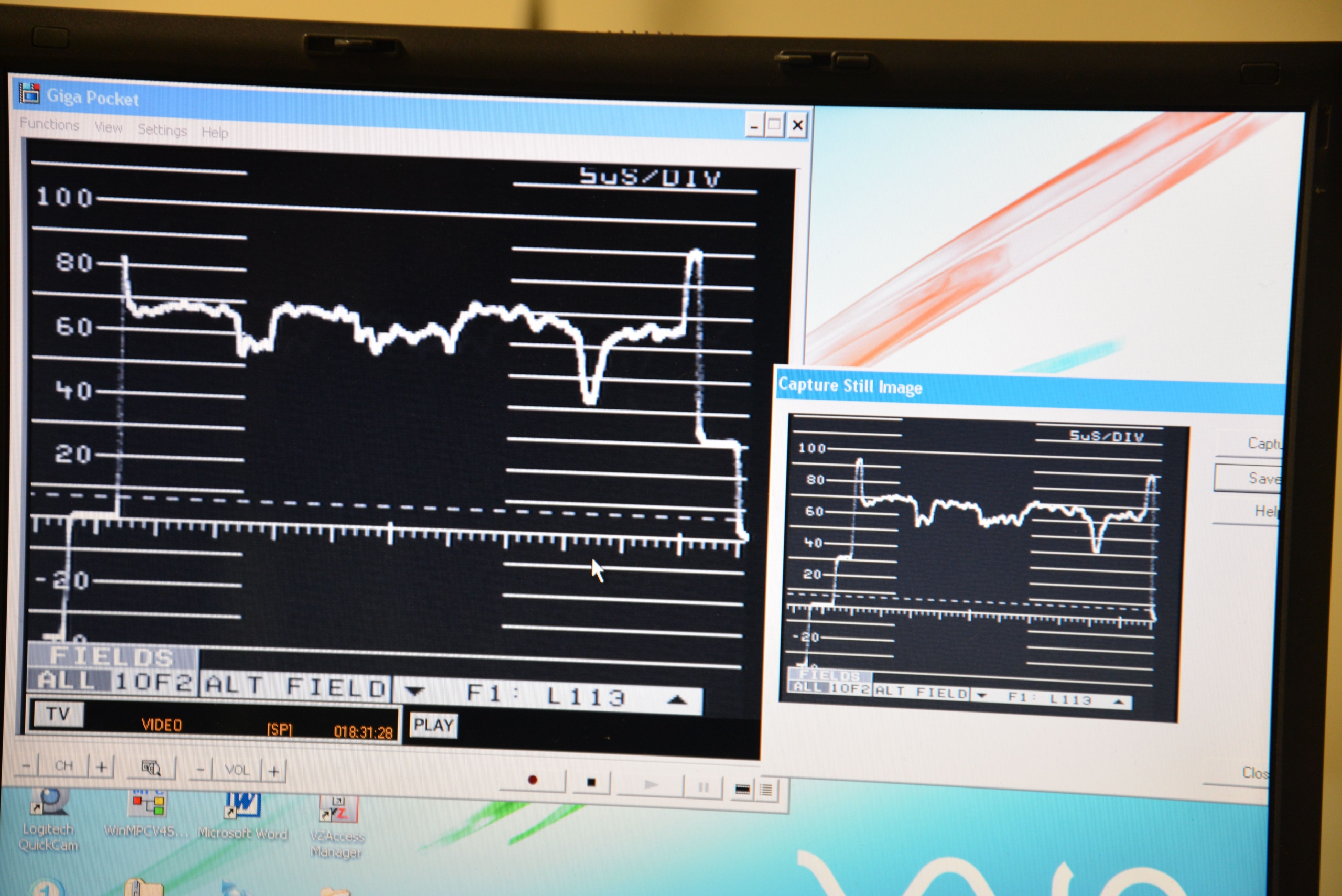
Photo J. Altitude graphic HALO |
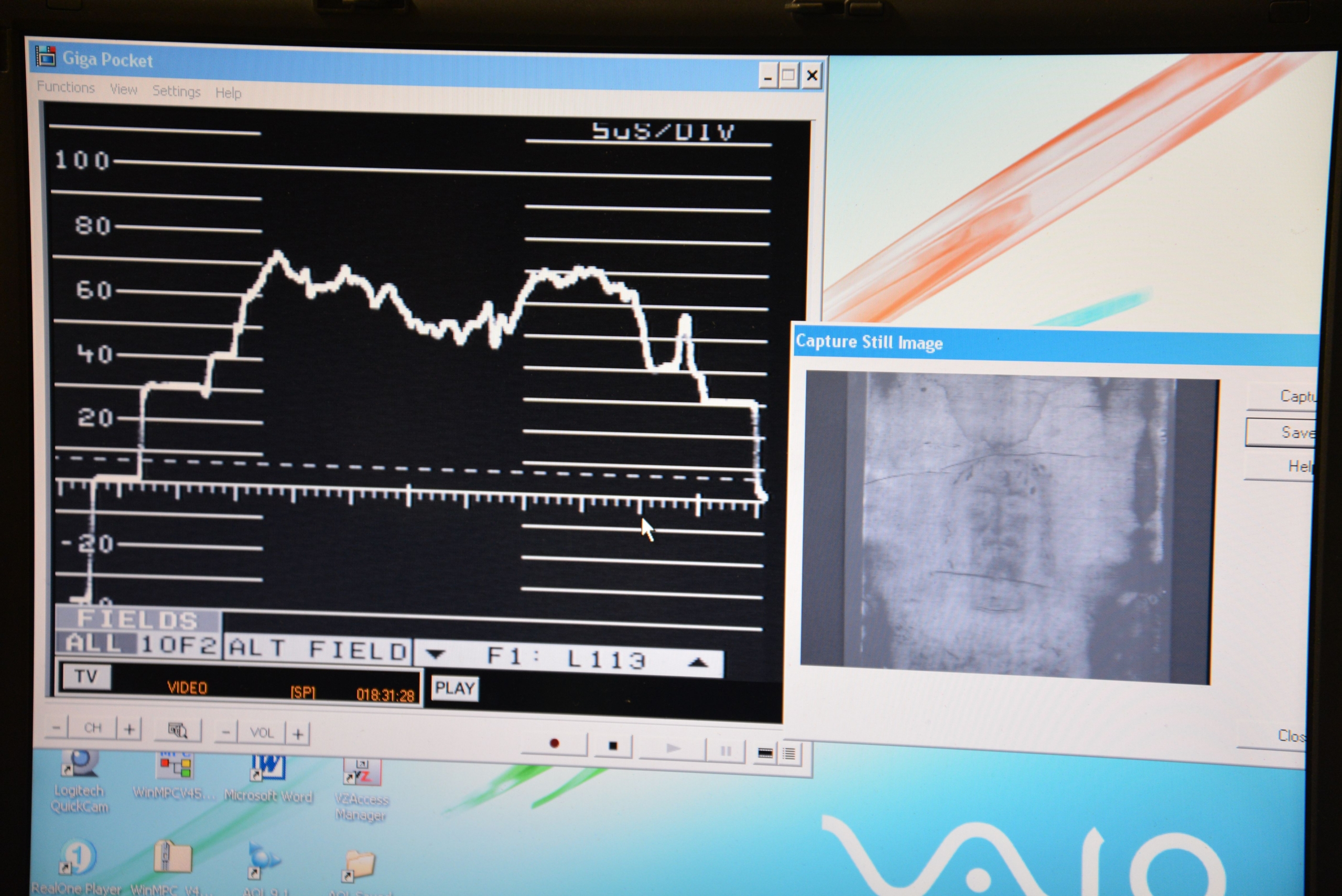
Photo P. Relief HALO
Photographs L, J, P are circular shading study
CONCLUSION:
“Using several Shroud images of different types and dates; various image analysis and measurement techniques; and, employing graphic overlays to compare extracted features to various artworks and Icons, it is my conclusion that the statements made by Dr. Soons are demonstrated to be accurate beyond reasonable doubt.
Thus, the Mandylion and the Shroud of Turin are one and the same. Therefore, the Shroud of Turin existed at a time in accord with the known history of the Mandylion.
I defer to the considered works of Ian Wilson and other accomplished historians as to the impact of the results of this study, as I am not a historian.
While it is true that not everyone has a VP8 Image Analyzer system available to them
and, while they may not have all the images available to them that I used in this study, I am convinced that this evidence is conclusive and can be readily duplicated by anyone reasonably capable in the disciplines applied while using a variety of easily accessible tools and even some readily accessible images.
@ 2014 Schumacher Soons All Rights Reserved
You can see the work done by Dr. Soons, that led to this research of Pete Schumacher, in his POWERPOINT presentation in chapter 6.5.2 following this article. The text in 6.5.1 is the text that comes with this presentation.
*To return close tab
Click to see HALO PETE Powerpoint CIRCULAR SHADING STUDY
*To return close tab
DR. PETER SOONS PRESENTATION OF HALO IN ALAMOGORDO
